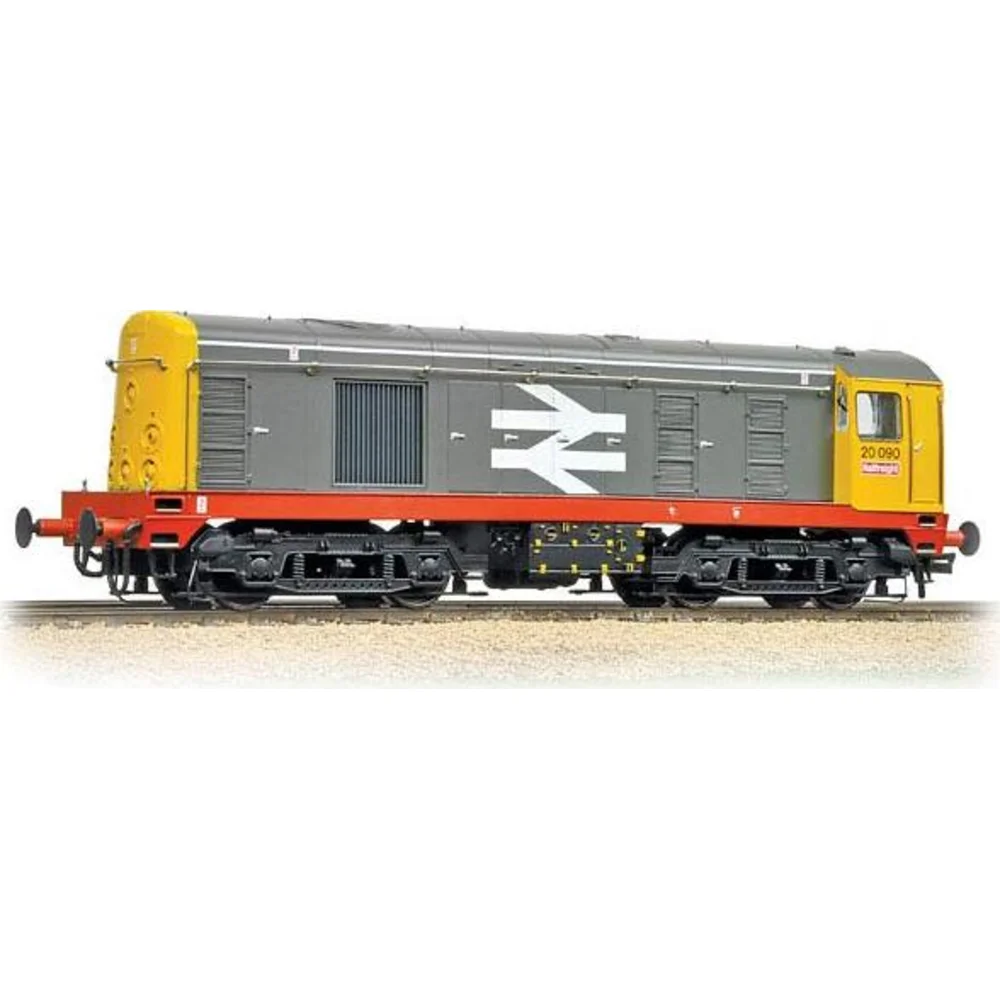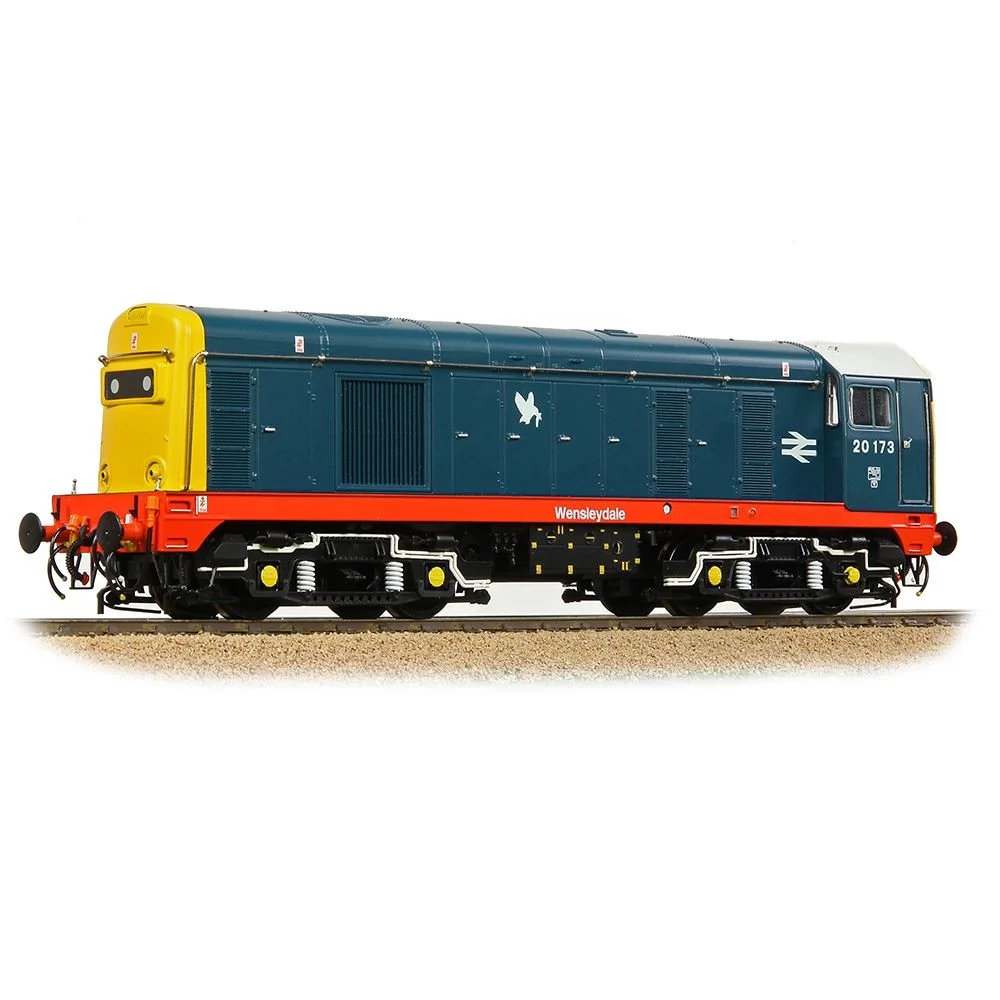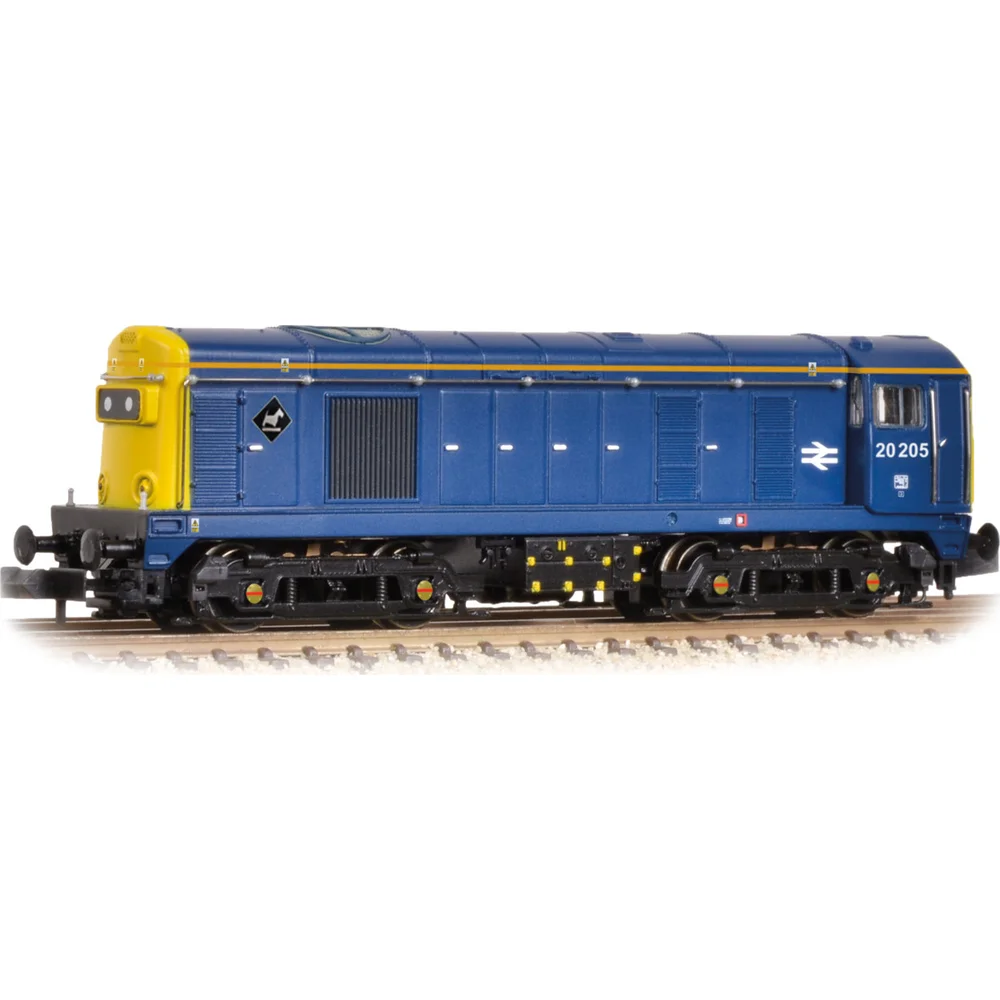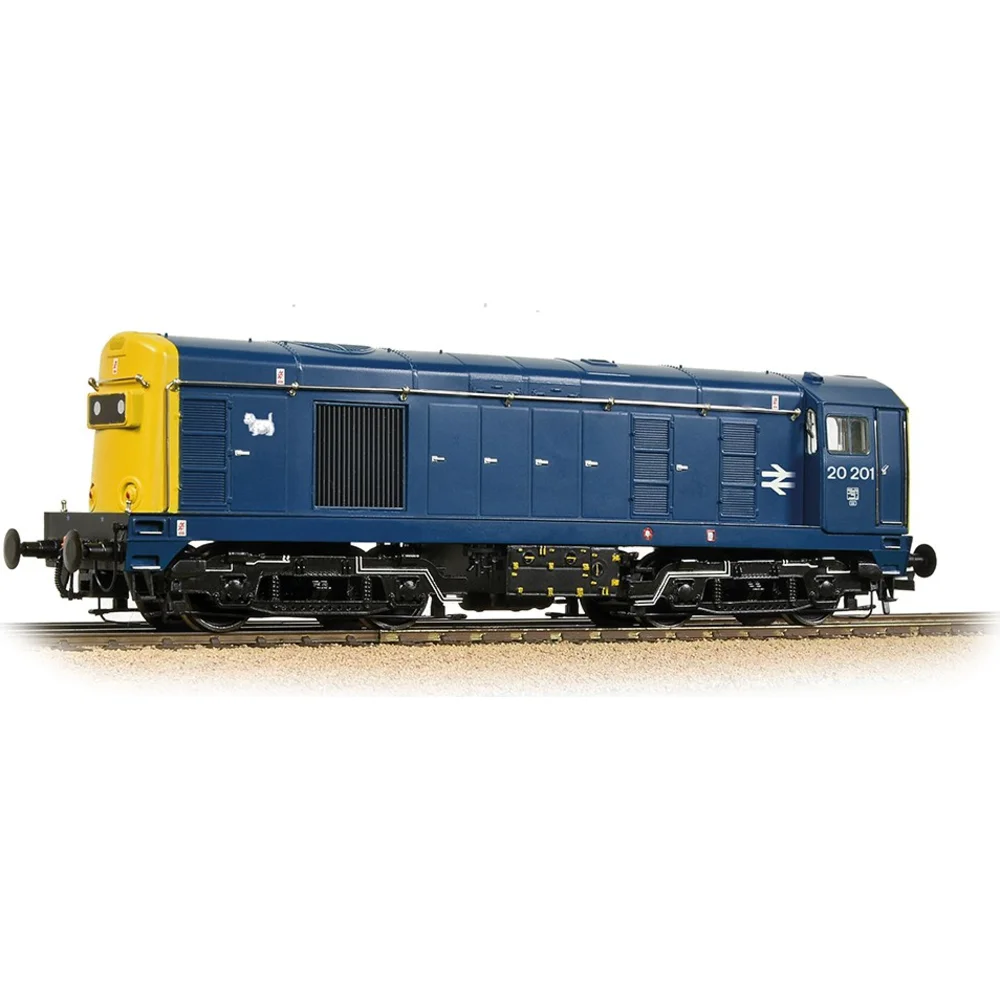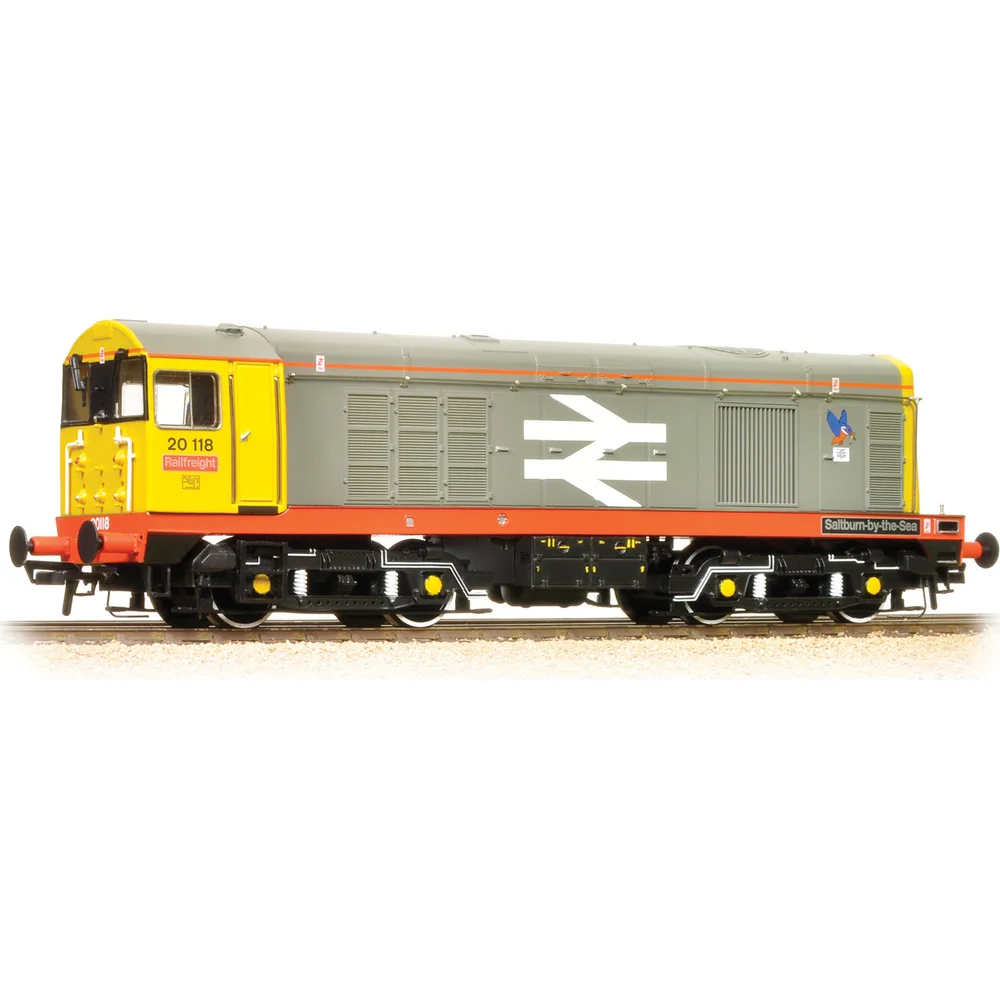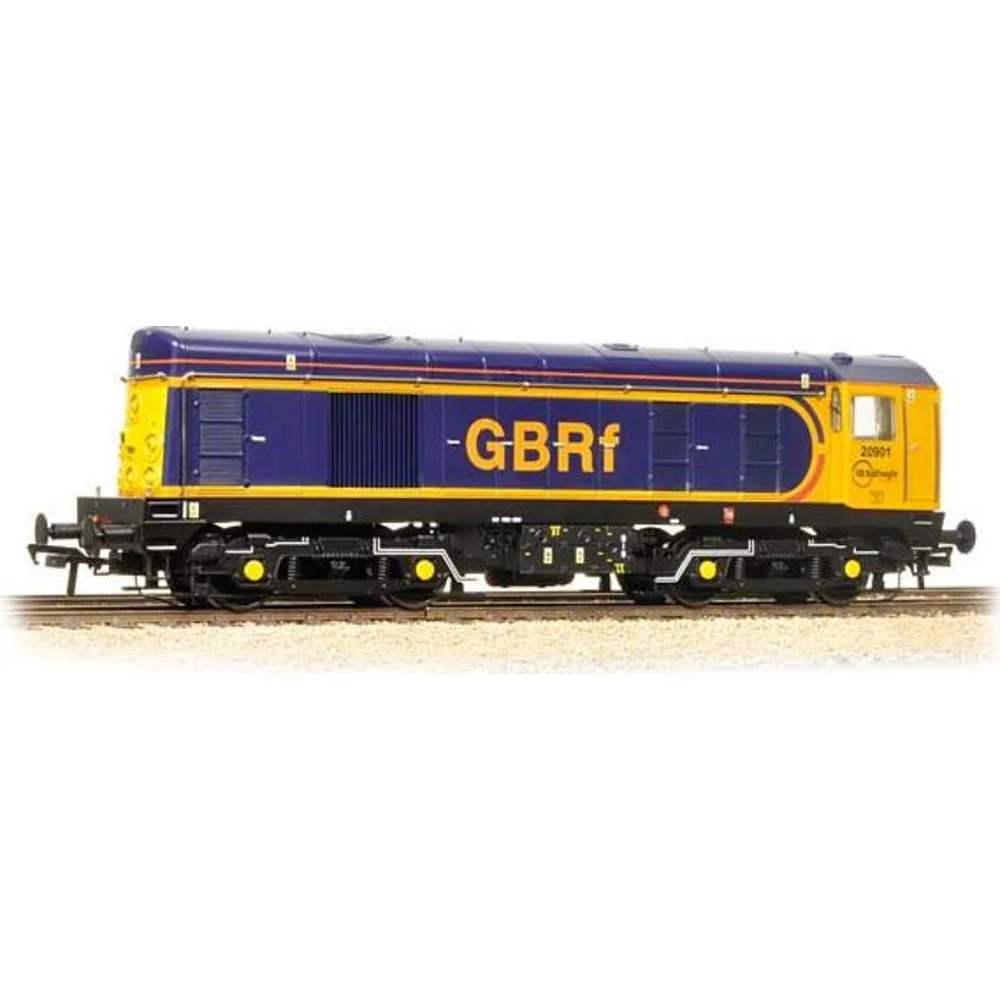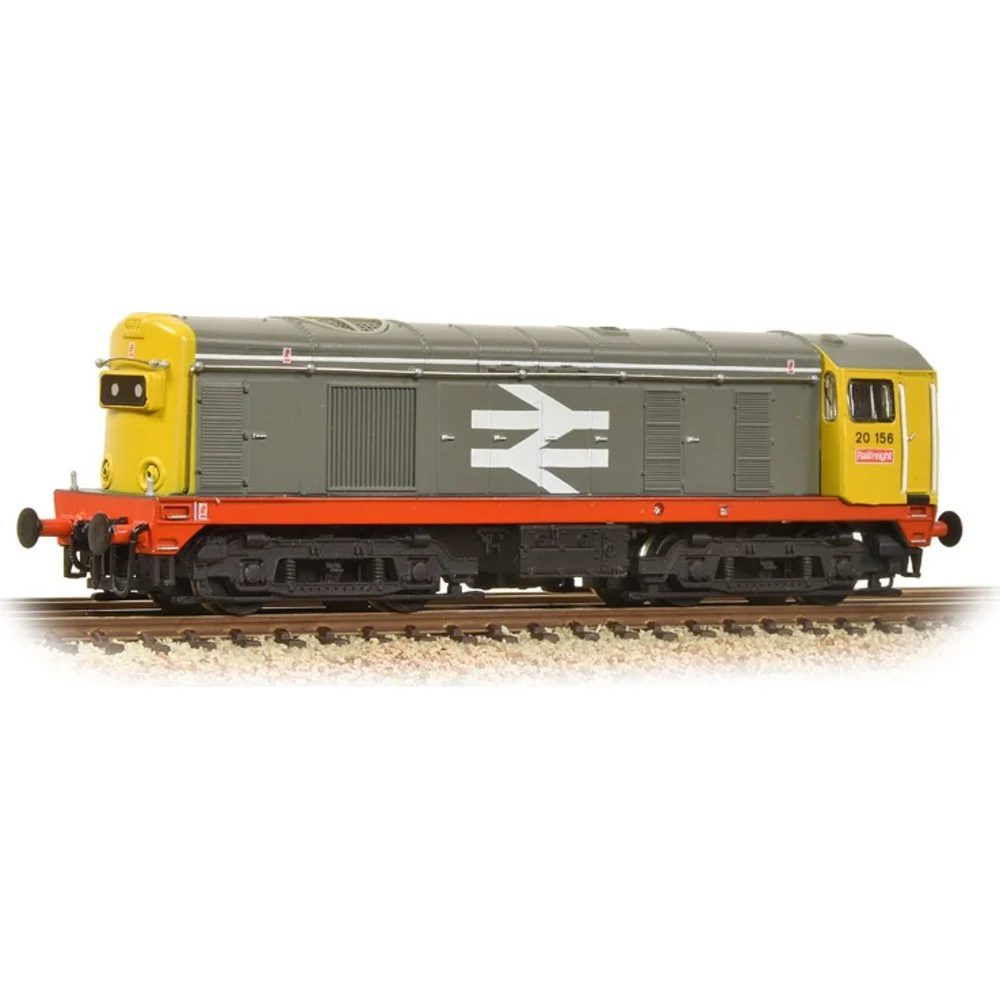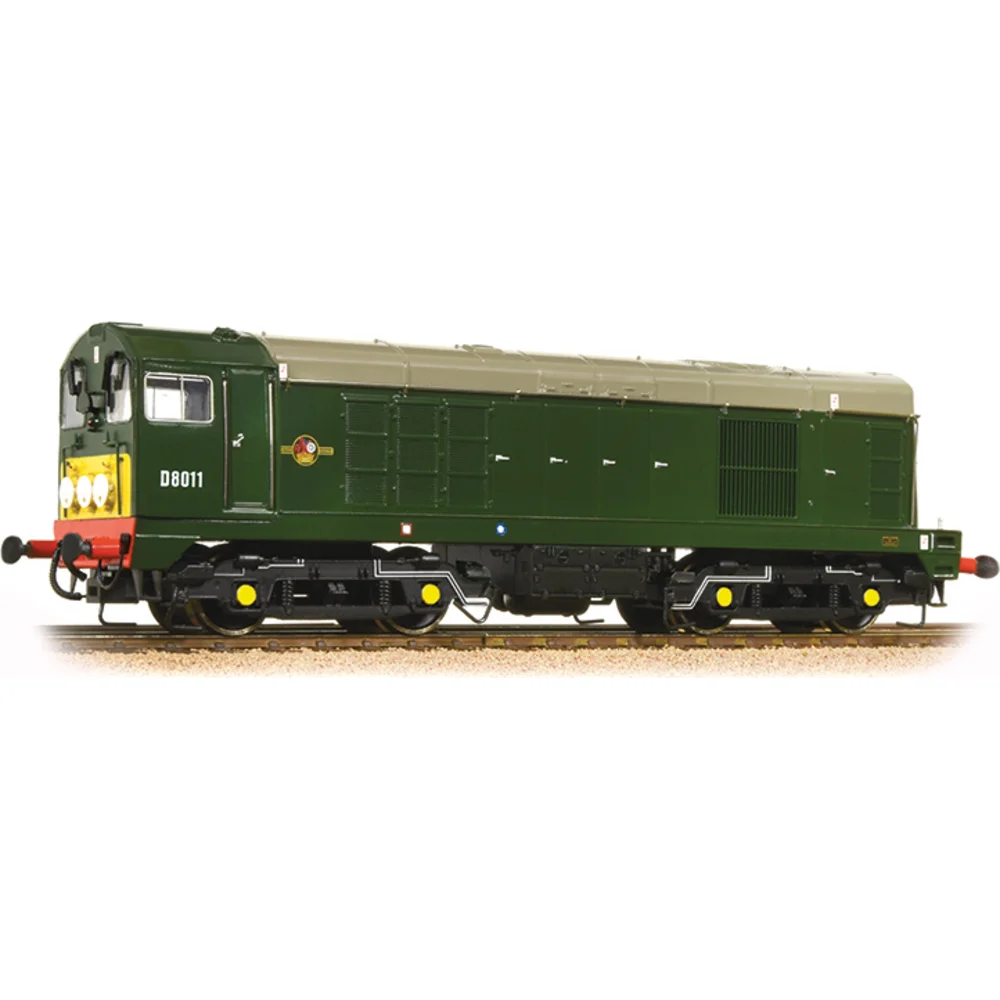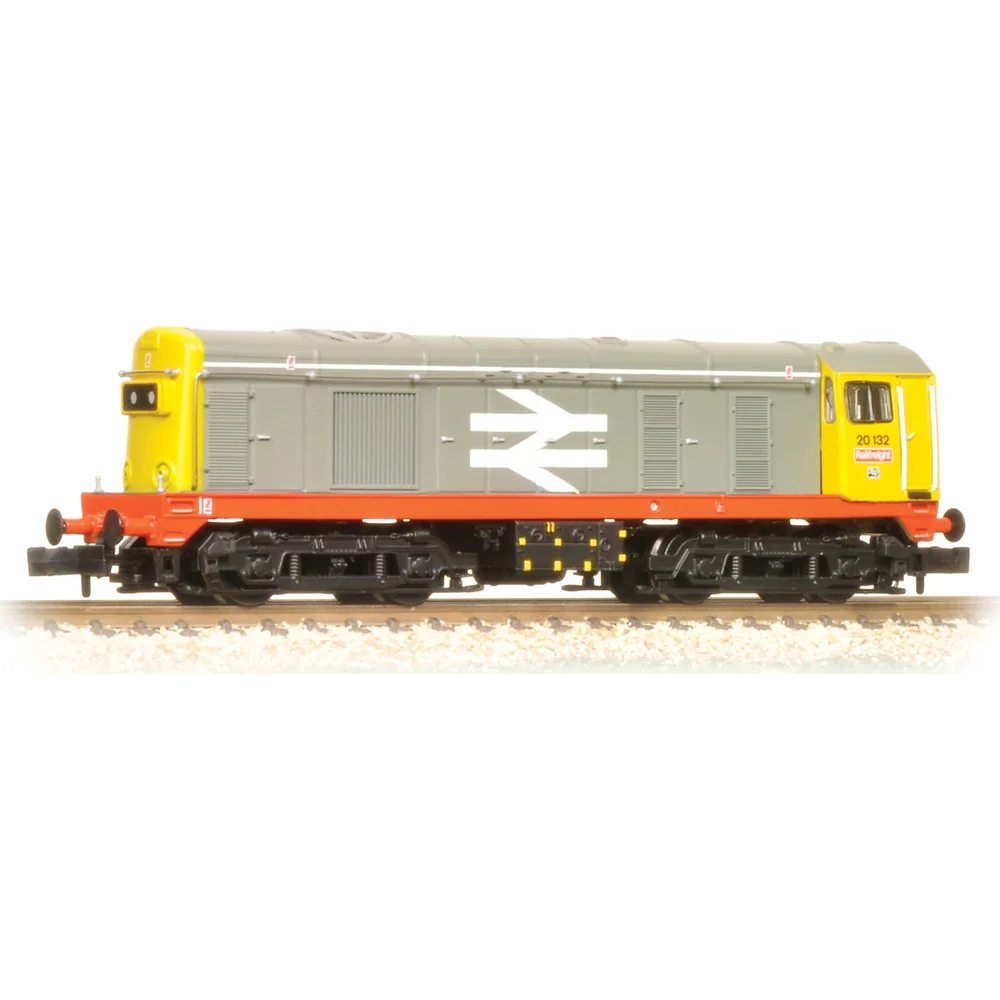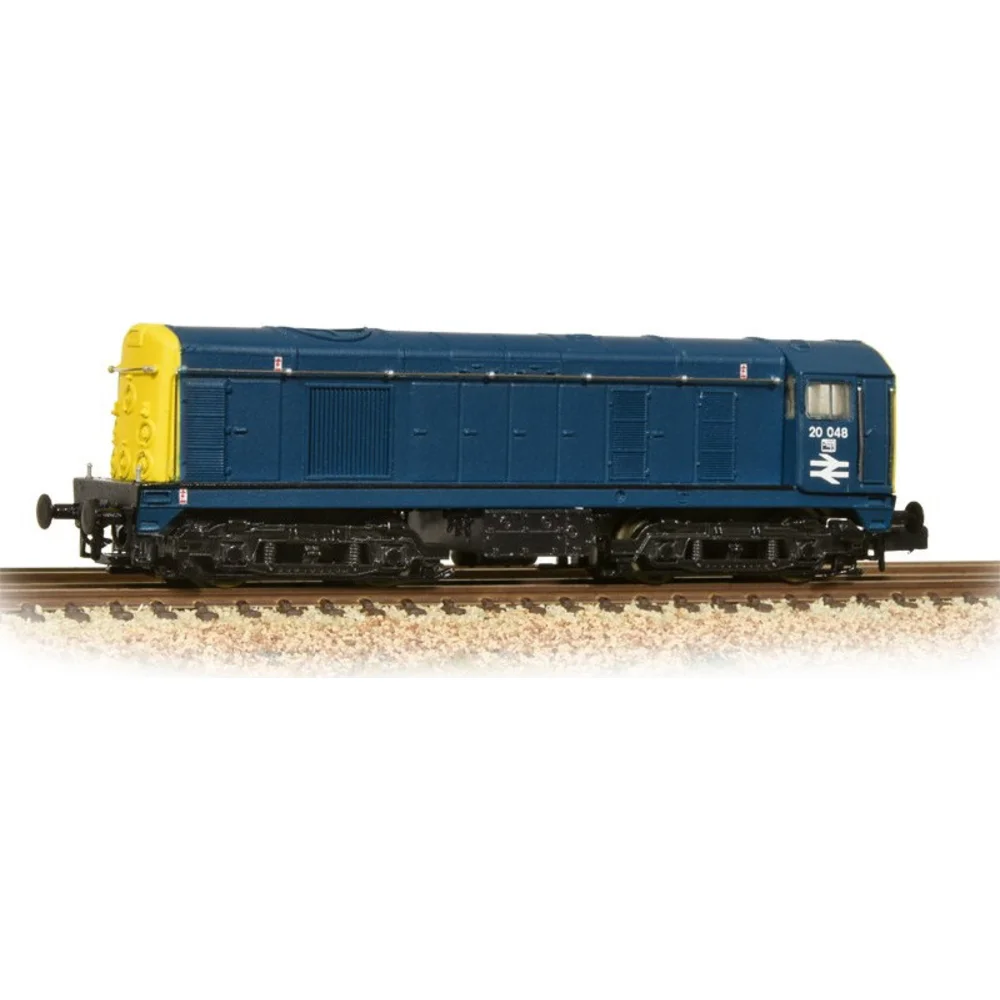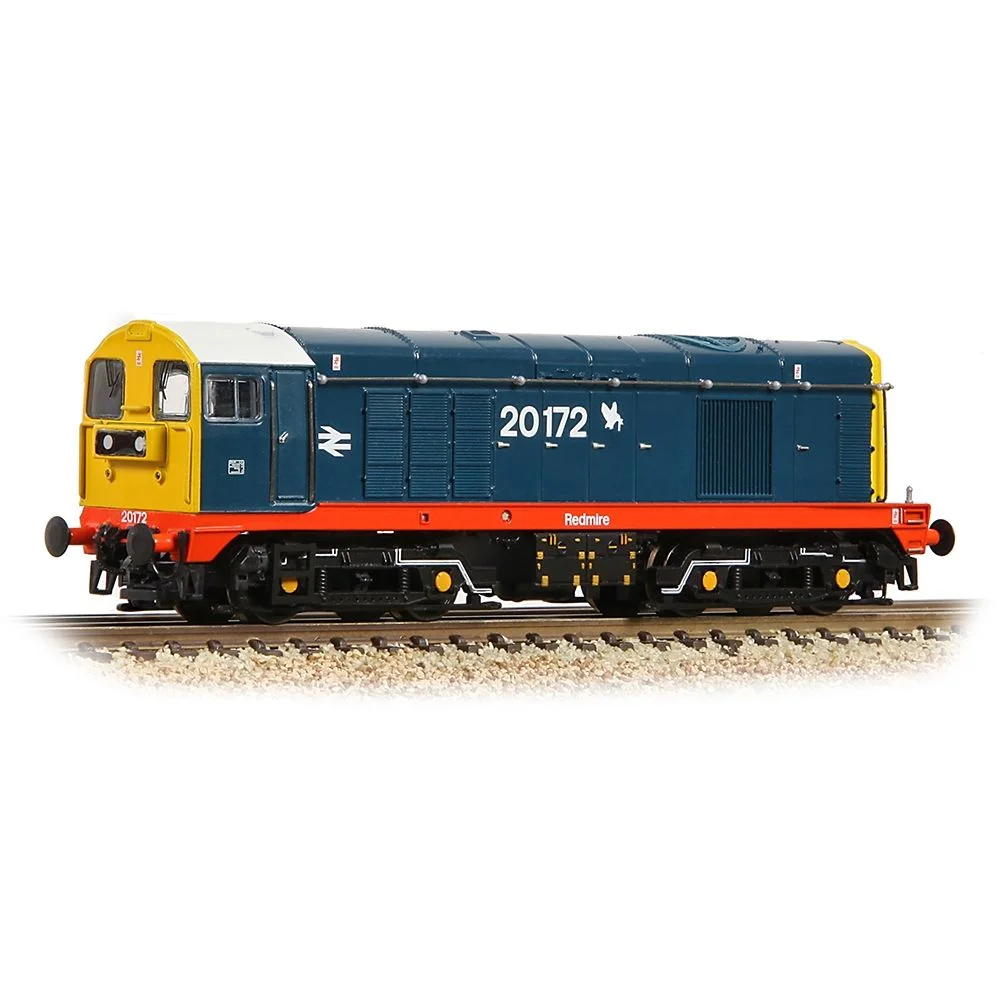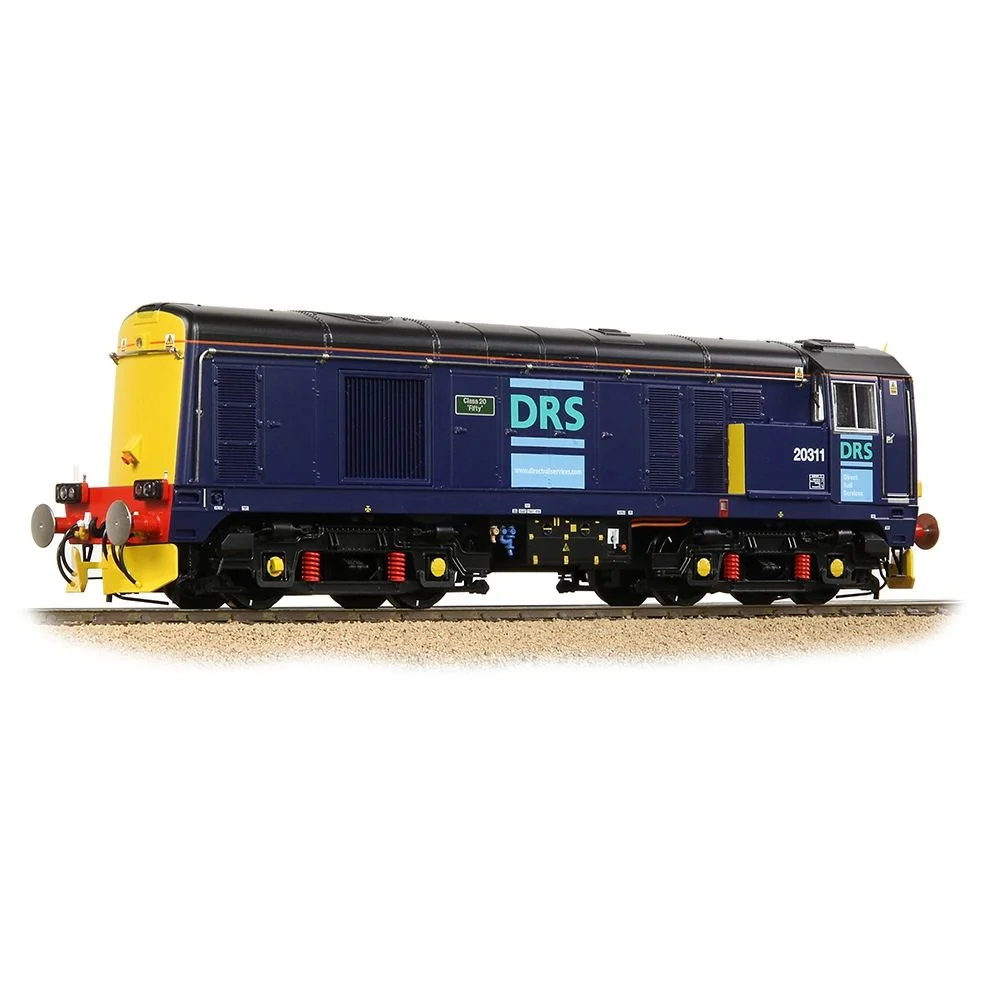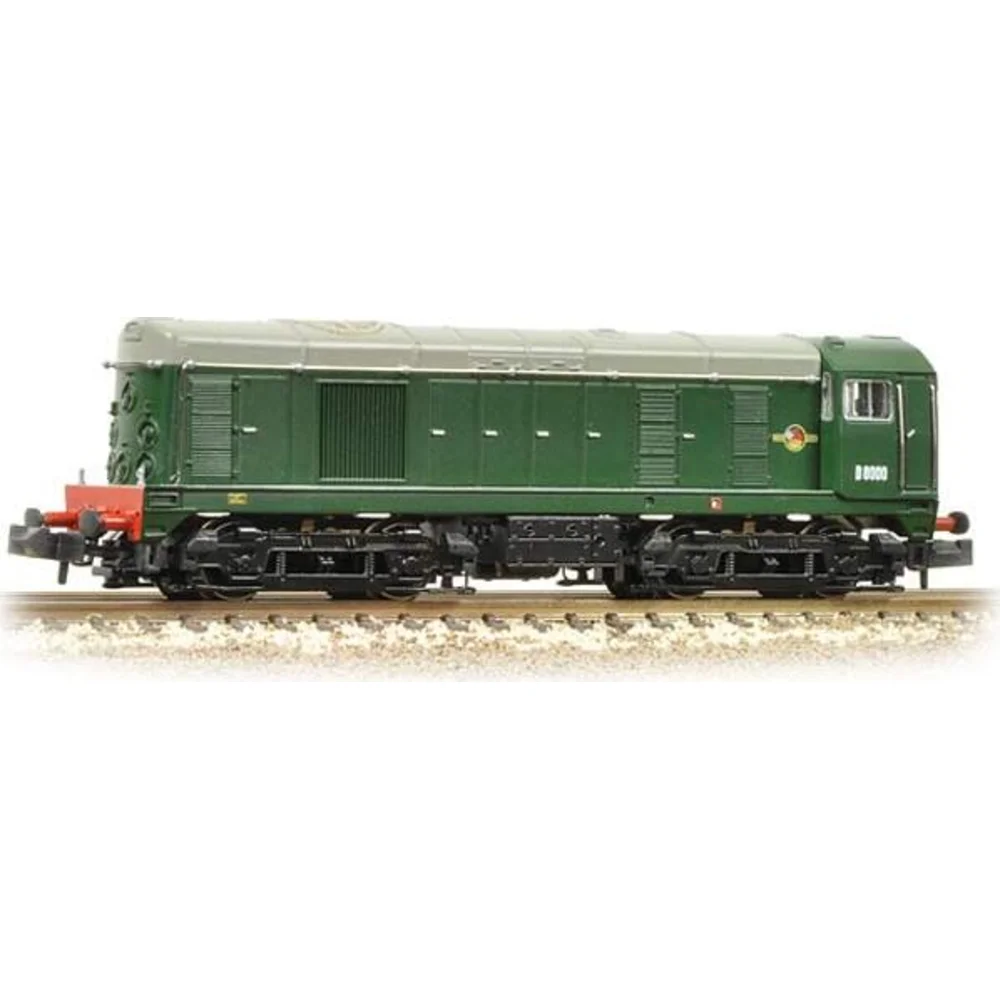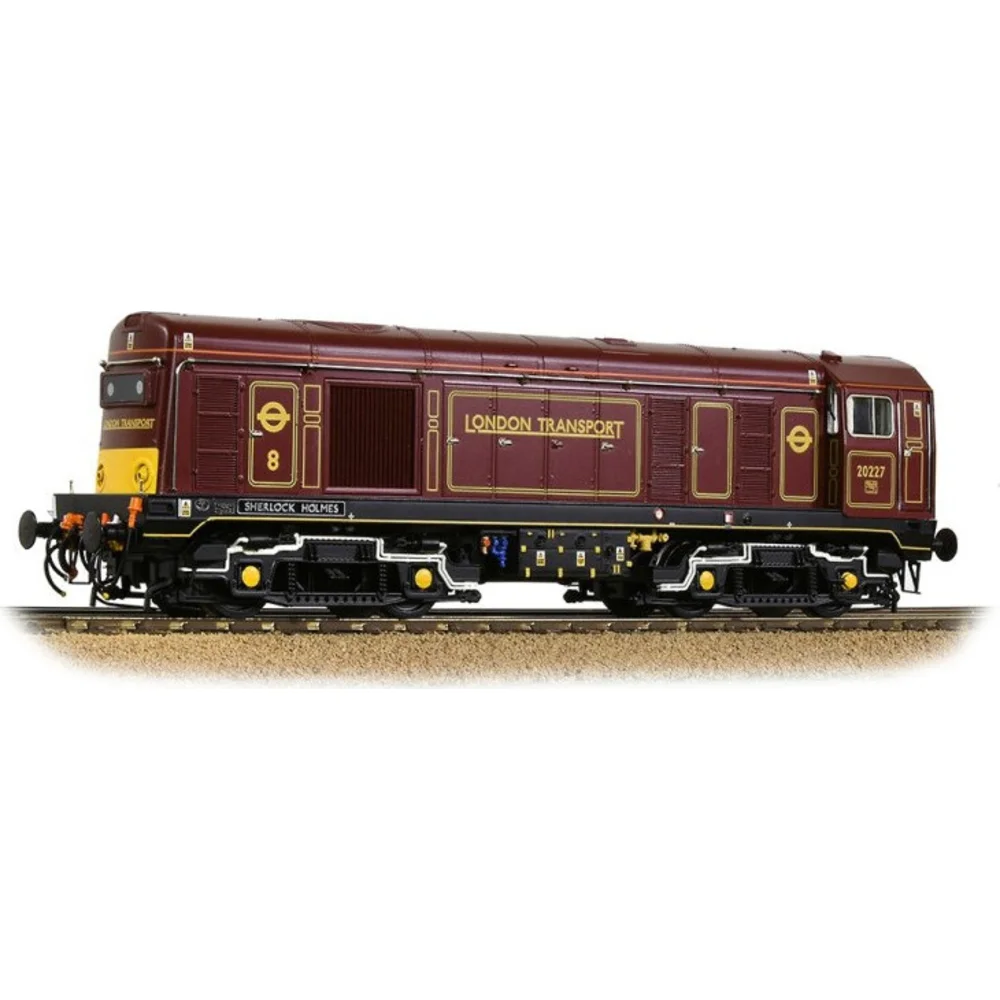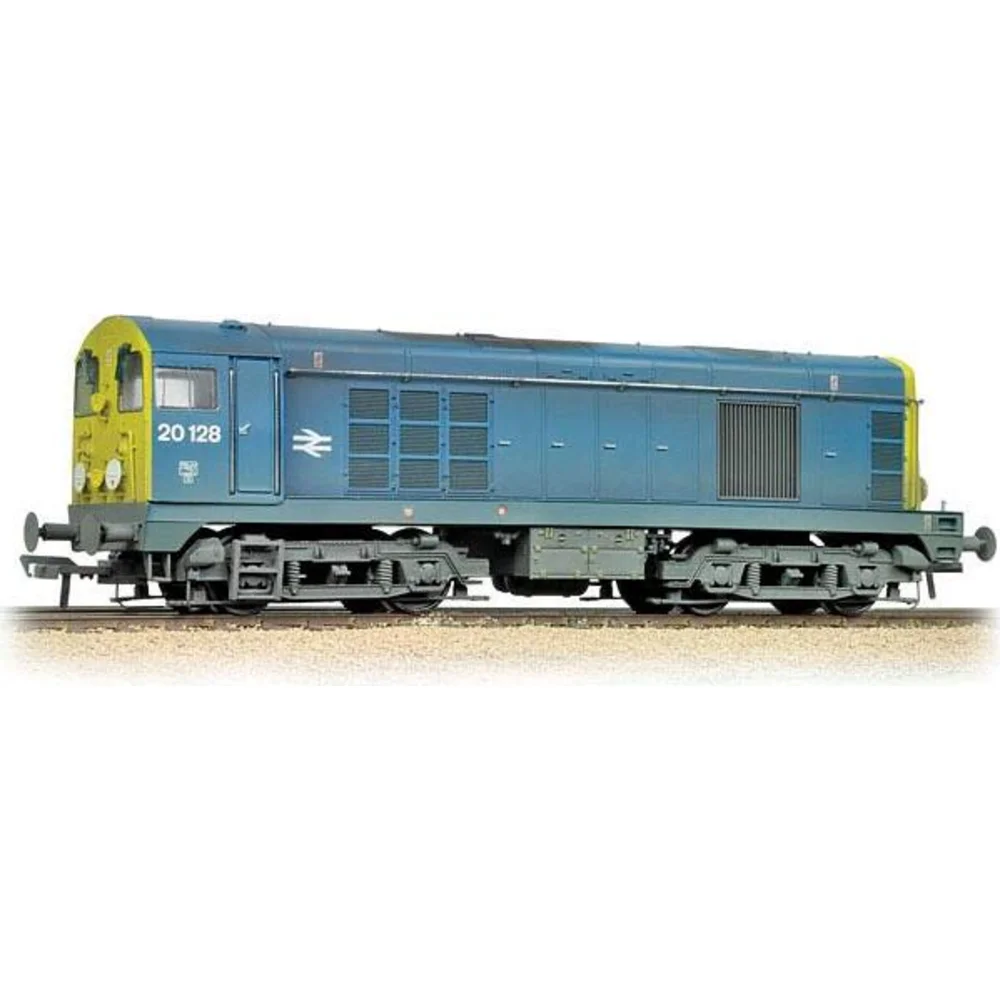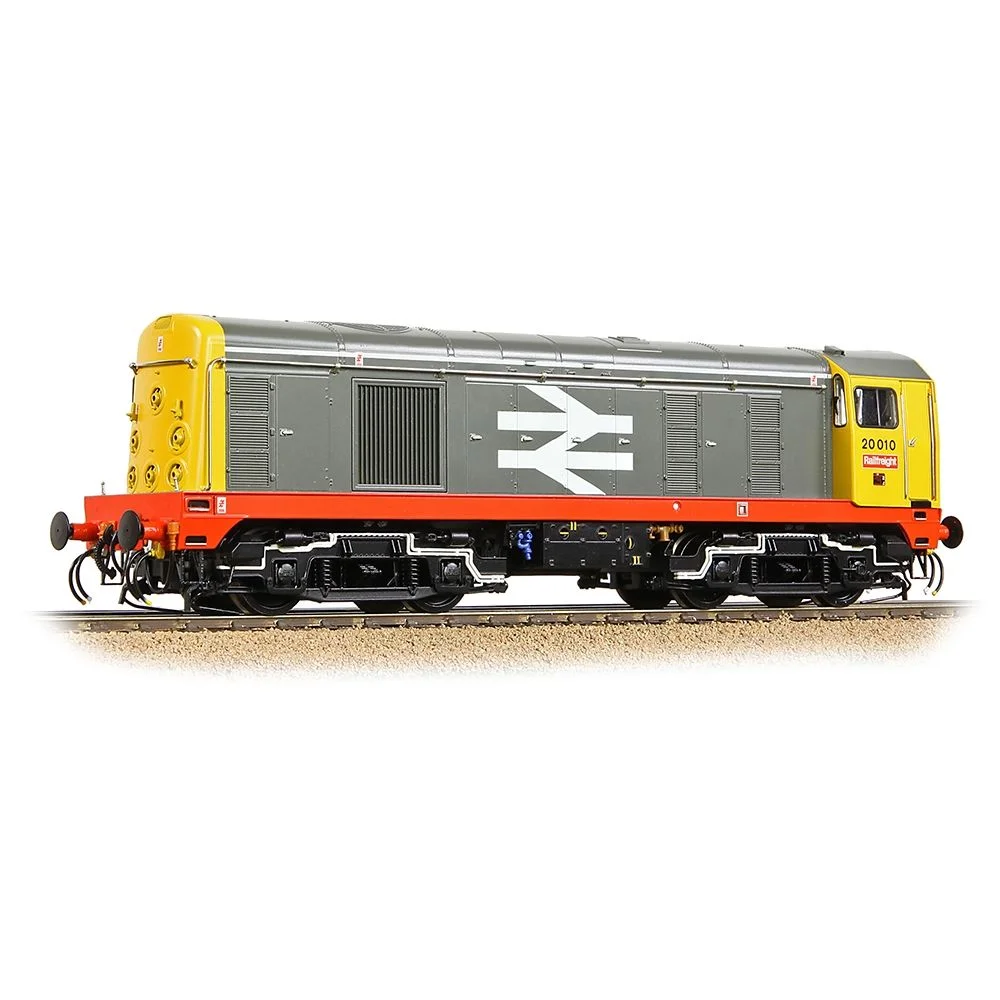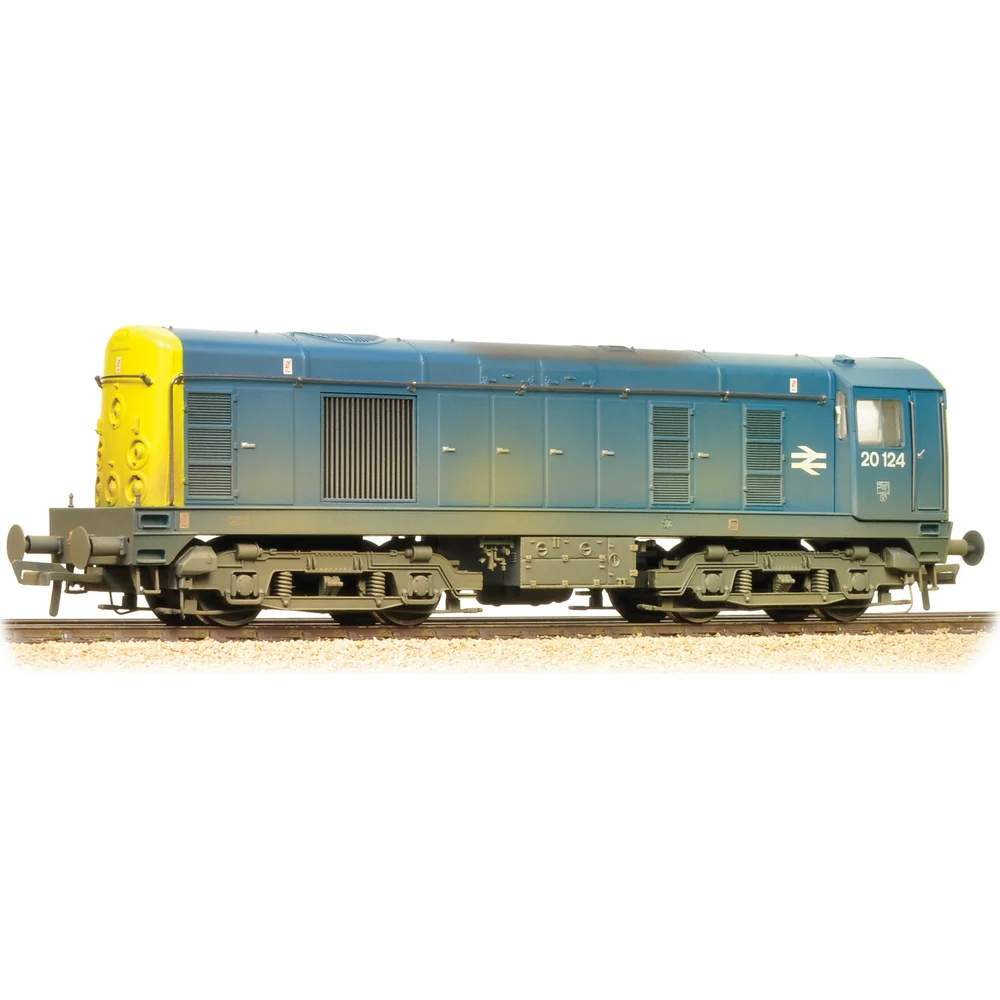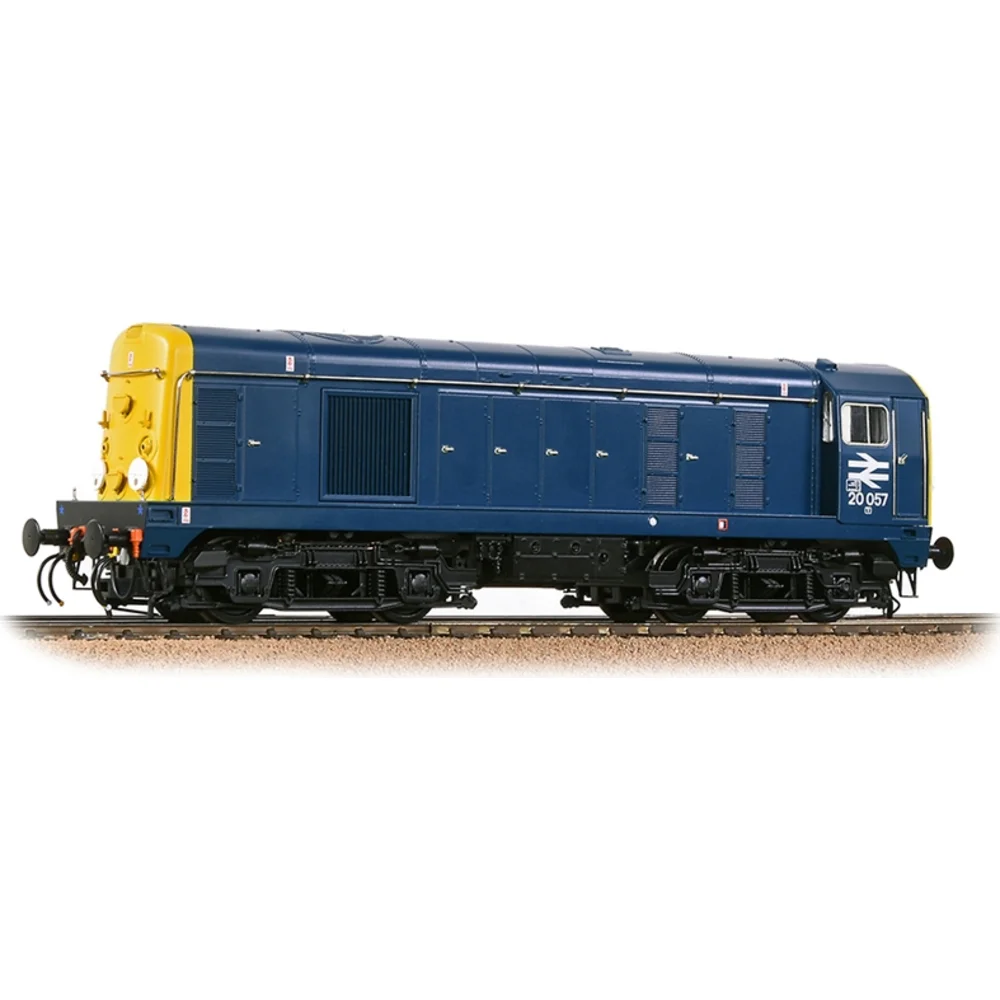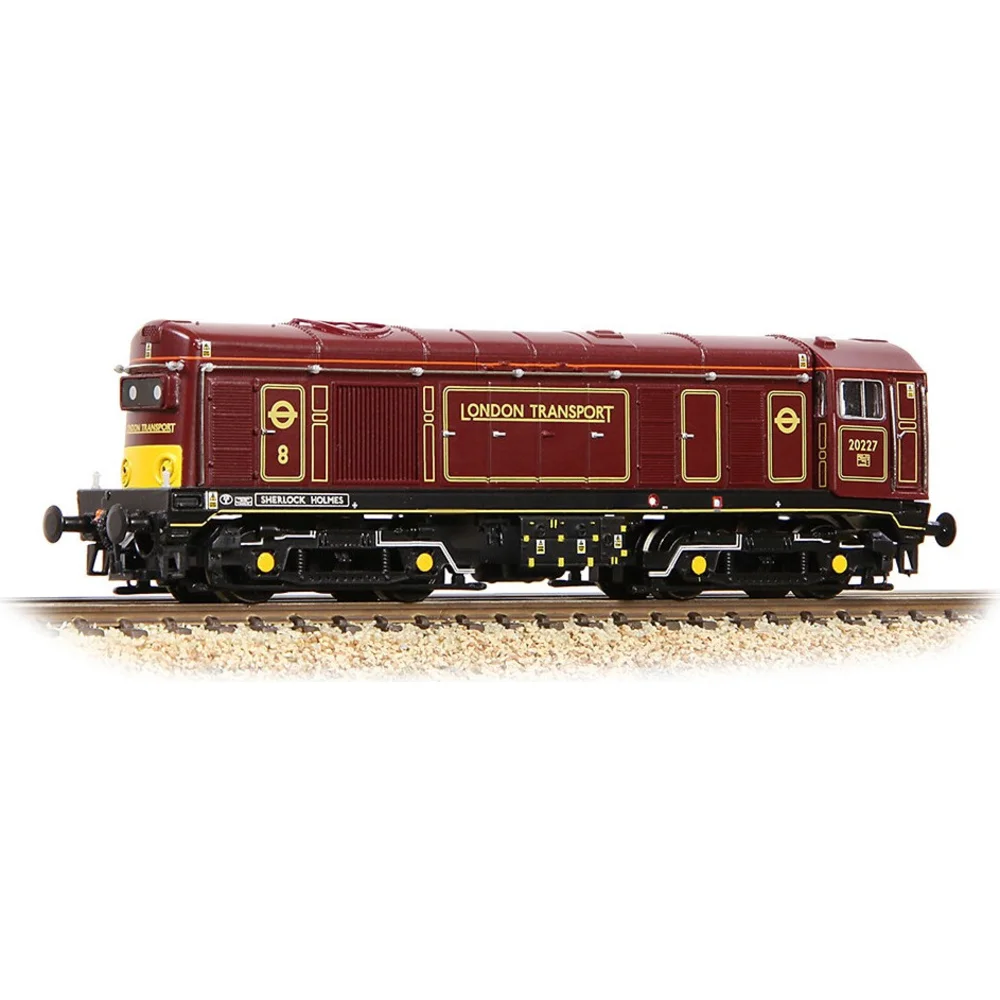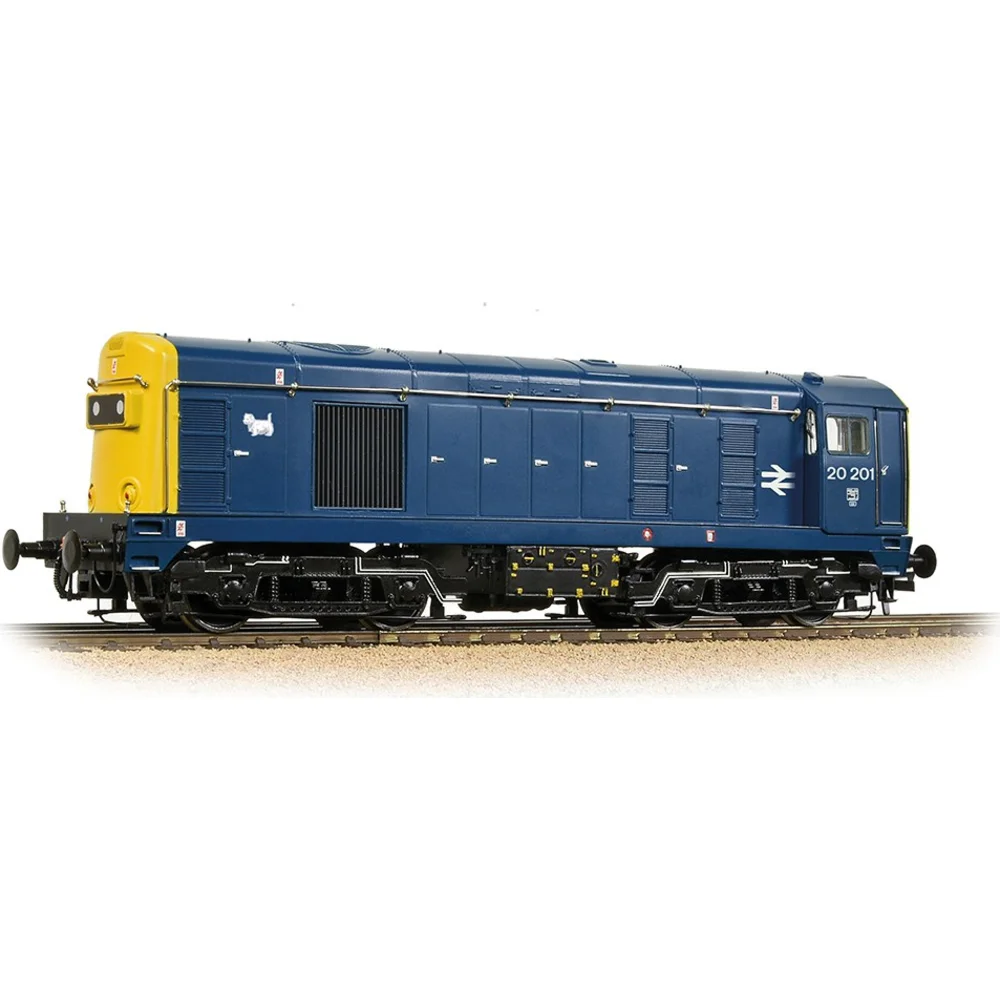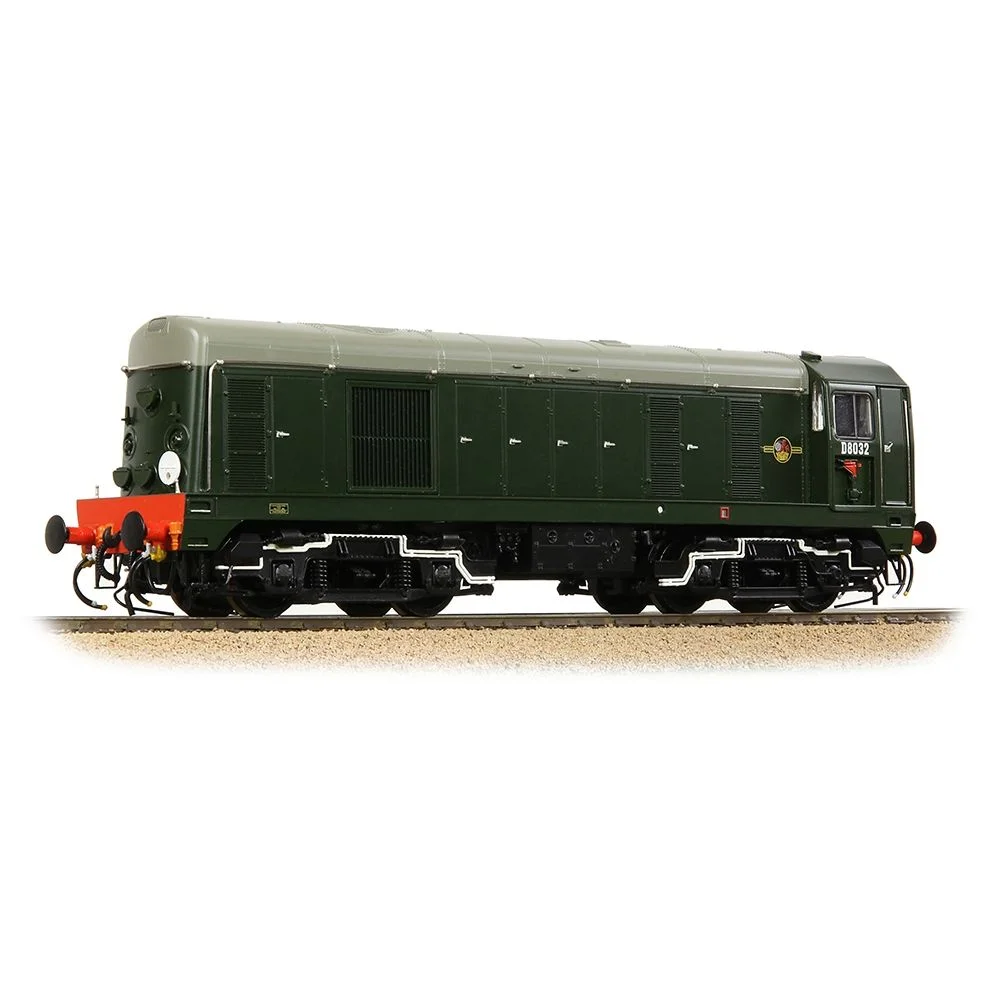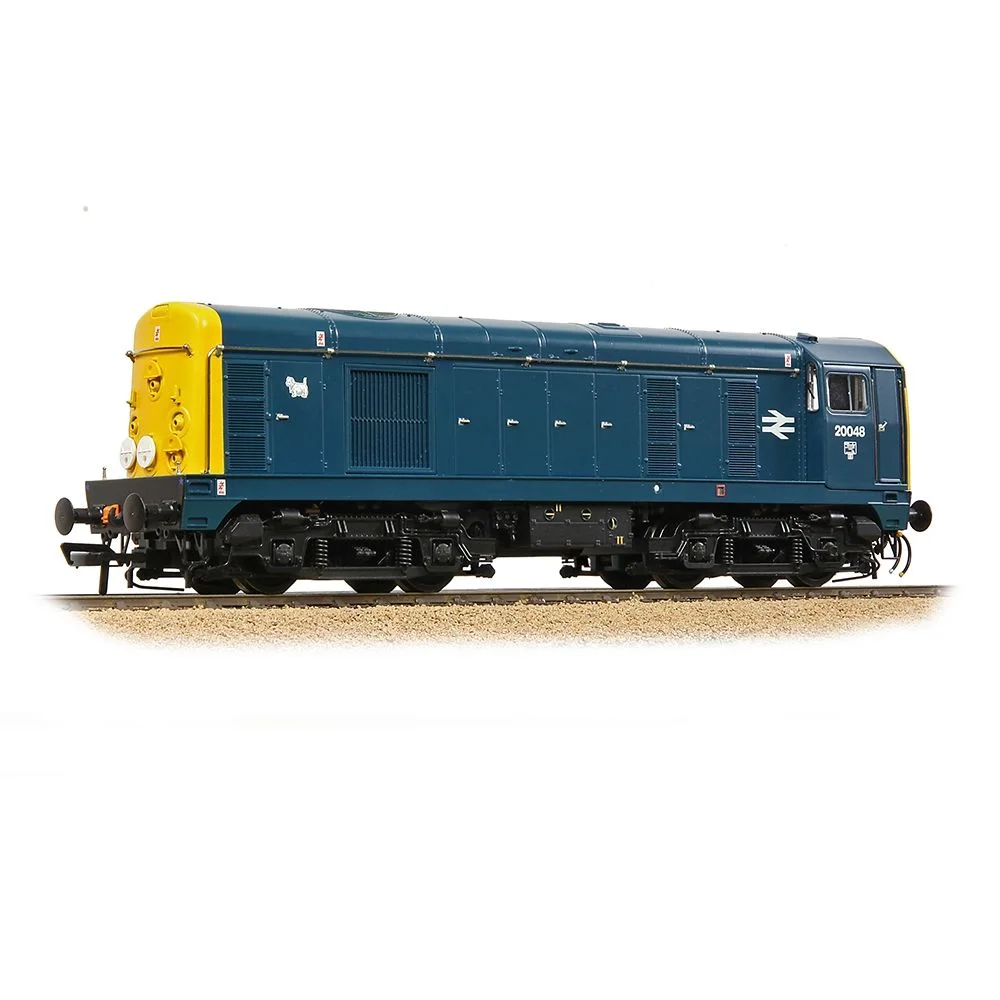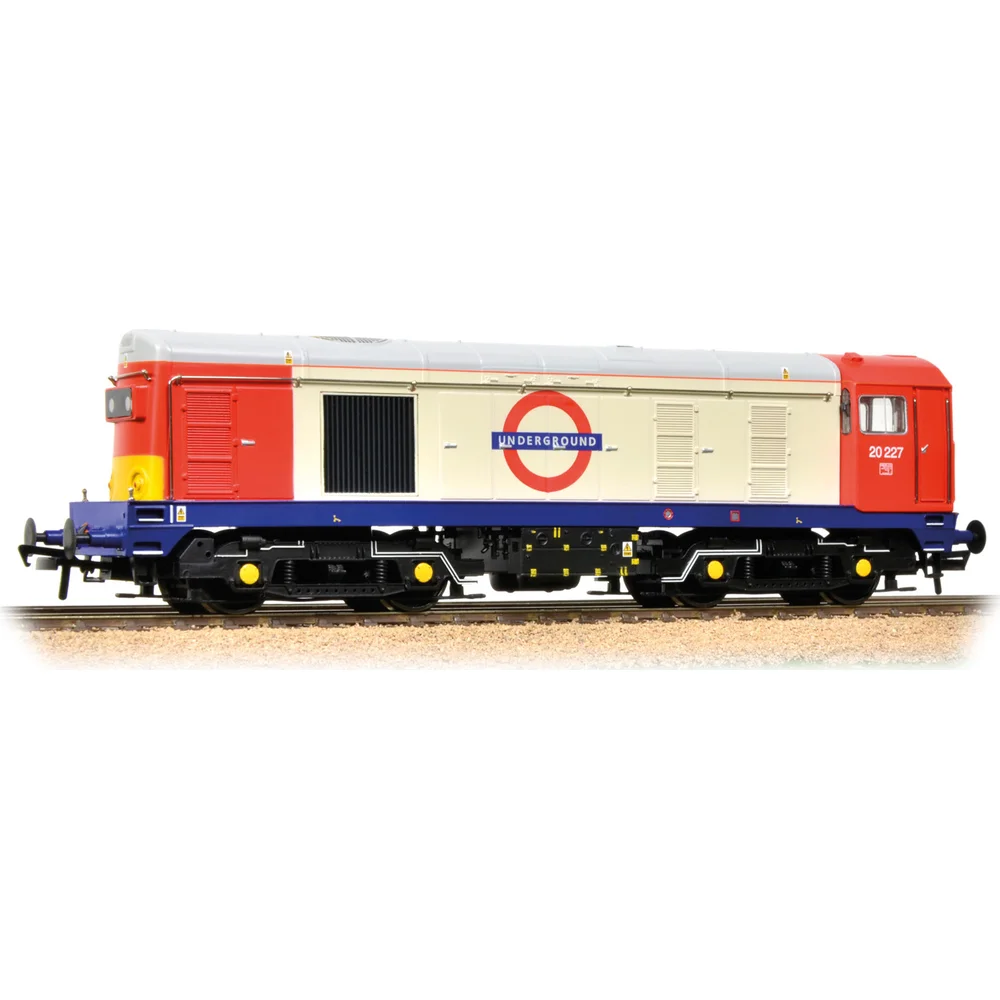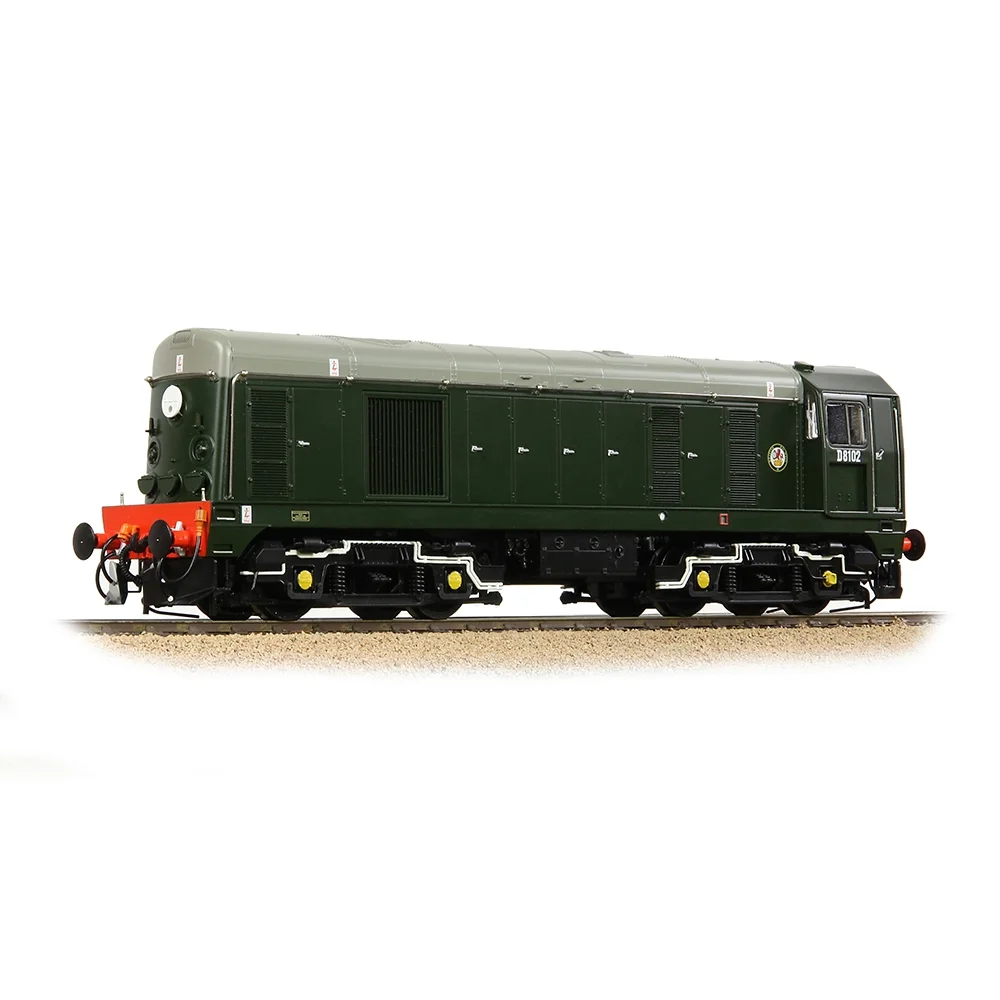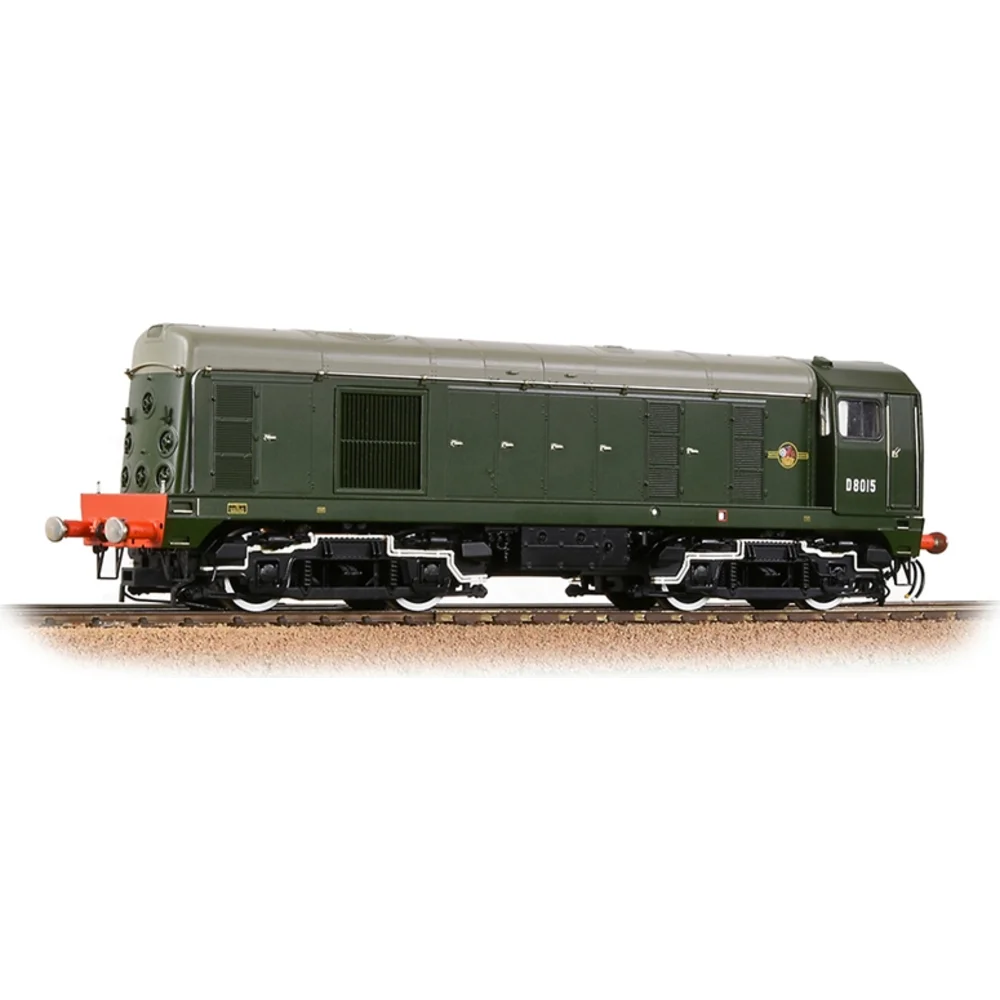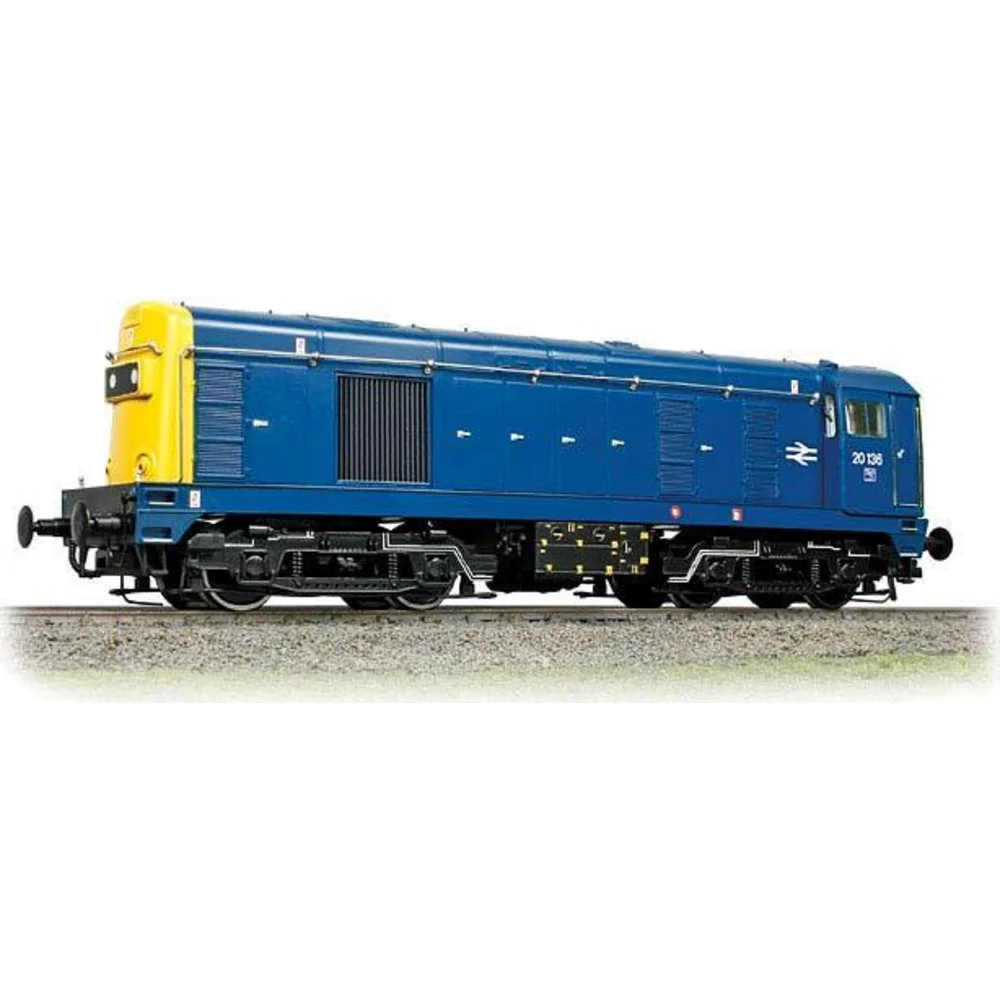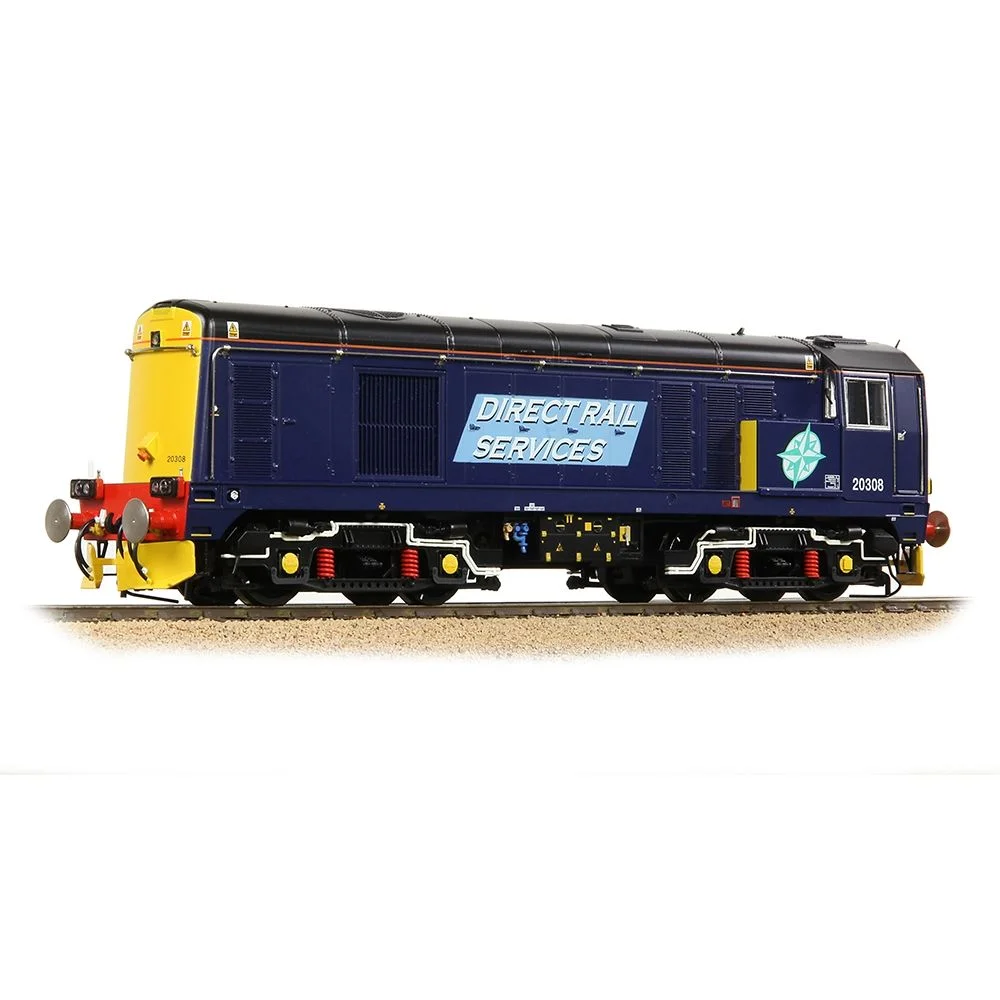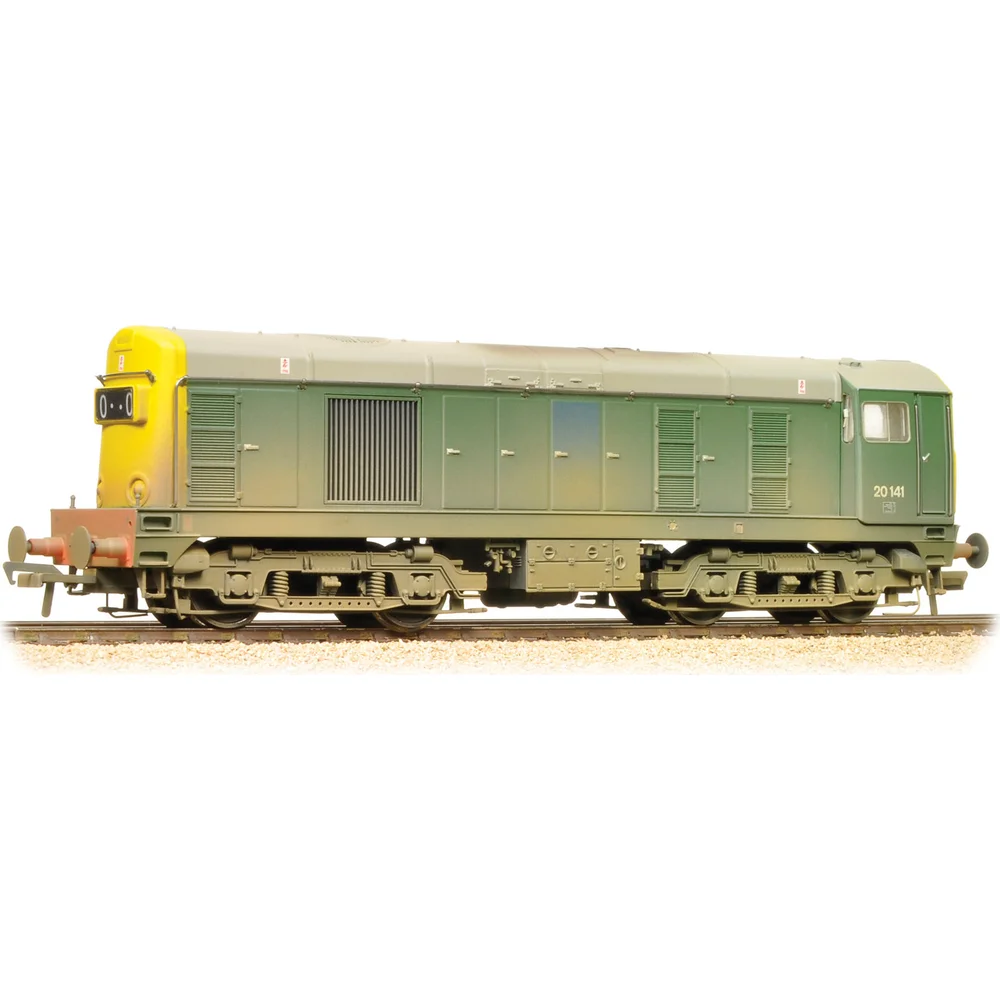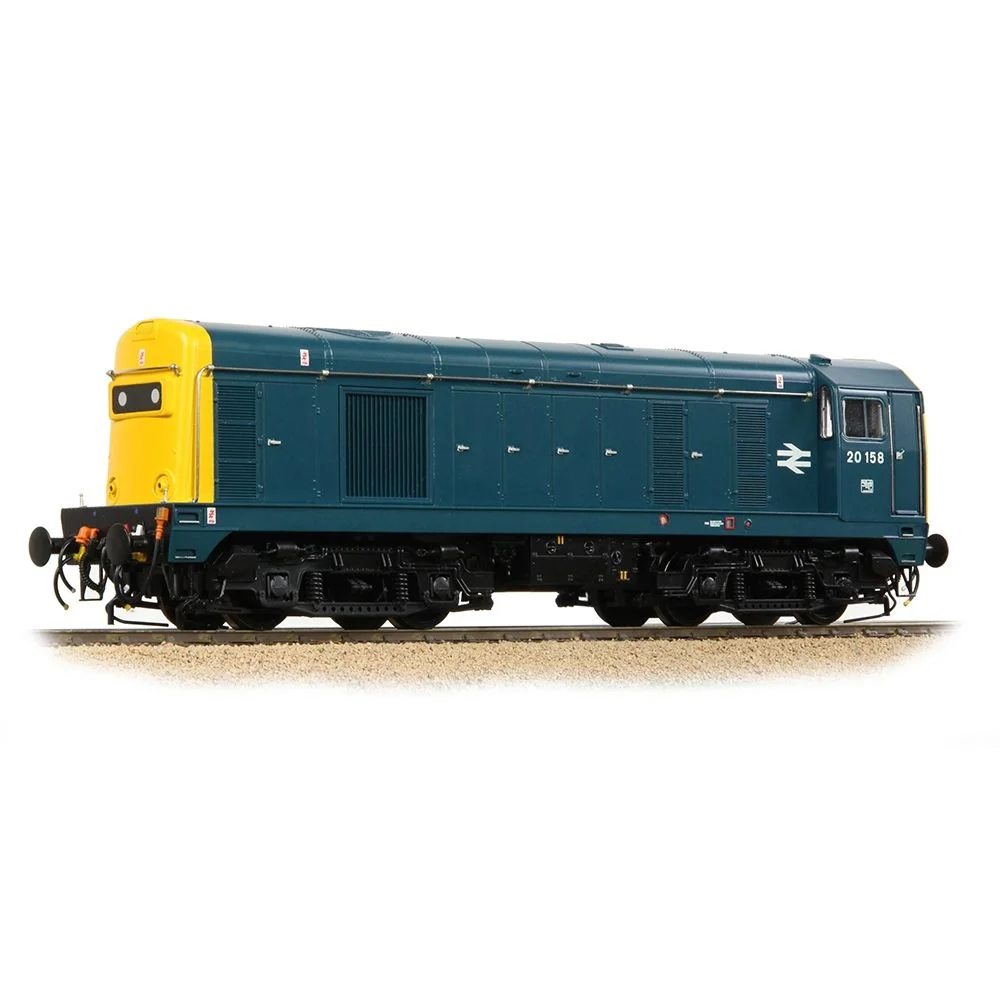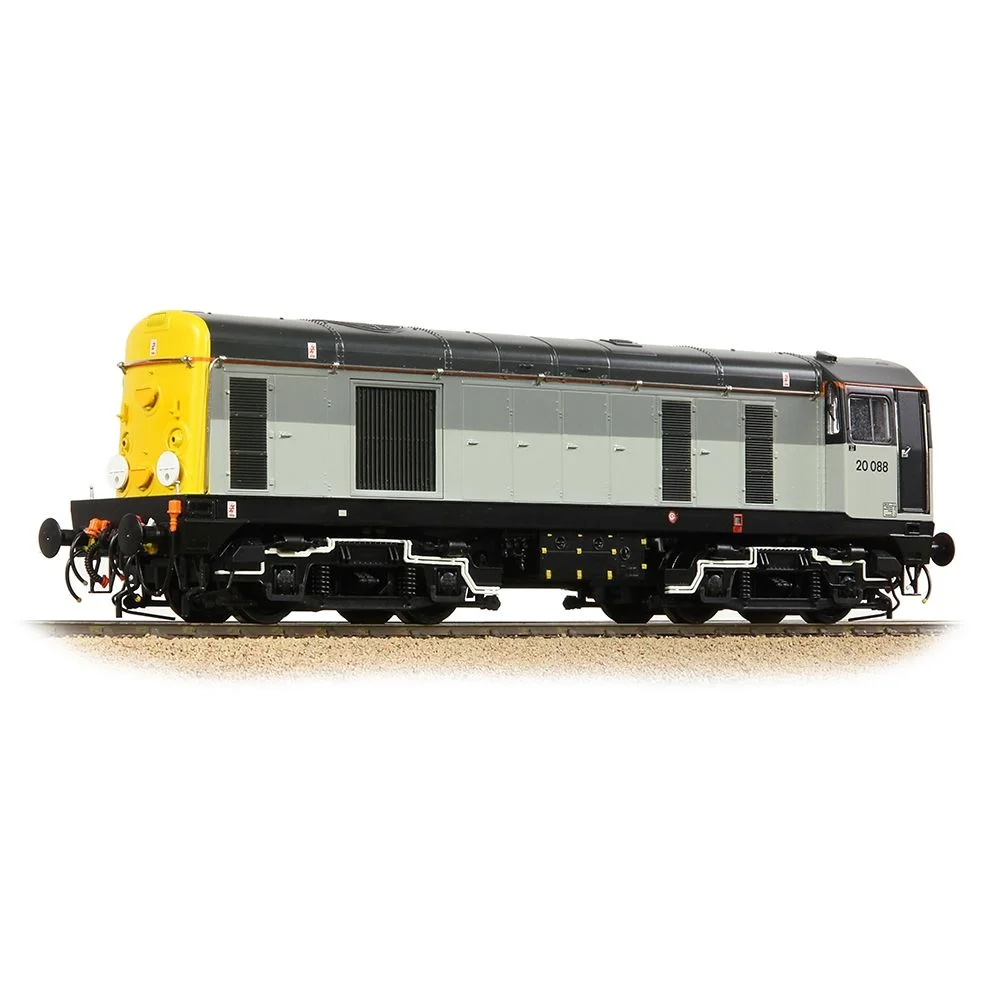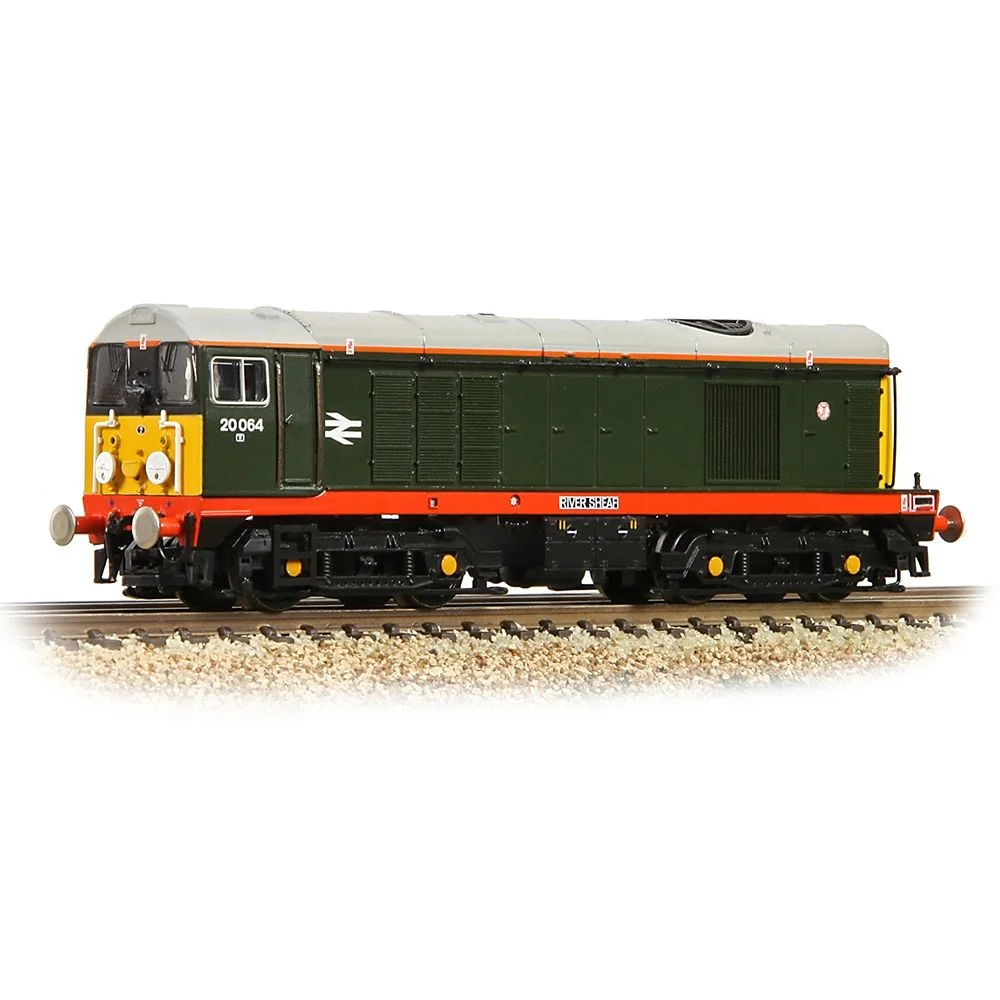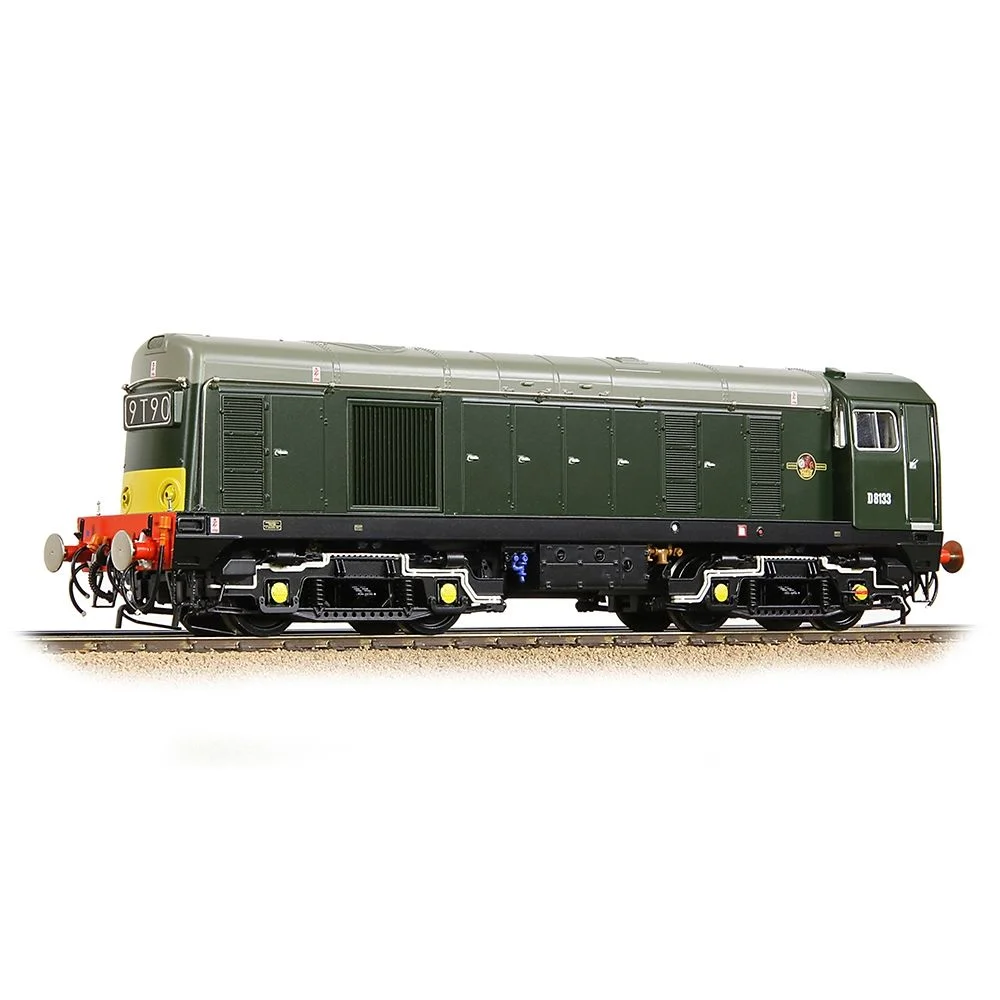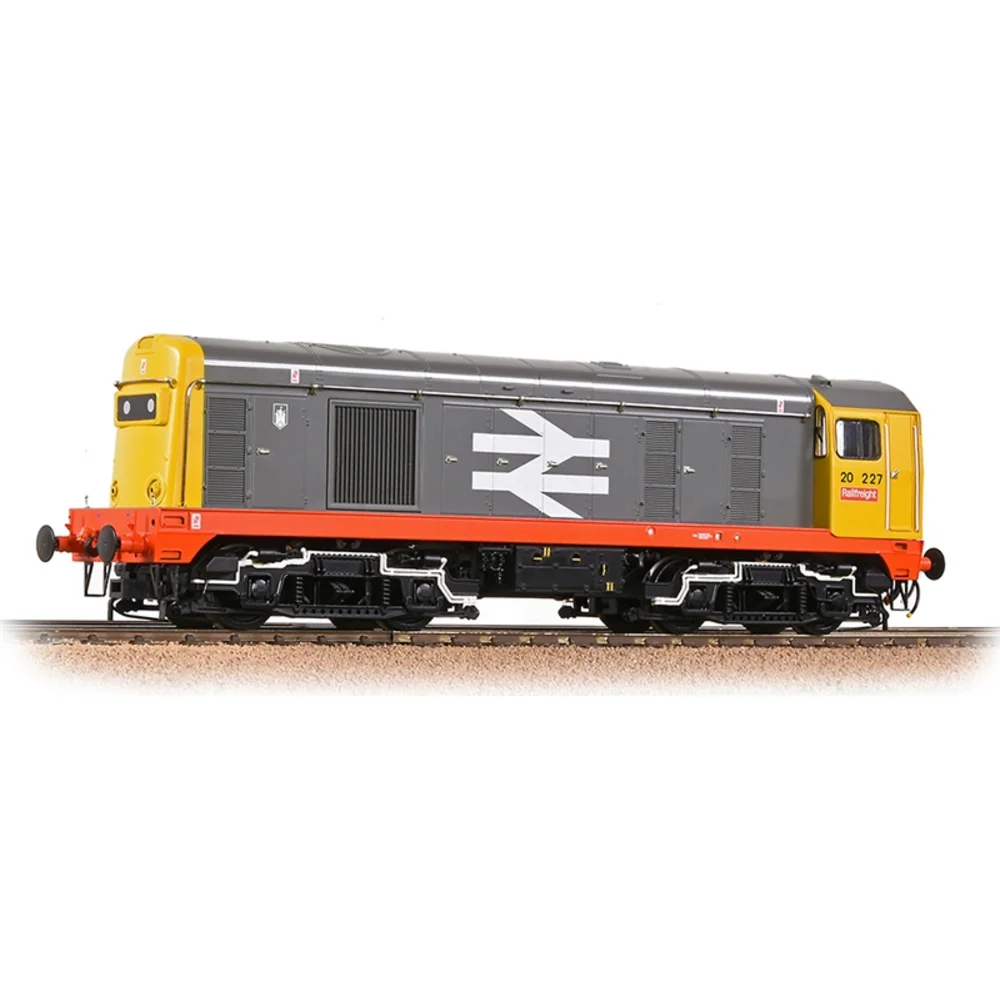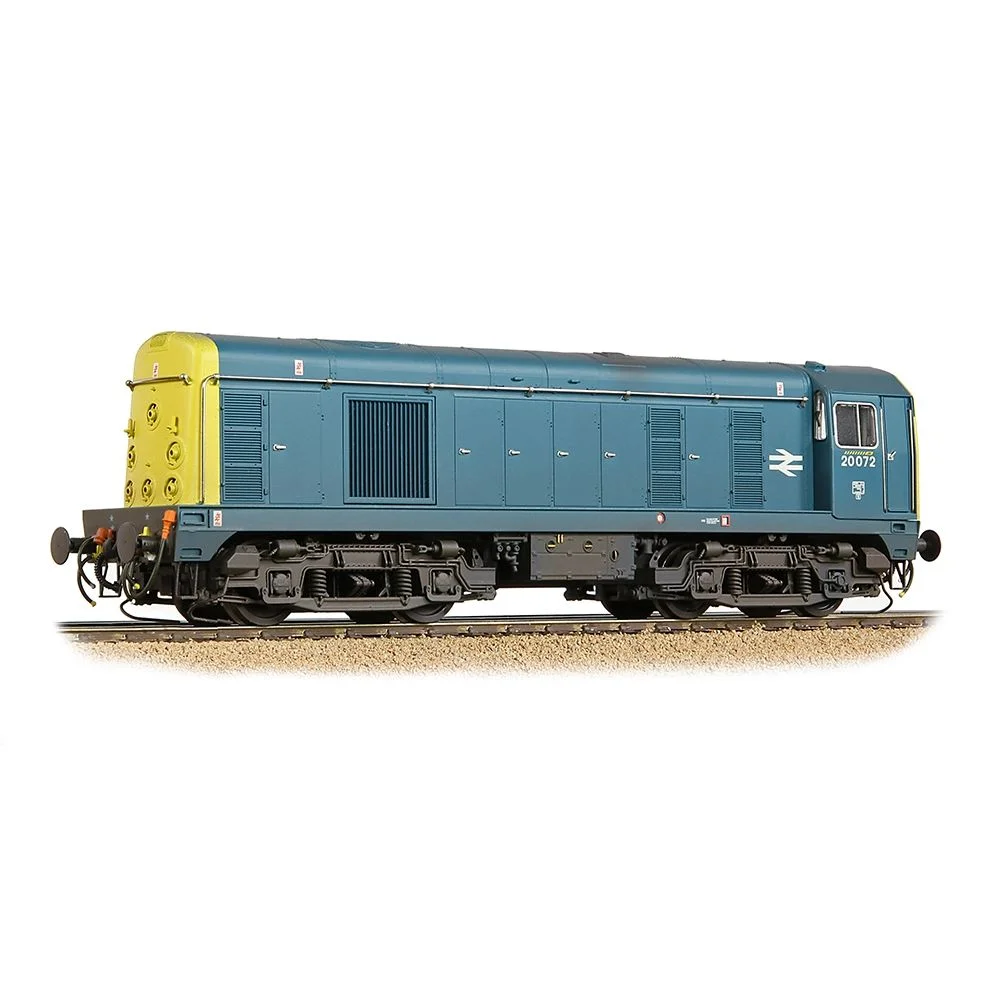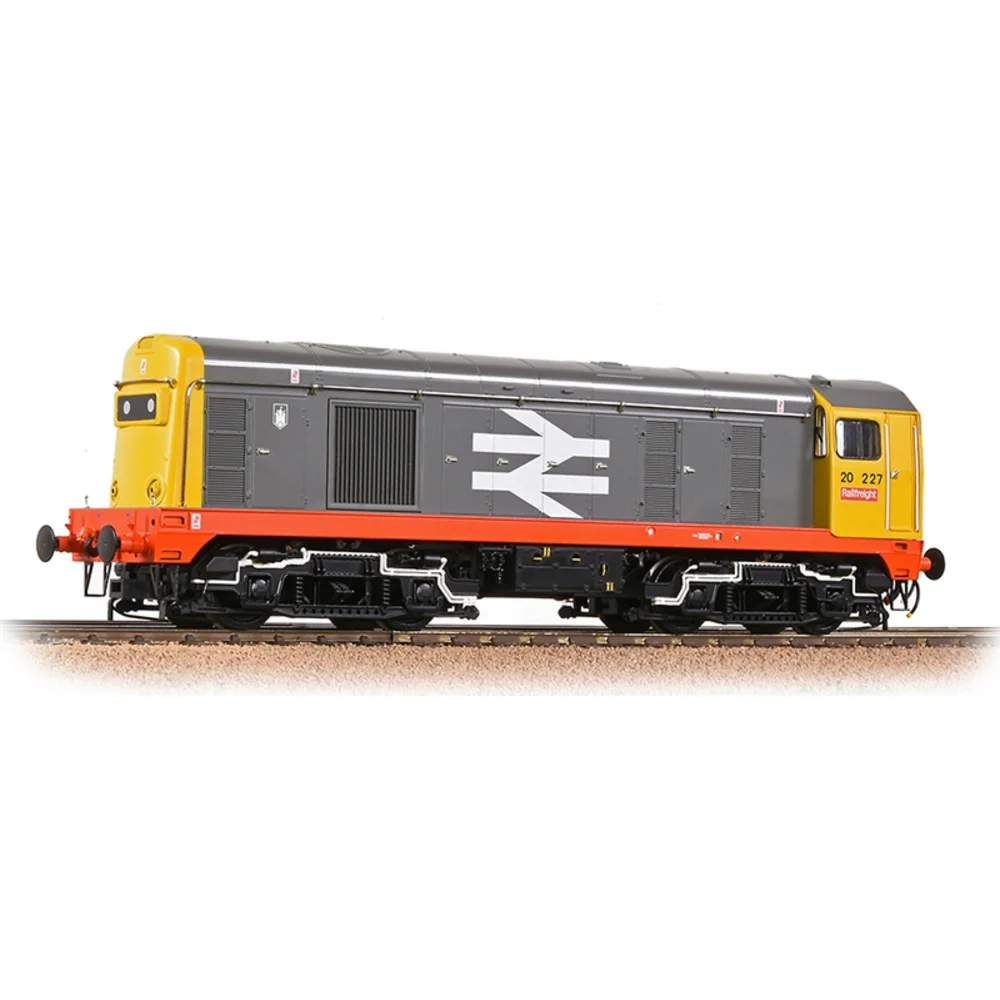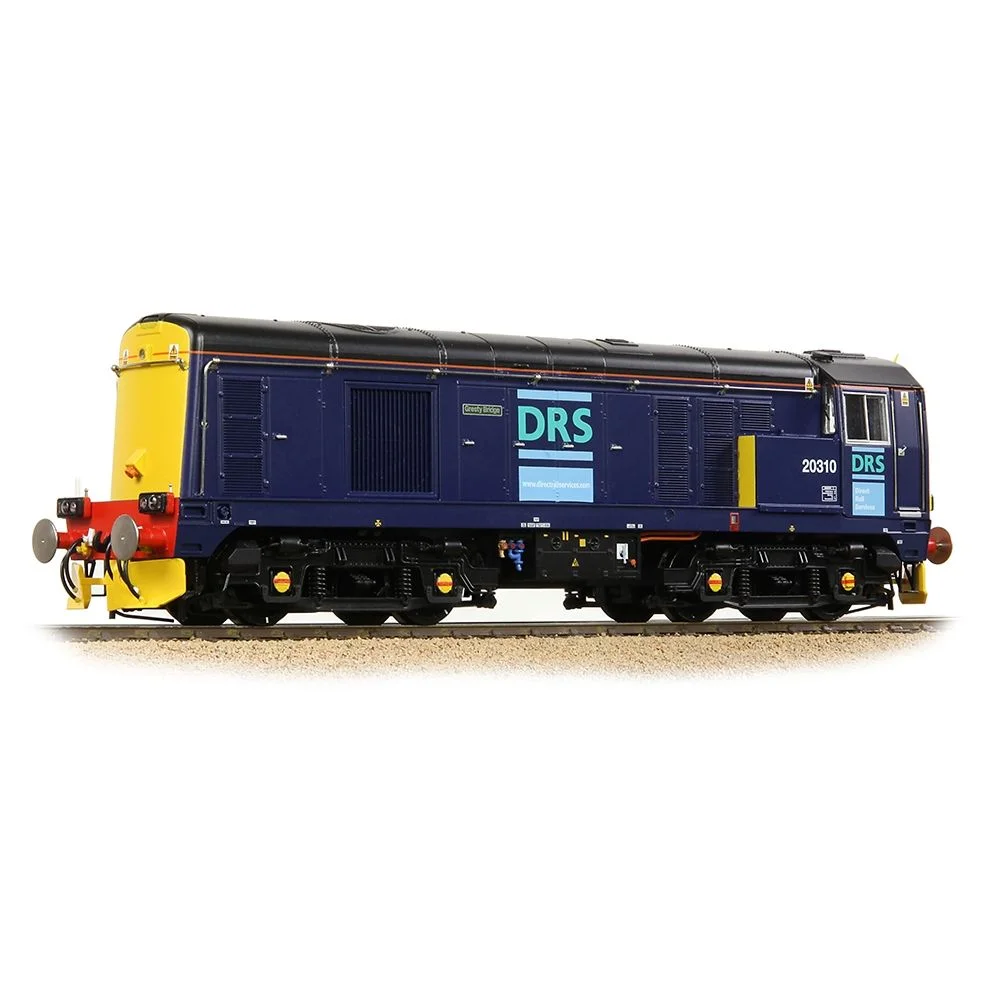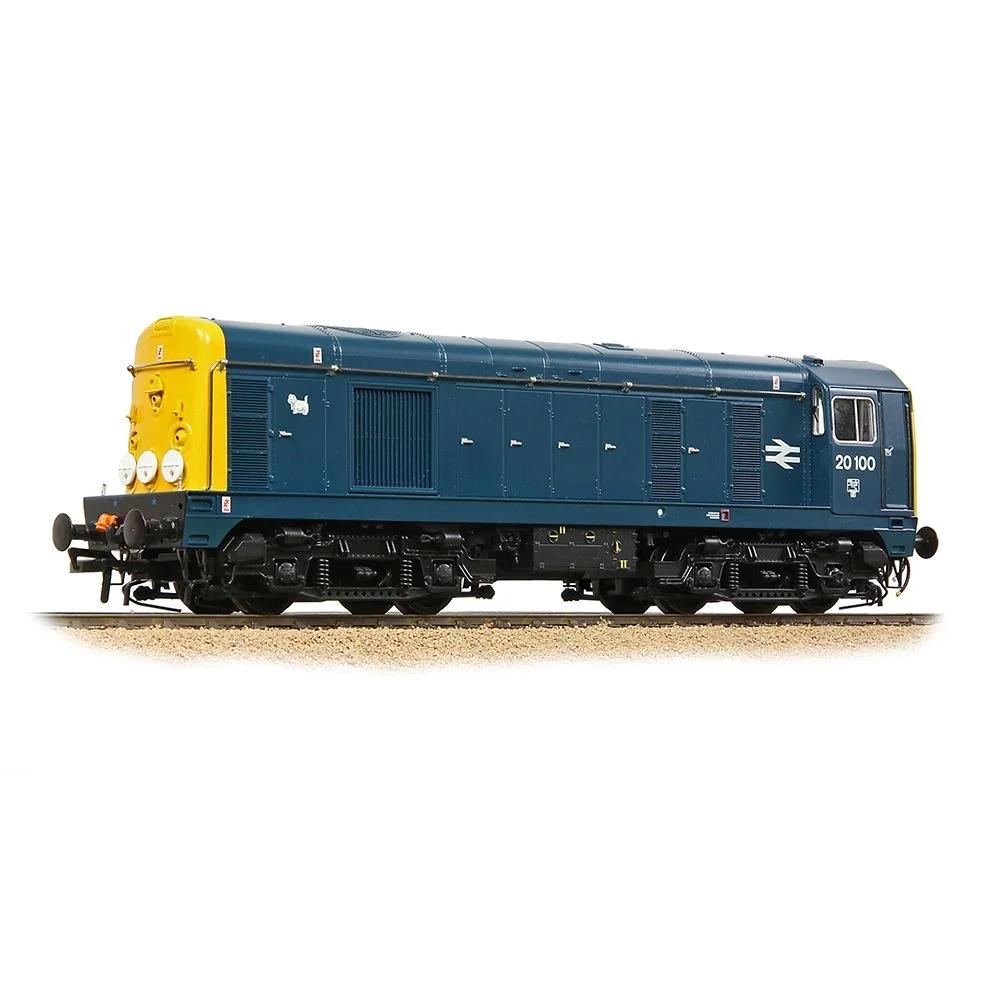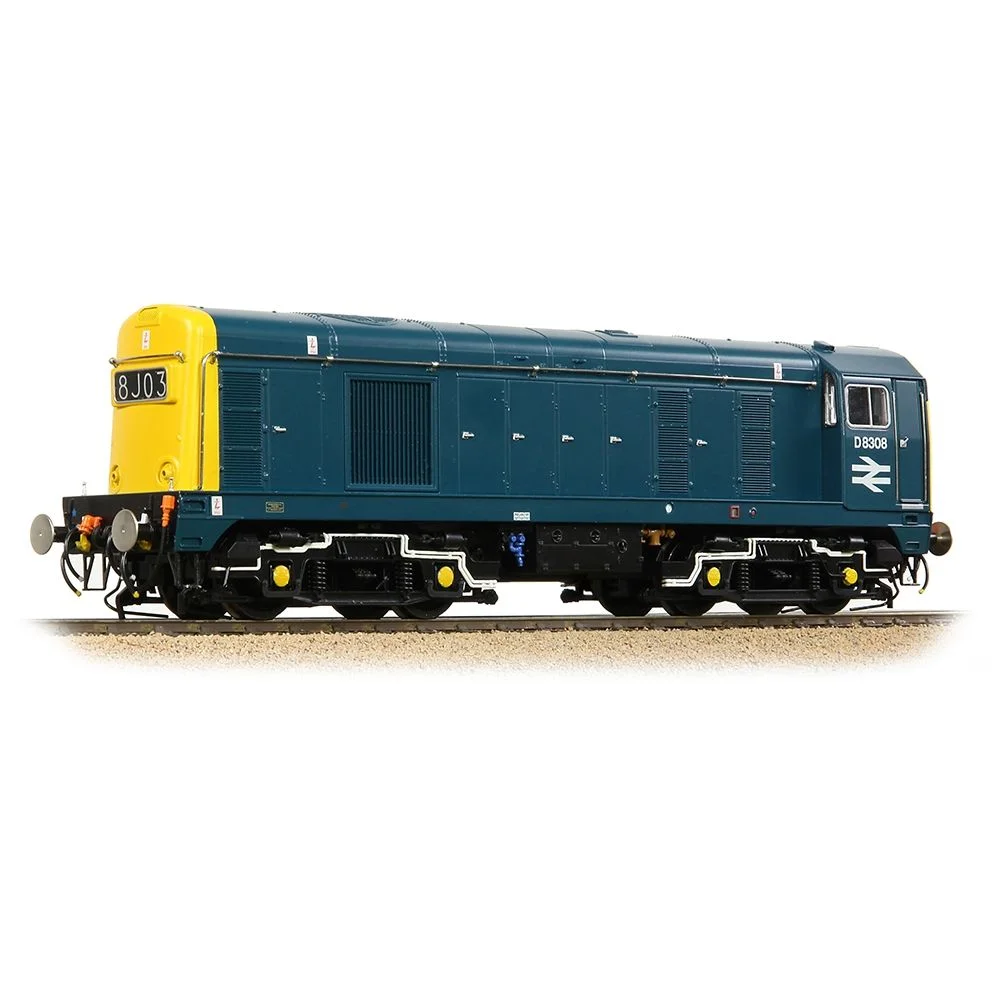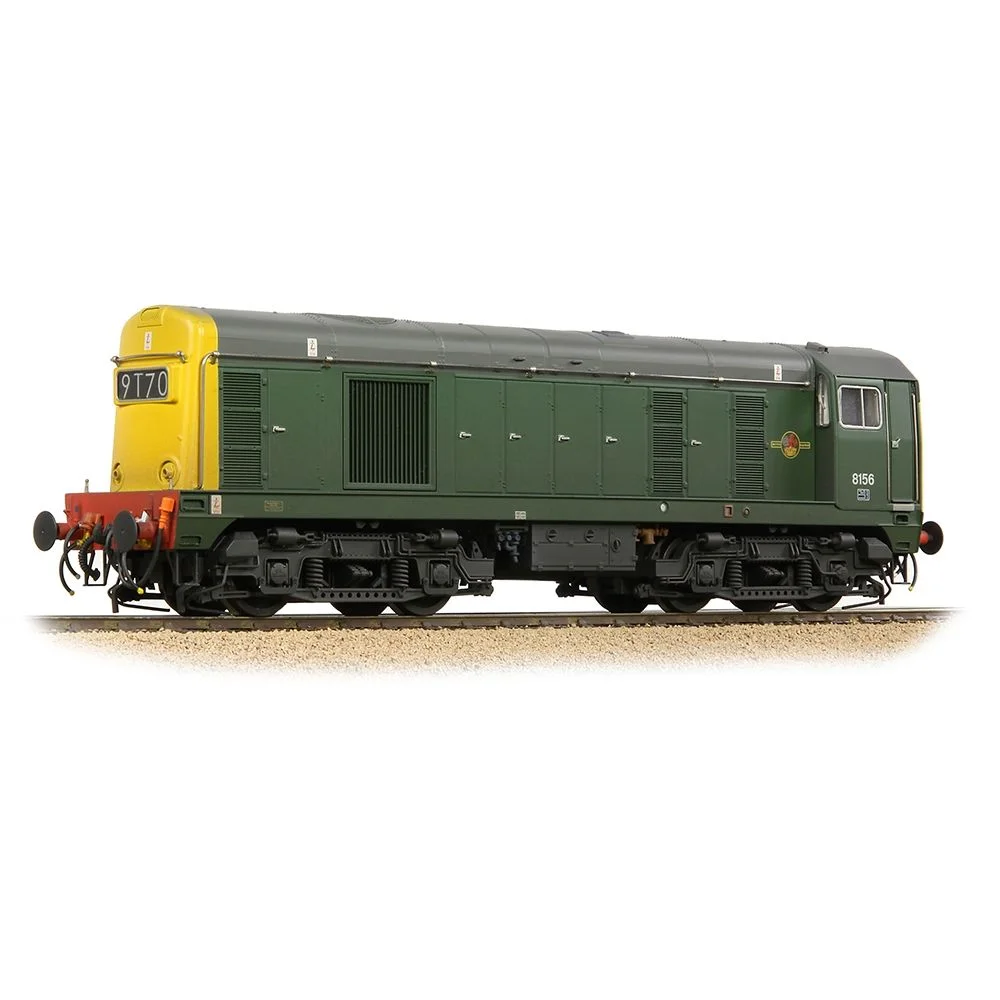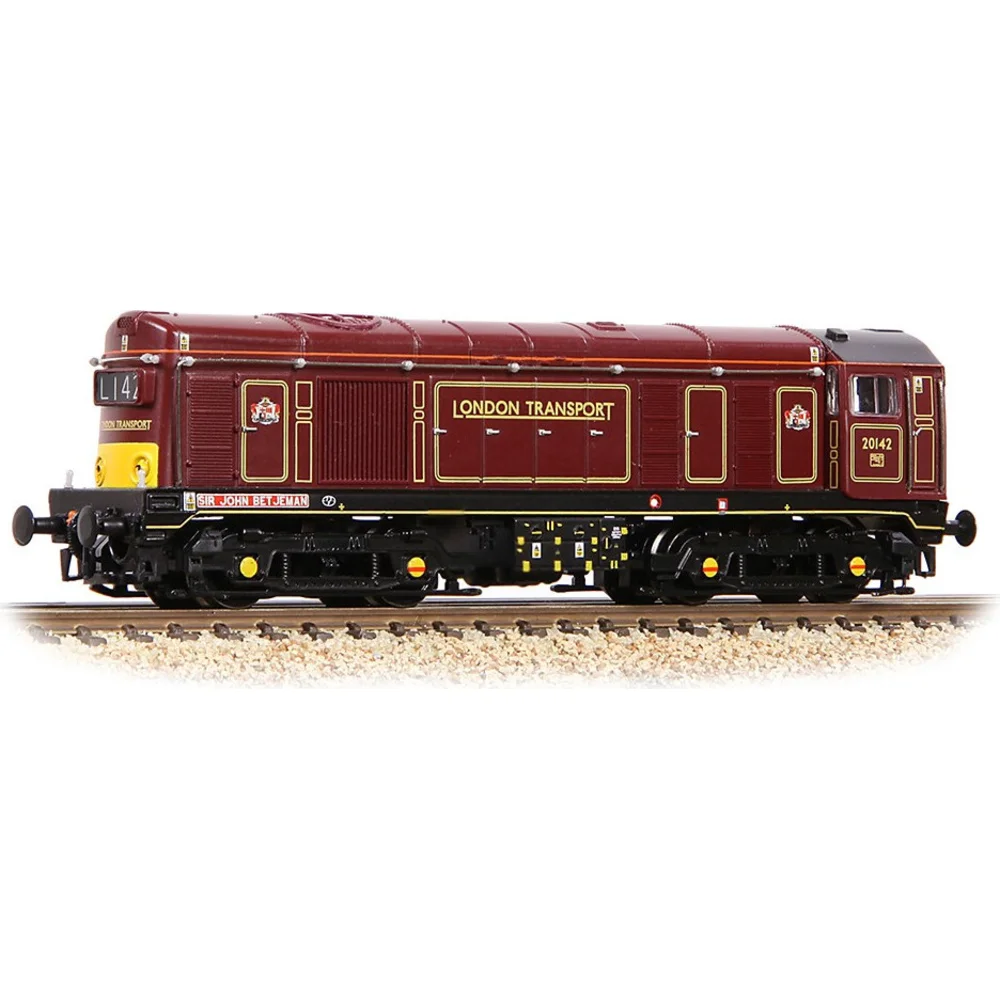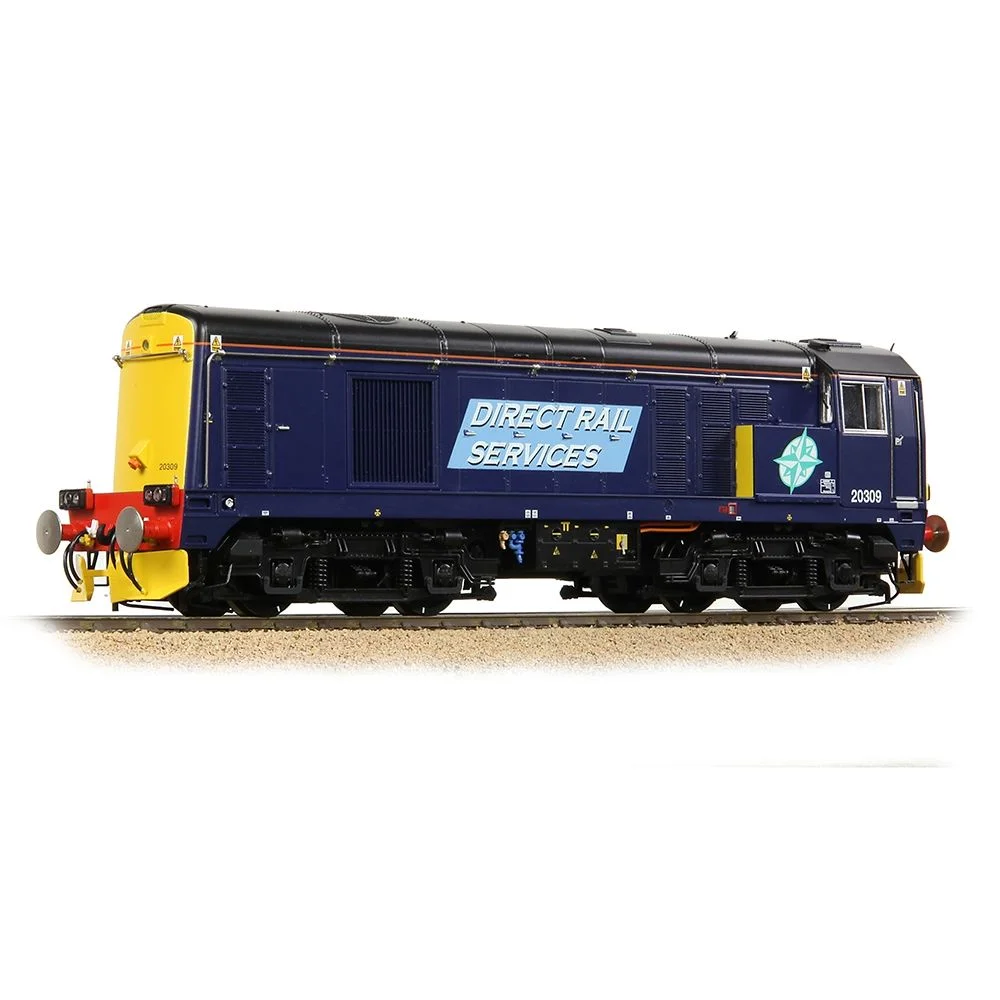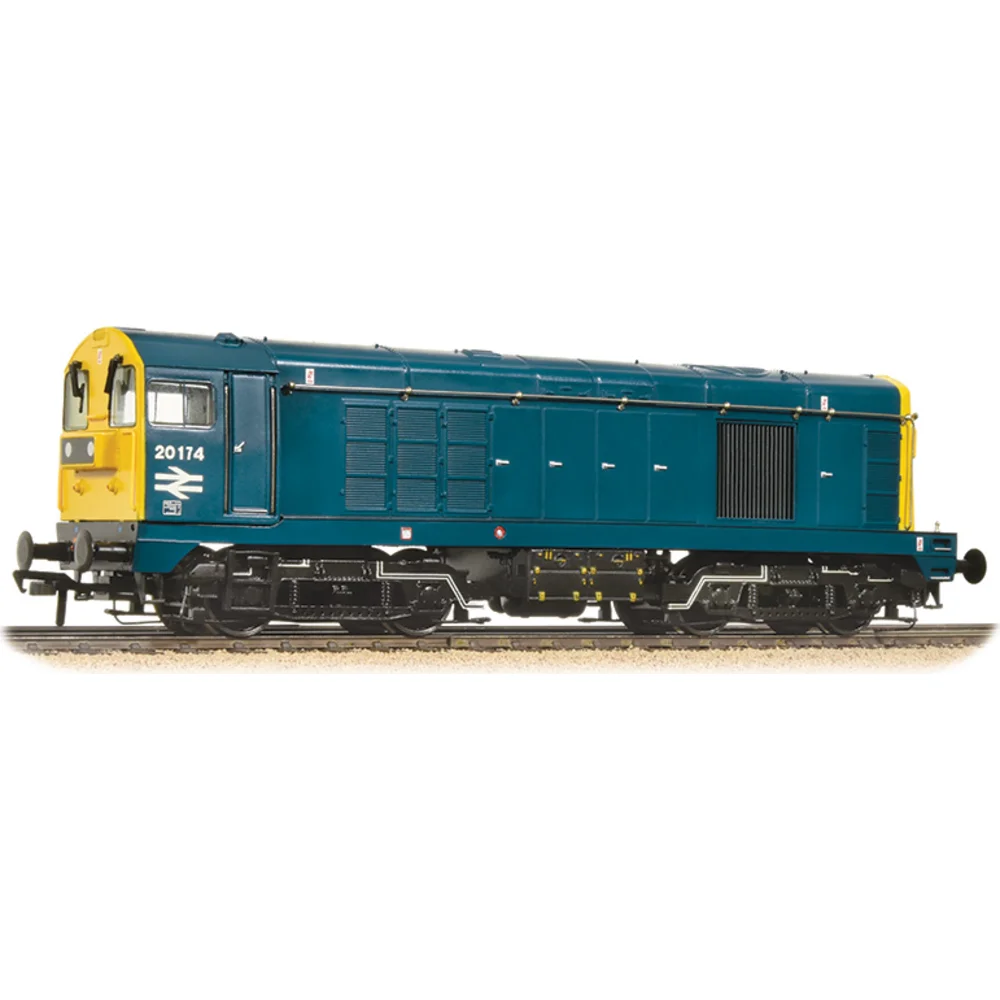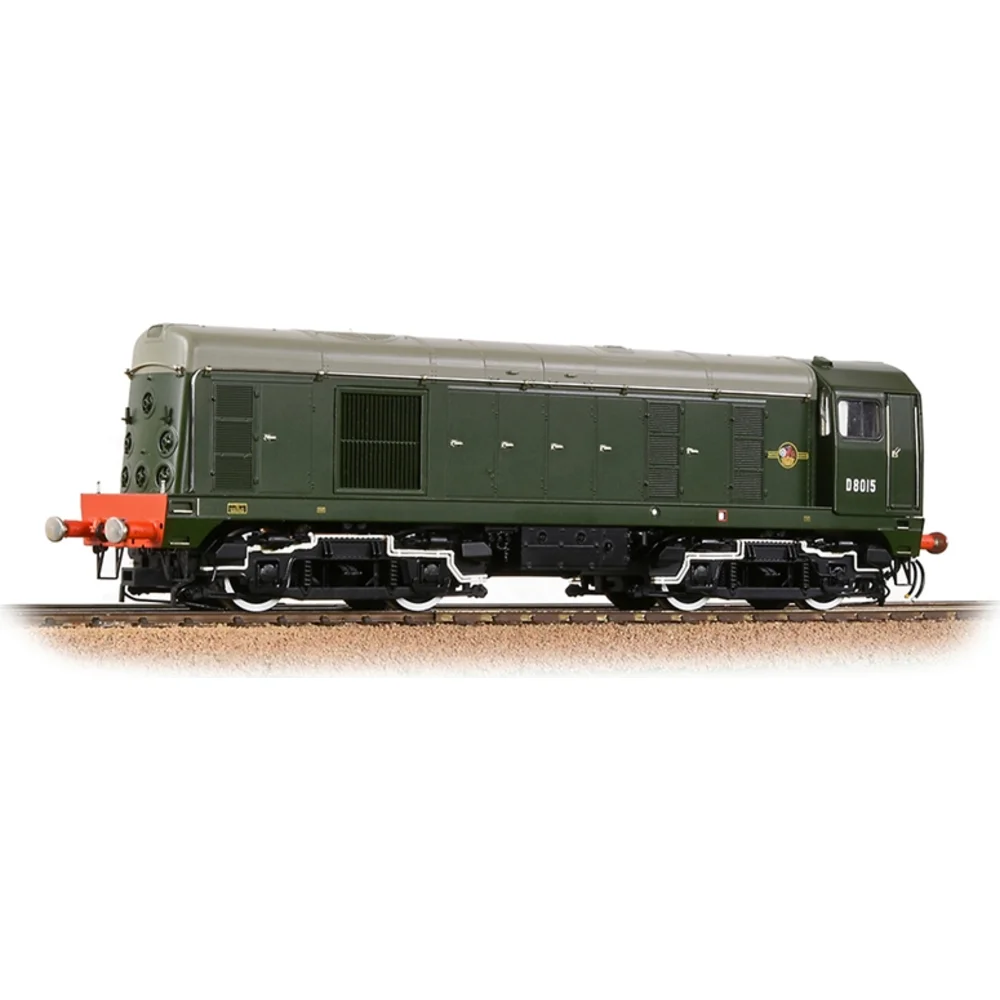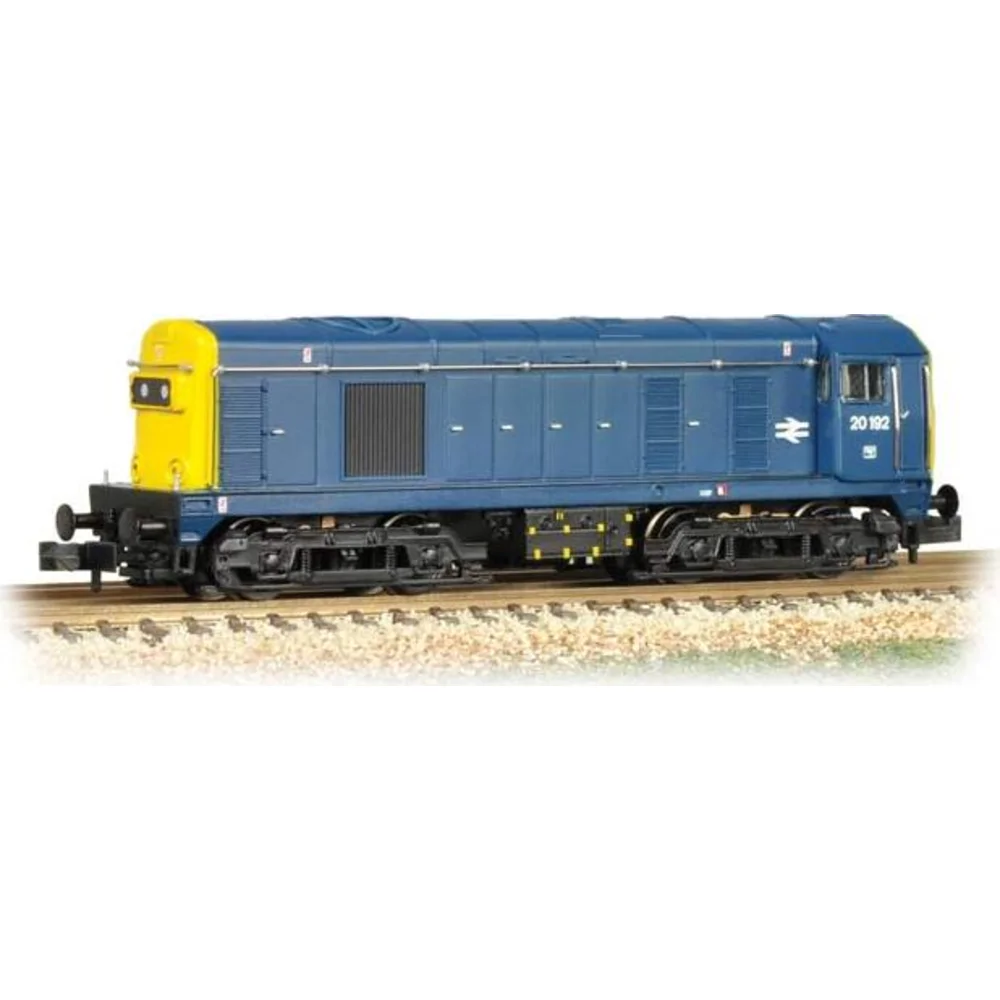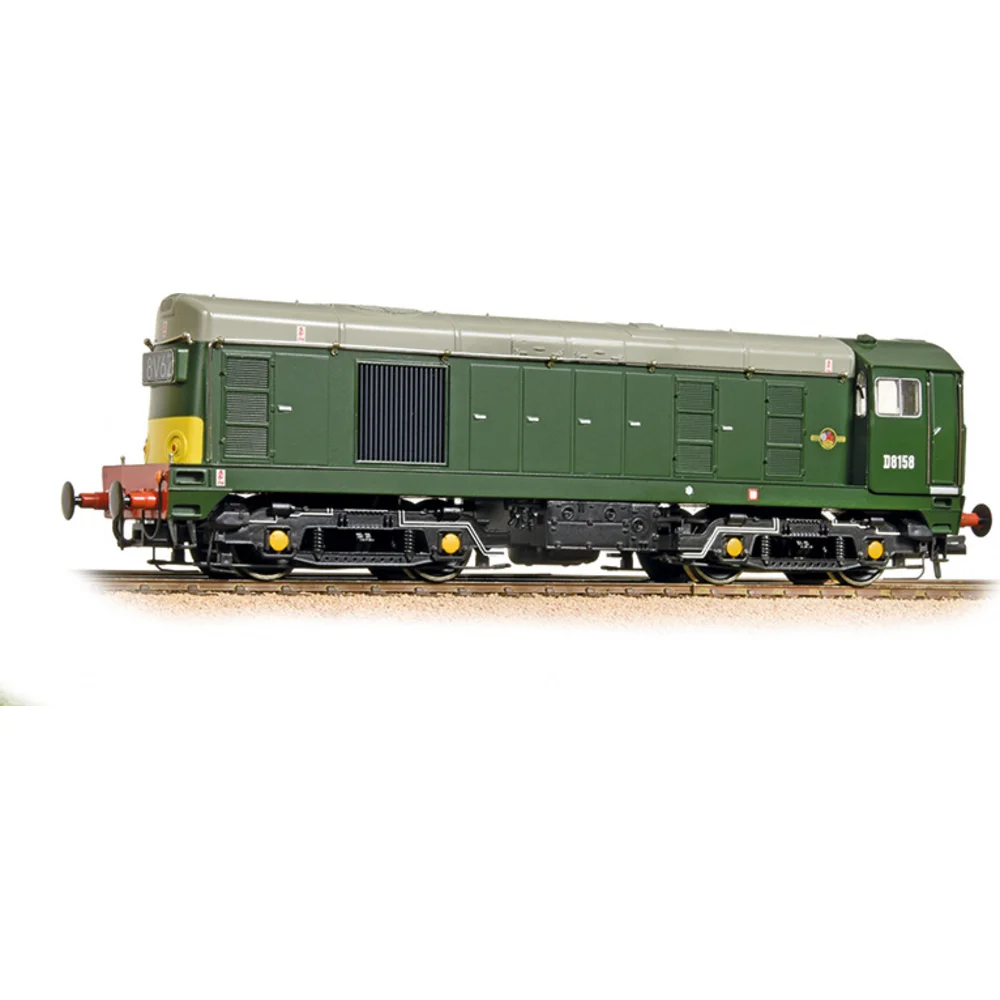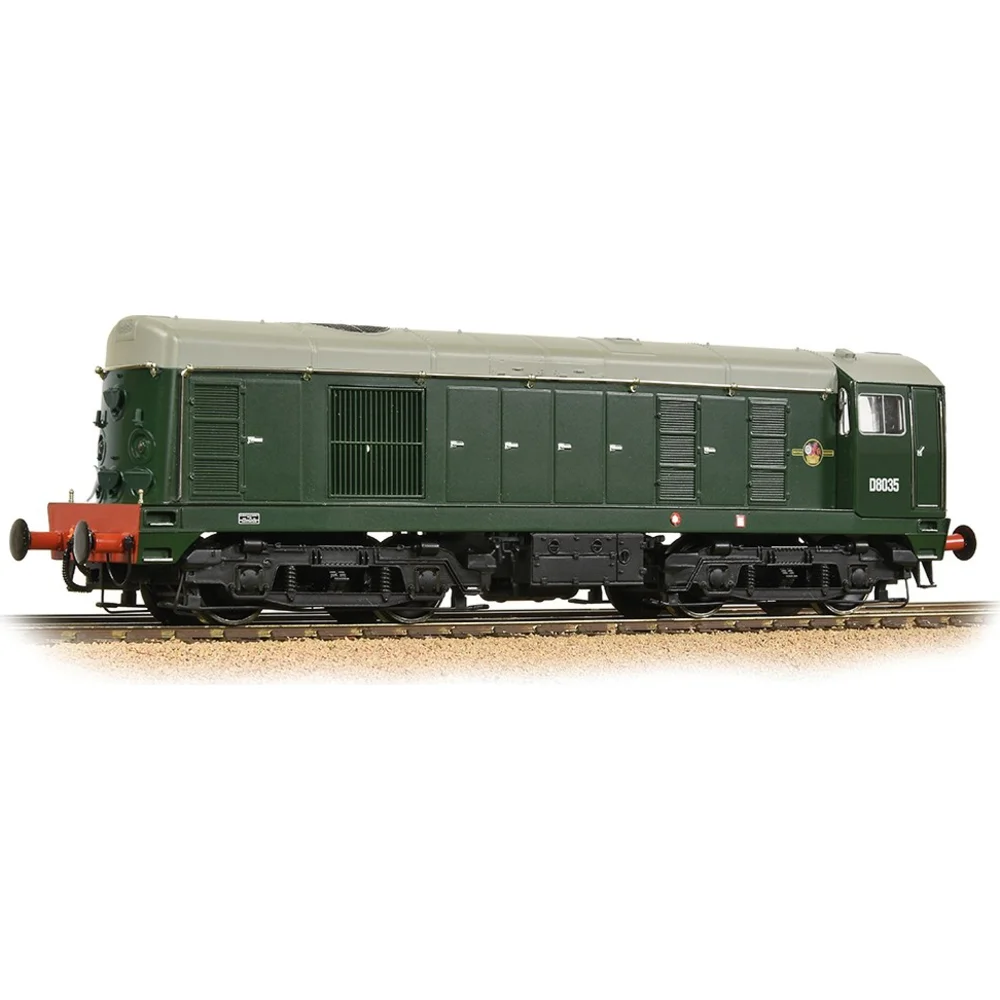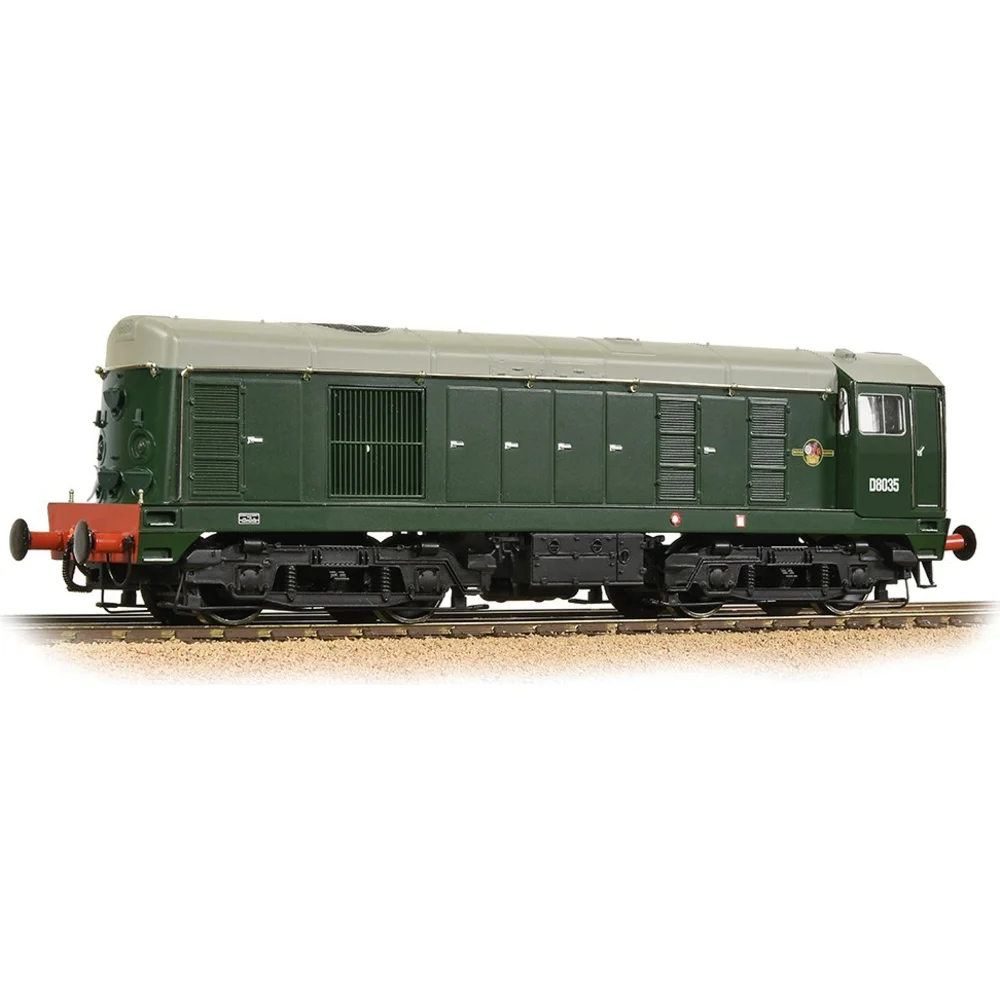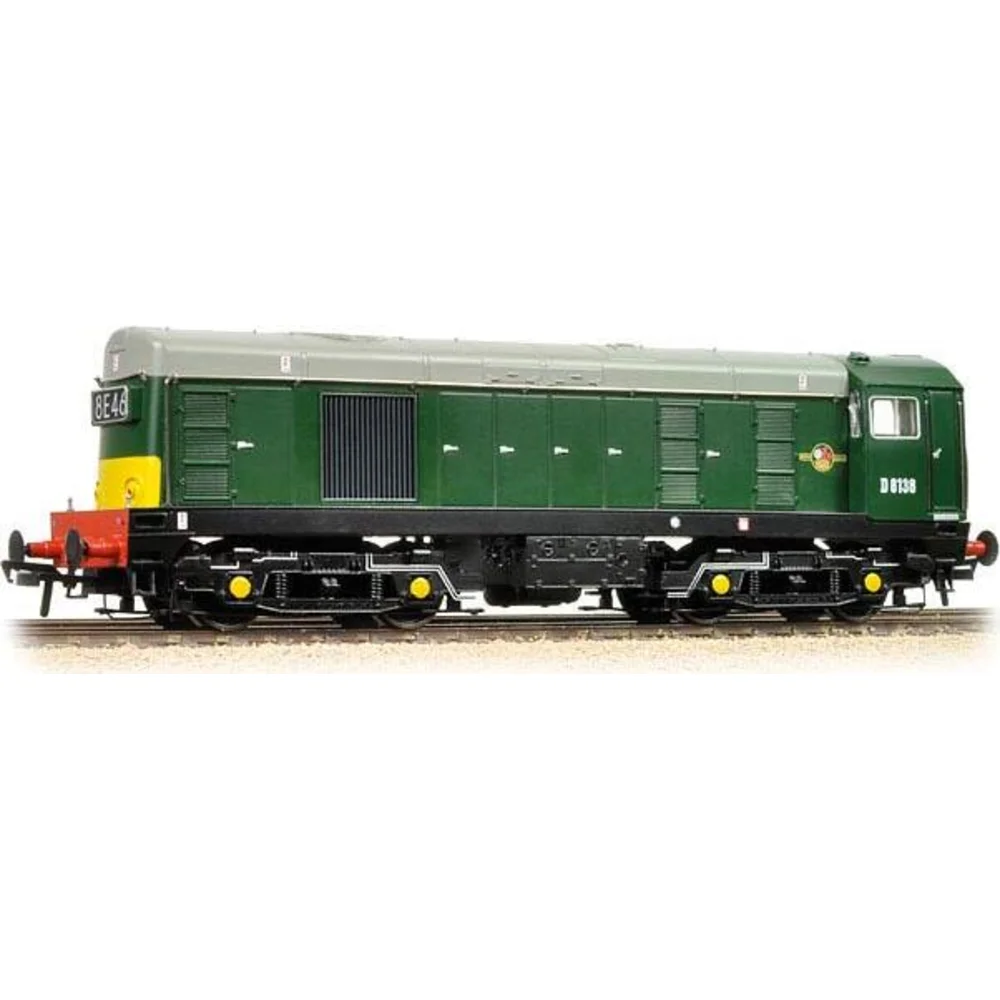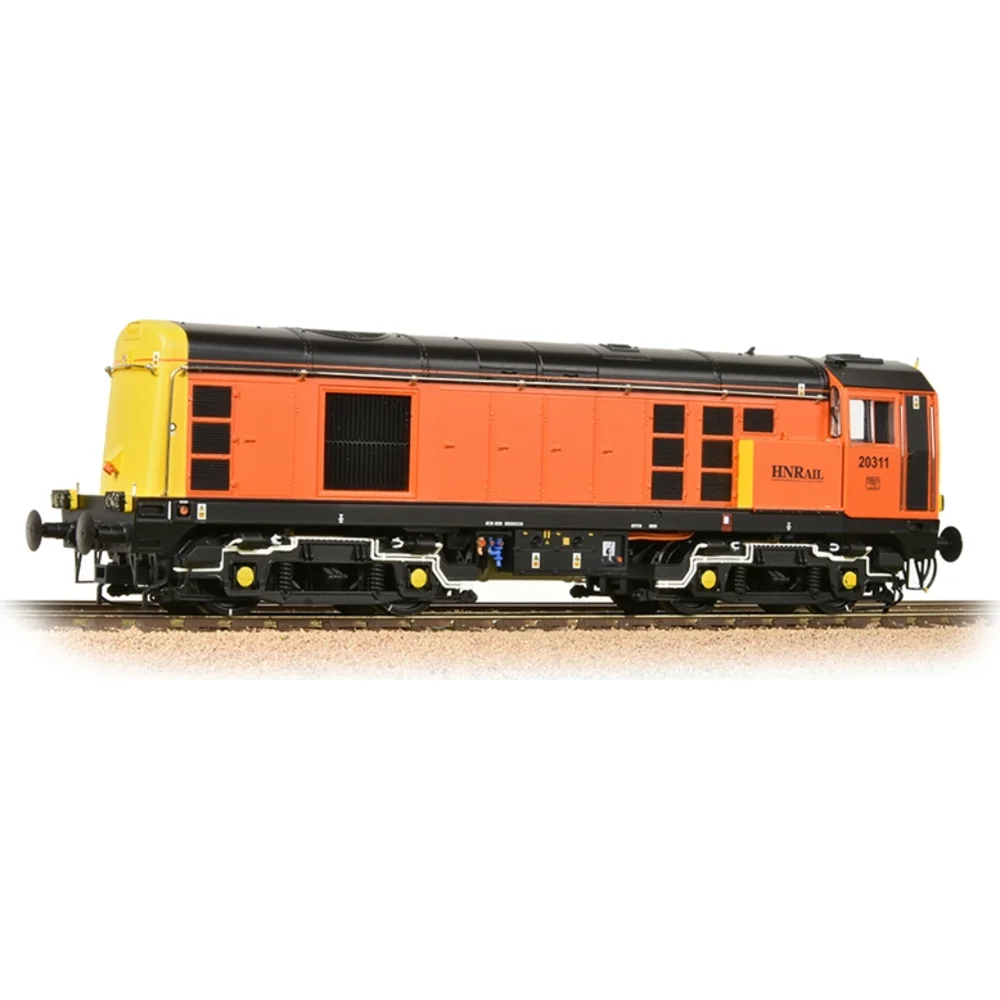British Rail Class 20 – The "Chopper" That Conquered British Freight 1957-2025
Contents
The British Rail Class 20 represents one of the most successful locomotive designs in British railway history, with 228 locomotives built between 1957-1968 that continue working today—over 65 years after the first example rolled out of Vulcan Foundry. Originally classified as English Electric Type 1, these distinctive single-cab "hood units" became beloved for their reliability, iconic "chopper" exhaust sound, and characteristic nose-to-nose paired operation that solved visibility problems whilst doubling power output. For model railway enthusiasts, the Class 20 offers exceptional opportunities across multiple scales with outstanding ready-to-run models from Bachmann, Graham Farish, and Heljan representing locomotives that worked everything from 1960s coal trains to modern nuclear flask operations and heritage railway services.
The significance extends far beyond nostalgic appeal. The Class 20's remarkable longevity—from the 1955 British Railways Modernisation Plan through privatisation and into the preservation era—reflects fundamental design excellence. Built around proven English Electric technology emphasising reliability over innovation, these locomotives succeeded where competing Type 1 designs failed catastrophically within years of introduction. Today, approximately 15 remain in mainline service with operators including Balfour Beatty and Harry Needle Railroad Company, whilst 22 preserved examples operate on heritage railways across Britain, making the Class 20 one of the most successfully preserved diesel classes in the country. This comprehensive guide covers complete history, technical specifications, operational service across six decades, preservation status, and detailed modelling information to help railway enthusiasts authentically recreate this iconic locomotive.
From hauling cross-London transfer freights and Yorkshire coal trains during the 1960s to working merry-go-round coal services through the 1970s-1980s, nuclear flask trains in the 2000s, London Underground stock deliveries in the 2010s, and contemporary engineering train operations—the BR Class 20 proved that conservative engineering and proven technology could outlast flashier competitors. The distinctive American-inspired single-cab design that initially appeared problematic became the class's defining characteristic, spawning operational practices that remain distinctive today. Whether creating authentic 1960s BR Green freight operations, 1980s Railfreight sector services, or modern Direct Rail Services nuclear train workings, model railway enthusiasts find the Class 20 an ideal subject offering versatility, visual distinction, and that unforgettable exhaust sound that earned these locomotives their enduring "Chopper" nickname.
Quick Takeaways
- 228 locomotives built: Constructed 1957-1968 by Vulcan Foundry (135) and Robert Stephenson & Hawthorns (93) as Britain's first production mainline diesel locomotives under the 1955 Modernisation Plan
- American-inspired single-cab design: Distinctive "hood unit" configuration with cab at No. 2 end created visibility challenges solved through characteristic nose-to-nose paired operation doubling power to 2,000 hp
- Proven English Electric engineering: Reliable 8SVT Mark II 8-cylinder turbocharged engine producing 1,000 hp with proven traction equipment prioritising simplicity and maintainability over complexity
- Iconic "chopper" exhaust sound: Distinctive beat from 8SVT engine under load resembling helicopter rotors became immediately recognisable across British railways and beloved by enthusiasts
- 65+ year service span: From 1957 debut through 2024 operations with approximately 15 locomotives still active on mainline, demonstrating exceptional design longevity outlasting virtually all contemporary diesels
- Outstanding preservation success: 22 locomotives preserved (9.6% of class), including National Railway Museum's D8000 and Class 20 Locomotive Society's fleet, with 10-12 operational on heritage railways
- Exceptional modelling options: Comprehensive ready-to-run ranges from Bachmann (OO gauge with sound-fitted options), Graham Farish (N gauge), and Heljan (O gauge) covering BR Green through modern operator liveries
Historical Background and Context
The genesis of the BR Class 20 emerged from British Railways' ambitious £1.2 billion Modernisation Plan announced in January 1955, which committed to replacing steam traction with diesel and electric locomotives to compete with growing road transport competition threatening the railway's freight business. The plan categorised diesel locomotives into five power ranges, with Type 1 indicating locomotives of 1,000 bhp or below intended as general-purpose freight types for light mixed traffic replacing aging steam locomotives on secondary routes and local freight duties. English Electric, having successfully supplied diesel shunters and the pioneering LMS twins 10000/10001, won contracts to supply production quantities under BR's Pilot Scheme ordering experimental locomotives from various manufacturers.
D8000—the first production mainline diesel locomotive in Britain—rolled out of Vulcan Foundry in Newton-le-Willows on June 2, 1957, costing £58,143. This single locomotive represented Britain's commitment to dieselisation, though none could have predicted it would inaugurate a class working continuously for over 65 years. The locomotive travelled to Devons Road depot in Bow, East London—Britain's first purpose-built diesel depot constructed specifically for the new traction—where it began working cross-London transfer freights carrying goods between termini that would characterise early Class 20 operations.
Production proceeded in two distinct batches reflecting BR's evolving diesel procurement strategy. The first batch (D8000-D8127, 128 locomotives) delivered between 1957 and 1962 from both Vulcan Foundry and Robert Stephenson & Hawthorns in Darlington, the latter having become part of the English Electric group in 1955. These early locomotives featured disc headcode indicators mounted in steam-locomotive style positions on the cab front, with small yellow warning panels appearing from D8103 onwards in response to developing safety standards for diesel traction visibility.
A curious four-year production hiatus occurred 1962-1966 when British Railways mistakenly ordered the problematic Clayton Class 17 Type 1 locomotives instead of additional proven English Electric machines. The Class 17s proved disastrous—crude construction, unreliable Paxman engines, and fundamental design flaws led to wholesale withdrawal by 1971 after barely a decade of troubled service. This catastrophic failure vindicated the English Electric design's conservative approach and prompted BR to resume Class 20 orders.
Insider Tip: Distinguishing First and Second Batch Locomotives
The two production batches display immediately recognisable visual differences critical for authentic modelling. First batch locomotives (D8000-D8127) feature disc headcode indicators on the cab front with small yellow warning panels added progressively from D8103 onwards, creating variety within early production. Second batch locomotives (D8128-D8199, D8300-D8327) have centrally-positioned headcode boxes on the cab front with full yellow warning panels as standard, plus electronic Slow Speed Control equipment for merry-go-round coal train operations. When modelling specific periods, ensure locomotive numbers match the appropriate batch characteristics—a D8050 with headcode boxes would be prototypically incorrect, as would a D8180 with disc headcodes.
The second batch (D8128-D8199, D8300-D8327, totalling 100 locomotives) delivered 1966-1968 incorporated significant improvements based on operational experience. The centrally-positioned headcode box replaced disc indicators, providing better forward visibility and more prominent route indication. More significantly, from D8316 onwards locomotives received "Slow Speed Control" electronic equipment maintaining steady 1.5 mph through merry-go-round loading and unloading facilities without stopping—revolutionary technology transforming coal train operations and securing the class's future as Britain's coal traffic boomed through the 1970s.
Under the TOPS (Total Operations Processing System) computerised fleet management scheme introduced from 1973, the class became 20 001-228, with the second digit '0' indicating the Bo-Bo wheel arrangement. The straightforward renumbering added 20000 to existing numbers: D8000 became 20 050, D8127 became 20 177, and so forth. This systematic approach simplified fleet management whilst maintaining numerical sequence recognisable to operating staff familiar with the original D8xxx series.
Contemporary railway periodicals praised the design's robust construction and reliable performance, particularly noting the excellent maintenance accessibility through multiple hinged access panels along the bonnet sides. The Railway Gazette highlighted the proven English Electric components and straightforward electrical systems as exemplifying best practice in locomotive design—prioritising reliability and maintainability over innovation. This conservative philosophy, initially criticised by those favouring more adventurous designs, proved entirely correct as the Class 20s outlasted virtually every competing Type 1 design by decades.
Design and Technical Specifications
The engineering excellence of the BR Class 20 lay in English Electric's philosophy of using proven components in straightforward configurations rather than pursuing innovative but unproven technologies. At the locomotive's heart sat the English Electric 8SVT Mark II diesel engine—an 8-cylinder turbocharged Vee-type powerplant with cylinders arranged at 45 degrees, displacing 12.5 litres per cylinder for total capacity of approximately 100 litres. The Mark II designation indicated a 4-valve cylinder head design improving upon the earlier 2-valve Mark I specification, providing better breathing characteristics and more efficient combustion whilst maintaining mechanical simplicity.
This engine traced direct lineage to the 16SVT powerplant successfully employed in LMS experimental diesel locomotives 10000 and 10001 from 1947-1948, which had accumulated impressive operational records demonstrating the fundamental soundness of the design. The 8SVT represented a de-rated, more compact version perfectly suited to the Type 1 power classification whilst retaining the proven reliability that characterised English Electric marine and industrial diesel engines. The engine produced 1,000 brake horsepower (750 kW) at 850 rpm with maximum power, though actual power at rail reached approximately 770 hp at 11 mph due to transmission losses—entirely adequate for the light freight duties the locomotive was designed to perform.
The crankshaft bolted directly to the English Electric 319-3C main generator producing 1,070 Amps at 600 volts DC, mounted in overhung configuration from the engine. An auxiliary generator—the English Electric 911-2B producing 110 volts DC—provided power for compressor, vacuum exhauster, traction motor blowers, battery charging, and fuel pump operations. This straightforward diesel-electric transmission avoided complex mechanical drives, clutches, or fluid couplings that could fail, instead using proven electrical equipment that railway workshops understood and could maintain effectively.
Four English Electric 526/8D nose-hung DC traction motors—one per axle—provided propulsion through single reduction gears to the 3 feet 9 inch diameter driving wheels. Each motor rated 600 Amps at 300 volts DC, with series-parallel control providing two field weakening stages allowing the locomotive to reach its 75 mph maximum speed. The nose-hung mounting suspended motors from axle bearings with one end and bogie frame with the other, transmitting torque through a single-reduction gearbox—simple, robust, and proven technology requiring minimal specialised maintenance.
The Bo-Bo wheel arrangement—two four-wheel bogies with all axles powered—sat on welded-frame equalising-beam bogies featuring helical coil spring primary suspension and secondary suspension maintaining even weight distribution across all axles regardless of track irregularities. This sophisticated suspension provided excellent riding characteristics whilst maximising adhesion by ensuring all wheels maintained contact with rail during operation over uneven track. The relatively short 28 feet 9 inches wheelbase and 46 feet 9.25 inches overall length suited the locomotive admirably for secondary routes with tight curves and restricted clearances where larger locomotives could not operate.
| Specification | Value |
|---|---|
| Classification | British Rail Class 20 / English Electric Type 1 |
| Original Numbers | D8000-D8199, D8300-D8327 |
| TOPS Numbers | 20 001 - 20 228 |
| Builder | English Electric (Vulcan Foundry & Robert Stephenson & Hawthorns) |
| Built | 1957-1968 (Batch 1: 1957-1962; Batch 2: 1966-1968) |
| Total Produced | 228 locomotives |
| Prime Mover | English Electric 8SVT Mark II 8-cylinder turbocharged diesel |
| Engine Power | 1,000 hp (750 kW) @ 850 rpm |
| Power at Rail | 770 hp @ 11 mph |
| Transmission | Diesel-electric (DC) |
| Main Generator | English Electric 319-3C (1,070A @ 600V DC) |
| Traction Motors | 4× English Electric 526/8D nose-hung DC motors |
| Wheel Arrangement | Bo-Bo |
| Wheel Diameter | 3 ft 9 in (1.143 m) |
| Wheelbase | 28 ft 9 in (8.763 m) |
| Maximum Speed | 75 mph (121 km/h) |
| Tractive Effort (Max) | 187 kN (42,000 lbf) |
| Tractive Effort (Continuous) | 111 kN (25,000 lbf) @ 11 mph |
| Multiple Working | Up to 3 units (electro-pneumatic control) |
| Length | 46 ft 9.25 in (14.26 m) |
| Width | 8 ft 9 in (2.667 m) |
| Height | 12 ft 8.5 in (3.87 m) |
| Weight | 73-73.5 tonnes |
| Fuel Capacity | 390 gallons (1,773 litres) |
| Brake Systems | Air brake (locomotive), Vacuum brake (train), 35 tonnes brake force |
The locomotive's distinctive American-inspired single-cab configuration represented the most controversial design decision and created the class's most recognisable characteristic. The driver's cab positioned at No. 2 end (conventionally designated the rear) featured twin driving desks with duplicated controls enabling left-hand drive, plus a central gangway allowing passage through the cab to the long bonnet extending forward. This "hood unit" or "bonnet unit" design directly copied American diesel locomotive practice emphasising cost-effective construction and simplified maintenance access, though it created substantial forward visibility problems when operating bonnet-first through the smaller forward windows.
Technical Innovation: Multiple Working System
The Class 20's electro-pneumatic multiple working system enabled up to three locomotives to operate under unified control from a single cab, providing crucial operational flexibility that extended the class's useful life decades beyond initial expectations. The 27-way multiple working jumper cables carried control circuits for power controller, direction selector, sand, horn, and warning lights between locomotives. Unlike some competing Type 1 designs lacking effective multiple working, Class 20s could easily pair to provide 2,000 hp output equivalent to a Type 4 locomotive whilst maintaining the operational flexibility of smaller units. This capability proved essential as freight train weights increased through the 1970s-1980s, allowing paired Class 20s to replace single larger locomotives on routes with weight restrictions or tight clearances.
The braking system combined air brakes for locomotive application with vacuum brake control valves for train braking, reflecting the transition period when British Railways operated mixed fleets of air-braked and vacuum-braked stock. The air brake applied automatically to the locomotive if vacuum dropped below safe levels, providing fail-safe protection, whilst the vacuum brake application valve allowed proportional control of train braking through the standard vacuum pipe running the train length. A handwheel-operated mechanical parking brake with chain drive to brake blocks provided secure stabling on gradients. The total brake force of 35 tonnes (77,000 lbf) proved adequate for the unfitted and partially-fitted freight trains the locomotives typically hauled.
The underframe construction employed elegant dual-purpose engineering. Two longitudinal parallel box sections formed from channel sections plated over top and bottom ran the locomotive length, welded to transverse members creating rigid frame structure. Part of these box sections was sealed to form the 390-gallon fuel tanks built integrally with the frame rather than as separate components, with some transverse members serving as balance pipes between tank sections ensuring even fuel distribution. This integrated design saved weight and construction complexity whilst providing substantial fuel capacity for the 8SVT engine's relatively modest consumption.
Multiple hinged access doors along both sides of the long bonnet provided excellent maintenance accessibility to engine, generators, fuel system, electrical equipment, and auxiliary machinery without requiring major disassembly. This practical feature earned the nickname "Whistling Wardrobe" from the distinctive whistling noise the engine air intakes made under load—a reference both to the access doors and the furniture-like appearance of the tall, angular bonnet. The comprehensive maintenance access contributed significantly to the class's operational longevity, enabling depot staff to perform routine servicing efficiently and identify potential problems before failures occurred.
Service History and Operations
The BR Class 20 quickly established itself across British Railways' freight network following D8000's June 1957 introduction, with deployment patterns revealing both the locomotive's versatility and BR's strategic dieselisation approach. Initial allocations concentrated the first 20 pilot scheme locomotives around key freight centres: Devons Road and Hornsey depots in London for cross-London transfer freights carrying goods between termini; Tinsley TMD in South Yorkshire for operations across Lincolnshire and East Yorkshire coalfields; Scottish Region depots in the Lowlands for Forth-Clyde area freight and Fife coalfield operations; and Highland Scotland allocations (D8028-D8034) fitted with tablet catching equipment enabling single-line working on remote routes north of Perth.
These early operations established operational patterns that would characterise the class throughout its service life. The locomotives proved ideal for trip workings—short-distance freight trains connecting yards, sidings, and local industries with 6-12 mixed wagons and brake van. Cross-London transfer freights typically operated with single locomotives hauling 8-15 wagons between goods yards serving different termini, threading through complex metropolitan infrastructure where larger locomotives proved unwieldy. The 73-tonne weight and 1,000 hp power output suited these duties perfectly, providing adequate performance without the operating costs and maintenance complexity of more powerful designs.
The famous paired nose-to-nose operation—the defining Class 20 operational characteristic—emerged organically from the single-cab configuration's limitations rather than original design intent. When travelling bonnet-first, drivers faced severely restricted forward visibility through small windows at the bonnet end designed primarily for maintenance access. Early operational experience quickly demonstrated this created unacceptable safety risks, particularly when operating at line speed or approaching complex junctions and stations requiring precise positioning.
The elegant solution: operate locomotives in pairs coupled nose-to-nose with cabs at opposite ends, ensuring the leading locomotive always operated cab-first with excellent forward visibility whilst the trailing locomotive contributed power under multiple working control. This "hunting in pairs" arrangement doubled power output to 2,000 hp—equivalent to a Type 4 locomotive like the Class 40 or 45—making pairs competitive for increasingly heavy freight trains as light mixed traffic declined through the 1960s-1970s. The practice became so universal that solitary Class 20s became notable exceptions rather than routine sightings, with enthusiasts specifically noting "solo 20" workings in contemporary reports.
Operational Insight: The "Chopper" Sound That Defined a Generation
The distinctive "chopper" nickname derived from the characteristic beat the 8SVT engine produced under load, creating a rhythmic "chop-chop-chop" sound resembling helicopter rotor noise that became immediately recognisable across Britain's railways. This iconic exhaust note resulted from the engine's firing order and exhaust manifold configuration, producing uneven pulses that intensified dramatically when locomotives worked hard on gradients or during acceleration. Multiple Class 20s working together created memorable acoustic experiences—paired locomotives synchronising to produce a distinctive beat, or three-unit combinations on heavy MGR coal trains generating an unforgettable chorus that epitomised industrial railway operations. The sound remains beloved by enthusiasts today, with preserved examples drawing crowds when working hard on heritage railway gradients, and sound-fitted models specifically featuring authentic "Chopper" recordings as selling points.
The 1967 introduction of Slow Speed Control equipment revolutionised coal transport operations and secured the Class 20's future for two decades. From locomotive D8316 onwards, second-batch units received electronic systems maintaining steady 1.5 mph through merry-go-round loading and unloading facilities without stopping, enabling continuous loading at collieries and discharge at power stations. MGR coal trains to Longannet Power Station in Fife sometimes operated with three Class 20s—two paired at one end, single at the other—hauling 42 HAA hoppers (approximately 1,400 tonnes) without requiring running round at either end. This specialised capability sustained the class through the coal boom years when Britain's electricity generation relied heavily on coal-fired power stations.
Geographic distribution spread the fleet widely across England and Scotland, though concentrations emerged reflecting traffic patterns. Major allocations included Toton TMD in Nottinghamshire (serving East Midlands coalfields and general freight), Tinsley in Sheffield (Yorkshire coalfield operations), Bescot near Walsall (West Midlands freight), Thornaby on Teesside (Northeast England coal and general freight), Longsight in Manchester (Northwest operations), Scottish allocations at Haymarket (Edinburgh), Eastfield (Glasgow), and Inverness (Highland routes), plus smaller numbers at numerous other depots supporting local freight requirements.
Despite having no train heating equipment (except small numbers fitted with steam heating through-pipes for West Highland Line operation pairing with Class 27s), Class 20s occasionally worked passenger services. The famous "Jolly Fisherman" summer holiday relief services to Skegness from Burton-on-Trent, Stoke-on-Trent, Derby, and Leicester during the 1980s and early 1990s became iconic Class 20 passenger workings, typically operating with paired locomotives hauling 6-8 corridor coaches. These summer Saturday services attracted enthusiasts specifically to experience and record Class 20s on passenger duties—a relatively rare occurrence that demonstrated the locomotives' versatility despite design optimisation for freight work. Empty coaching stock movements and occasional pilot assistance on heavy passenger trains rounded out limited passenger involvement.
The 1980s brought dramatic changes to British freight operations that would ultimately threaten the class's future. The 1984-85 miners' strike devastated coal traffic, with many collieries never reopening and electricity generation increasingly shifting from coal to gas. The 1991 closure of BR's Speedlink wagonload network—which had provided regular timetabled services connecting freight terminals across Britain—eliminated much remaining general freight traffic. The introduction of more powerful modern traction including Classes 56, 58, and 60 offered greater power output and advanced features including Slow Speed Control as standard, making small Type 1 locomotives increasingly redundant. By the mid-1980s, scrapping commenced as traffic declined and locomotives reached end of economical working life.
Yet remarkably, privatisation brought revival rather than extinction. Forward-thinking operators recognised residual value in these reliable, economical locomotives for specialised duties modern high-powered traction couldn't efficiently perform. This unexpected renaissance extended Class 20 operations decades beyond expectations, carrying the distinctive "Chopper" sound into the 21st century and creating entirely new operational scenarios for modellers to recreate.
Fleet
No locomotives found.
Withdrawal and Preservation Legacy
The withdrawal history of the BR Class 20 reflects both the gradual obsolescence of 1950s diesel designs and the remarkable survival of well-engineered locomotives through adaptation to changing operational requirements. Initial scrapping commenced surprisingly late given the class's 1957 origins—not until November 1987 when 20 155, 20 162, and 20 191 arrived at Vic Berry's Leicester scrapyard for cutting. This 30-year operational life before first withdrawals demonstrated exceptional design longevity, particularly compared to competing Type 1 designs like the Class 17 (withdrawn completely by 1971 after barely a decade) or Class 14 (withdrawn by 1968 after just 5 years).
Accelerated withdrawals occurred 1987-1993 as multiple factors converged. Coal industry decline following the 1984-85 miners' strike eliminated merry-go-round coal traffic that had sustained the class through the 1970s-1980s. The 1991 Speedlink closure destroyed remaining wagonload freight networks, removing general freight duties. Introduction of more powerful modern traction—particularly Classes 56, 58, and 60—offered superior power output with advanced features including Slow Speed Control, electronic traction control preventing wheelslip, and enhanced braking systems. The 1,000 hp Class 20s appeared increasingly redundant when single 3,000+ hp locomotives could handle trains requiring three paired Type 1s.
Many serviceable locomotives faced storage at Toton, Westhouses, and Bescot awaiting disposal despite remaining operational capability. Peak scrapping occurred 1990-1992 when dozens travelled to various scrapyards including Vic Berry (Leicester), MC Metals (Glasgow), and European Metal Recycling facilities. Contemporary enthusiasts documented these movements with photographs and reports mourning the loss of such reliable, characterful locomotives that had served British freight operations for over three decades. By 1994, the class appeared destined for near-extinction with just a handful surviving in departmental service and isolated freight duties.
Remarkably, privatisation brought dramatic revival rather than final extinction. Direct Rail Services, the nuclear industry's freight operator established in 1995, recognised the Class 20's continuing utility for specialised operations where modern high-powered traction proved uneconomical. DRS acquired 15 locomotives during 1995-1998, rebuilding them as Class 20/3 with enhanced braking (dual-fitted air and vacuum), modified electrical systems, air conditioning, and route knowledge systems for nuclear flask traffic. These rebuilt locomotives (numbered 20 301-311, 20 901-905) received comprehensive overhauls and modern DRS corporate livery—Oxford Blue with red bufferbeams and large DRS branding.
Preservation's Remarkable Success
The Class 20 achieved exceptional preservation success with 22 locomotives (9.6% of the class) saved—one of the highest preservation rates among British diesel classes. This reflects multiple factors: the distinctive "Chopper" sound beloved by enthusiasts, reliable English Electric engineering maintainable with preservation resources, practical utility for heritage operations (73 tonnes and 1,000 hp suitable for typical trains), operational flexibility enabling single or paired working, and ability to generate income through mainline certification. D8000—the first production locomotive—resides in the National Railway Museum as part of the National Collection. The Class 20 Locomotive Society owns three locomotives including D8001 (second-built) and 20 227 "Sherlock Holmes" (last-built, February 1968). Approximately 10-12 preserved locomotives remain operational on heritage railways with about 10 mainline certified for charter operations.
DRS Class 20/3s worked diverse duties through the 2000s-2010s. Nuclear flask trains—hauling spent nuclear fuel from power stations to reprocessing facilities—operated in pairs or with Class 37 partners, with barrier wagons protecting flask wagons from collision damage. Rail Head Treatment Trains applied Sandite improving adhesion during autumn leaf-fall season, with paired Class 20s providing ideal power for the slow-speed operations required. Engineering trains supported infrastructure maintenance, whilst the locomotives' modest dimensions suited routes with restricted clearances where larger traction couldn't operate. The DRS fleet remained active until the late 2010s when declining nuclear traffic and fleet rationalisation saw gradual withdrawal, though several remained in service into 2020.
Harry Needle Railroad Company (HNRC, later acquired by Swietelsky Rail) acquired large numbers from DRS's stored fleet and BR scrapline survivors during the 2000s-2010s. The landmark London Underground S-Stock delivery contract (2009-2019) employed HNRC Class 20s extensively, with locomotives in distinctive orange and black livery hauling new tube trains from Derby Litchurch Lane Works to London depots. The sight of orange Class 20s with modern tube stock through the Midlands created fascinating visual contrasts—1950s diesel technology delivering 21st century rolling stock. Additional HNRC locomotives worked long-term industrial hire to steel works and cement works, demonstrating continuing commercial viability for economical, reliable traction on private sidings and short-distance freight flows where powerful modern locomotives proved uneconomical.
In January 2024, Balfour Beatty purchased 20 901 and 20 905 for engineering train operations, particularly specialist Drain Train services cleaning ballast drainage systems. These locomotives received Balfour Beatty corporate blue and white livery, marking yet another operational chapter for 67-year-old designs. As of October 2025, approximately 15 mainline-registered operational Class 20s continue working—a remarkable testament to design longevity that few could have predicted when D8000 emerged from Vulcan Foundry in 1957.
Preservation success parallels operational survival. D8000—the historic first production locomotive—entered the National Railway Museum collection in 1983, restored to original BR Green livery as British Railways D8000 for static display at York. The locomotive represents the birth of Britain's mainline diesel fleet, making it one of the most historically significant diesel locomotives in preservation. The Class 20 Locomotive Society, formed by enthusiasts passionate about preserving the class, owns and operates three locomotives: D8001 (the second locomotive built, based at Epping Ongar Railway), 20 205 (comprehensively overhauled 2014-2016 and mainline certified), and 20 227 "Sherlock Holmes" (the last Class 20 built in February 1968, carrying London Underground Metropolitan Railway maroon livery).
Major heritage railways operating Class 20s include the Great Central Railway (D8098), Gloucestershire Warwickshire Steam Railway (20 137 operational, 20 228 under restoration), Mid-Norfolk Railway (20 107, 20 110), Watercress Line (D8059 and D8188—the latter famous for appearing in the James Bond film "GoldenEye"), Severn Valley Railway (20 048), East Lancashire Railway (20 214), and numerous others. The locomotives excel at diesel galas, creating authentic 1960s-1980s freight demonstrations whilst providing reliable motive power for heritage passenger services. Their modest size and power output suits typical heritage railway operations (4-6 coaches) without the operating costs of larger preservation diesel types.
Approximately 10-12 preserved locomotives remain operational on heritage railways, with about 10 mainline certified for charter operations and revenue-earning work including railtours, freight charter services, and infrastructure train hire. This mainline capability generates income supporting preservation whilst showcasing Class 20s to wider audiences. The sight and sound of paired "Choppers" working main line railtours recreates authentic operational experience impossible to replicate on shorter heritage railways, with participants experiencing the distinctive exhaust beat and paired operation that characterised the class throughout its working life.
The preservation success reflects multiple compelling factors. The distinctive "Chopper" sound beloved by enthusiasts creates immediate recognition and nostalgic appeal. Reliable English Electric design proves maintainable with preservation resources—proven components, straightforward systems, and comprehensive workshop documentation enable heritage railway engineering teams to maintain locomotives effectively. Practical utility for heritage operations—73 tonnes weight and 1,000 hp output suit typical trains without excessive operating costs. Operational flexibility enabling single or multiple working adapts to varying traffic requirements. Finally, ability to generate income through mainline certification and commercial hire provides financial sustainability often impossible for larger, more complex preservation types.
Modelling Significance and Scale Replications
The BR Class 20 presents exceptional modelling significance through its unique position spanning six decades of British railway history from 1957 dieselisation through modern preservation and commercial operations. For railway modellers seeking authentic period atmosphere, Class 20s provide compelling prototype appeal enhanced by distinctive visual characteristics, fascinating operational practices, and remarkable livery diversity from BR Green through modern operator schemes. The characteristic paired nose-to-nose operation creates immediately recognisable operational scenarios unavailable with dual-cab designs, whilst the modest size suits layouts of all scales without overwhelming smaller stations or yards.
The modelling landscape remained frustratingly limited for decades despite the class's operational importance. Lima produced crude OO gauge models during the 1970s-1990s with basic detail and poor running characteristics that failed to capture the prototype's elegant proportions. Heljan's O gauge models from 2006 provided finescale quality but served only the relatively small O gauge market. The situation transformed dramatically when Bachmann Branchline announced all-new OO gauge tooling in 2019, with first deliveries reaching enthusiasts in 2021. These models immediately earned acclaim for exceptional detail quality, smooth operation, and comprehensive feature sets setting new standards for British ready-to-run diesel models.
Bachmann's OO gauge Class 20/0 range demonstrates exemplary commitment to prototype authenticity and technical excellence. The models feature Plux22 DCC decoder sockets enabling straightforward digital conversion, five-pole twin shaft motors with two flywheels driving all eight wheels through geared transmission providing smooth operation at prototypically slow speeds, comprehensive metal detail parts including separate handrails and lamp irons, directional lighting appropriate to era (twin white headlights on later locomotives, single headlight on early examples), rotating radiator fans driven by the motor creating authentic visual movement, and diecast chassis components providing excellent weight distribution and low centre of gravity for reliable operation.
Sound-fitted versions carrying "SF" suffix in catalog numbers represent the premium offering for enthusiasts seeking ultimate authenticity. These models come equipped with Zimo MS450P22 DCC Sound Decoders offering 25+ controllable functions and sound projects specifically recorded from real Class 20 locomotives. The authentic "Chopper" exhaust characteristics—that distinctive beat under load—recreate the iconic sound that defined the class throughout its career. Sound-fitted models include additional features: twin speakers positioned for optimal sound dispersion throughout the model, auto start-up and shutdown sequences when power applied on analogue DC layouts, independently switchable directional lighting, brake squeal, compressor operation, engine notching up and down under load, horn with multiple tones, and numerous other effects controlled through DCC function mapping.
Bachmann's Class 20/3 range represents modern DRS rebuilds with catalog numbers 35-125A (DRS Compass Blue) and 35-125B (HNRC Orange). These models feature appropriate detail differences including marker lights, GPS aerials, windscreen wipers, and modified bodywork reflecting the rebuilding programme. The availability enables modellers to recreate contemporary operations including nuclear flask trains, London Underground stock deliveries, and modern engineering train workings impossible with unmodified Class 20/0 models.
Pricing reflects comprehensive feature sets and quality execution. DCC Ready versions typically retail £120-150 depending on specific catalog number and retailer discounts, providing excellent value for models with detailed chassis, all-wheel drive, metal details, and DCC socket. Sound-fitted versions command £220-250 representing substantial but worthwhile premium for enthusiasts seeking authentic operational experience with prototypical sounds. The Zimo decoder quality, custom sound recordings, and additional features justify premium pricing compared to basic motor-only models.
Advanced Modelling: Authentic Paired Operation with DCC
Creating authentic paired Class 20 operations requires careful DCC programming for realistic synchronized running. Programme both locomotives with identical CVs for start voltage, acceleration rate, deceleration rate, and maximum speed, then assign them the same DCC address for unified control. Advanced users can create consist addresses preserving individual locomotive addressing whilst operating as paired unit. When running sound-fitted models, programme slight speed variations creating authentic beat as engines drift slightly in and out of synchronization—paired prototype Class 20s rarely ran perfectly synchronized, creating characteristic rhythmic variations enthusiasts found appealing. For ultimate realism, ensure one locomotive is cab-forward, one bonnet-forward when coupled nose-to-nose, matching prototype practice where leading locomotive always operated cab-first for visibility.
Hornby Railroad Plus offers budget alternative with catalog number R30318 representing 20189 in Loram Rail Blue livery. These basic models feature three-pole motors, 8-pin DCC sockets, simplified detail levels, and retail £69-77—approximately half Bachmann pricing. The Railroad Plus range targets beginners or modellers prioritizing operation over detail, providing affordable entry into Class 20 modelling. Running characteristics prove adequate for continuous operation though lacking the slow-speed capability and smooth running of premium Bachmann models. The simpler detailing and thicker handrails create toy-like appearance compared to Bachmann's finescale approach, but represent practical choice for intensive operational layouts where detail damage becomes concern.
Graham Farish N gauge models provide comprehensive Class 20 representation for 2mm scale modellers. The range introduced in 2012 features 6-pin DCC decoder sockets, impressive detail levels for N gauge including separately applied handrails and fine chassis detail, and smooth running from five-pole motors with flywheels. Twelve distinct catalog numbers cover livery evolution from D8000 in original BR Green through modern preservation schemes:
Graham Farish pricing ranges £50-70 per locomotive representing excellent value for reliable N gauge runners with good livery application and appropriate detail density for 2mm scale. Whilst no factory sound-fitted N gauge options exist due to space constraints, the models accept 6-pin DCC decoders including basic sound decoders for modellers wanting digital control. The comprehensive range enables N gauge modellers to recreate authentic paired operations, varied livery schemes, and period-specific consists matching OO gauge opportunities.
Heljan's O gauge (7mm scale, 1:43.5) models represent the premium finescale end with catalog numbers HEL2000-HEL2017 covering both disc headcode and centre headcode variants. The substantial models feature diecast chassis providing excellent weight and stability, highly detailed separately-fitted parts requiring careful assembly, comprehensive underframe detail including brake rigging and battery boxes, and finescale wheels suitable for EM/P4 conversion. RRP from £639 reflects premium finescale quality with models supplied unnumbered and detailing parts packaged separately, allowing purchasers to finish models to personal preferences and specific prototype examples.
The 2023 production run included BR Green and BR Blue variants with both headcode styles, plus weathered options. These require modelling skills for final assembly—attaching separately-supplied handrails, lamp brackets, multiple working cables, and other delicate components—but deliver exceptional results for serious O gauge modellers seeking ultimate accuracy. The substantial weight (typically 800-1000g) and powerful motors provide excellent hauling capacity for typical O gauge freight consists of 8-12 wagons.
Models
| Builder | Catalogue # | Year | Running # | Class, Operator (Livery) "Name" | Scale | Finish | Era | DCC |
|---|---|---|---|---|---|---|---|---|
| Bachmann | 30-047 | 2018 | British Rail Class 20, British Railways (Green) | OO | P | 5/6 | DCCS | |
| Bachmann | 30-049 | 2016 | 20088 | British Rail Class 20, British Rail Railfreight (Triple Grey) | OO | P | 8 | DCCS |
| Bachmann | 32-025 | 2003 | 20063 | British Rail Class 20, British Rail (Blue) | OO | P | 7 | DCC8 |
| Bachmann | 32-025A | 20058 | British Rail Class 20, British Rail (Blue) | OO | P | 7 | DCC8 | |
| Bachmann | 32-025TF* | 20042 | British Rail Class 20, Waterman Railways (Black) | OO | P | 11 | DCC8 | |
| Bachmann | 32-025Z* | 20904 | British Rail Class 20, Direct Rail Services (Compass) | OO | P | 9 | DCC8 | |
| Bachmann | 32-026 | 2003 | 20192 | British Rail Class 20, British Rail (Blue) | OO | P | 7 | DCC8 |
| Bachmann | 32-026A | 20217 | British Rail Class 20, British Rail (Blue) | OO | P | 7 | DCC8 | |
| Bachmann | 32-026K* | 20188 | British Rail Class 20, Waterman Railways (Black) | OO | P | 11 | DCC8 | |
| Bachmann | 32-027 | 2003 | D8000 | British Rail Class 20, British Railways (Green with Late Crest) | OO | P | 5 | DCC8 |
| Bachmann | 32-027A | D8046 | British Rail Class 20, British Railways (Green with Late Crest) | OO | P | 5 | DCC8 | |
| Bachmann | 32-027B | 2017 | D8011 | British Rail Class 20, British Railways (Green with Late Crest) | OO | P | 5 | DCC21 |
| Bachmann | 32-027C | 2019 | D8035 | British Rail Class 20, British Railways (Green with Late Crest) | OO | P | 5 | DCC21 |
| Bachmann | 32-027CSF | 2019 | D8035 | British Rail Class 20, British Railways (Green with Late Crest) | OO | P | 5 | DCCS |
| Bachmann | 32-027NRM* | D8000 | British Rail Class 20, British Railways (Green with Late Crest) | OO | P | 5 | DCC8 | |
| Bachmann | 32-027U* | 20168 | British Rail Class 20, Blue Circle Industries PLC (Blue & Yellow) | OO | P | 9 | DCC8 | |
| Bachmann | 32-027X* | 20904 | British Rail Class 20, Hunslet-Barclay Limited (Two-Tone Grey) "Janis" | OO | P | 8 | DCC8 | |
| Bachmann | 32-027X* | 20901 | British Rail Class 20, Hunslet-Barclay Limited (Two-Tone Grey) "Nancy" | OO | P | 8 | DCC8 | |
| Bachmann | 32-027Y* | D8000 | British Rail Class 20, British Railways (Green with Late Crest) | OO | P | 5 | DCC8 | |
| Bachmann | 32-027Y* | D8001 | British Rail Class 20, British Railways (Green with Late Crest) | OO | P | 5 | DCC8 | |
| Bachmann | 32-027Z* | 20064 | British Rail Class 20, British Rail (Green) "River Sheaf" | OO | P | 7 | DCC8 | |
| Bachmann | 32-027Z* | 20030 | British Rail Class 20, British Rail (Green) "River Rother" | OO | P | 7 | DCC8 | |
| Bachmann | 32-028 | 2003 | D8134 | British Rail Class 20, British Railways (Green with Late Crest) | OO | P | 5 | DCC8 |
| Bachmann | 32-028A | D8169 | British Rail Class 20, British Railways (Green with Late Crest) | OO | P | 5 | DCC8 | |
| Bachmann | 32-029 | 2005 | 20023 | British Rail Class 20, British Rail Railfreight (Grey) | OO | P | 8 | DCC8 |
| Bachmann | 32-029A | 2010 | 20090 | British Rail Class 20, British Rail Railfreight (Grey with Red Stripe) | OO | P | 8 | DCC21 |
| Bachmann | 32-030 | 2005 | 20132 | British Rail Class 20, British Rail Railfreight (Grey) | OO | P | 8 | DCC8 |
| Bachmann | 32-030DS | 2017 | 20156 | British Rail Class 20, British Rail Railfreight (Grey with Red Stripe) | OO | P | 8 | DCCS |
| Bachmann | 32-030Y* | 20227 | British Rail Class 20, London Transport (Red & White) | OO | P | 8 | DCC8 | |
| Bachmann | 32-030Z* | 20189 | British Rail Class 20, London Transport (Red) | OO | P | 8 | DCC8 | |
| Bachmann | 32-031 | 2005 | 20052 | British Rail Class 20, British Rail (Blue) | OO | W | 7 | DCC8 |
| Bachmann | 32-032 | 2005 | D8307 | British Rail Class 20, British Rail (Blue) | OO | W | 6 | DCC8 |
| Bachmann | 32-033DS | 2008 | D8158 | British Rail Class 20, British Railways (Green with Late Crest) | OO | P | 5 | DCCS |
| Bachmann | 32-034 | 2008 | 8164 | British Rail Class 20, British Railways (Green with Late Crest) | OO | P | 6 | DCC21 |
| Bachmann | 32-034A | 2015 | 20141 | British Rail Class 20, British Rail (Green) | OO | W | 7 | DCC21 |
| Bachmann | 32-034DS | 2011 | D8138 | British Rail Class 20, British Railways (Green with Late Crest) | OO | P | 5 | DCCS |
| Bachmann | 32-035 | 2009 | 20164 | British Rail Class 20, British Rail (Blue) | OO | P | 7 | DCC21 |
| Bachmann | 32-035A | 2011 | 20136 | British Rail Class 20, British Rail (Blue) | OO | P | 7 | DCC21 |
| Bachmann | 32-035B | 2017 | 20174 | British Rail Class 20, British Rail (Blue) | OO | W | 7 | DCC21 |
| Bachmann | 32-035DS | 2008 | 20034 | British Rail Class 20, British Rail (Blue) | OO | P | 7/8 | DCCS |
| Bachmann | 32-035K* | 20172 | British Rail Class 20, British Rail (Blue) "Redmire" | OO | P | 7 | DCC21 | |
| Bachmann | 32-035KDS* | 20172 | British Rail Class 20, British Rail (Blue) "Redmire" | OO | P | 7 | DCCS | |
| Bachmann | 32-036 | 2011 | 20128 | British Rail Class 20, British Rail (Blue) | OO | W | 7 | DCC21 |
| Bachmann | 32-037 | 2013 | 20901 | British Rail Class 20, GB Railfreight (Blue & Orange) | OO | P | 9 | DCC21 |
| Bachmann | 32-038DS | 2013 | 20124 | British Rail Class 20, British Rail (Blue) | OO | W | 7 | DCCS |
| Bachmann | 32-040DS | 2006 | D8113 | British Rail Class 20, British Railways (Green with Late Crest) | OO | P | 5 | DCCS |
| Bachmann | 32-041 | 2006 | 20028 | British Rail Class 20, British Rail (Blue) | OO | P | 7/8 | DCC21 |
| Bachmann | 32-042DC | 2007 | D8101 | British Rail Class 20, British Railways (Green with Late Crest) | OO | P | 5 | DCCF |
| Bachmann | 32-043DS | 20129 | British Rail Class 20, British Rail (Blue) | OO | P | 7 | DCCS | |
| Bachmann | 32-044 | 2013 | D8028 | British Rail Class 20, British Railways (Green with Late Crest) | OO | P | 5 | DCC21 |
| Bachmann | 32-045 | 2014 | 20118 | British Rail Class 20, British Rail (Blue with Large Logo) "Saltburn-by-the-Sea" | OO | P | 8 | DCC21 |
| Bachmann | 32-046 | 2019 | 20201 | British Rail Class 20, British Rail (Blue) | OO | P | 8 | DCC21 |
| Bachmann | 32-046SF | 2019 | 20201 | British Rail Class 20, British Rail (Blue) | OO | P | 8 | DCCS |
| Bachmann | 35-125 | 2017 | 20306 | British Rail Class 20/3, Direct Rail Services (Blue) | OO | P | 9 | PluX22 |
| Bachmann | 35-125A | 2023 | 20310 | British Rail Class 20/3, Direct Rail Services (Blue) "Gresty Bridge" | OO | P | 9 | PluX22 |
| Bachmann | 35-125ASF | 2023 | 20310 | British Rail Class 20/3, Direct Rail Services (Blue) "Gresty Bridge" | OO | P | 9 | DCCS |
| Bachmann | 35-125B | 2023 | 20311 | British Rail Class 20/3, Direct Rail Services (Blue) "Class 20 'Fifty'" | OO | P | 9 | PluX22 |
| Bachmann | 35-125BSF | 2023 | 20311 | British Rail Class 20/3, Direct Rail Services (Blue) "Class 20 'Fifty'" | OO | P | 9 | DCCS |
| Bachmann | 35-125SF | 2021 | 20306 | British Rail Class 20/3, Direct Rail Services (Blue) | OO | P | 9 | DCCS |
| Bachmann | 35-126 | 2017 | 20311 | British Rail Class 20/3, Harry Needle Railroad Company (Orange) | OO | P | 9 | PluX22 |
| Bachmann | 35-126A | 2021 | 20314 | British Rail Class 20/3, Harry Needle Railroad Company (Orange) | OO | P | 9 | PluX22 |
| Bachmann | 35-126ASF | 2021 | 20314 | British Rail Class 20/3, Harry Needle Railroad Company (Orange) | OO | P | 9 | DCCS |
| Bachmann | 35-126SF | 2021 | 20311 | British Rail Class 20/3, Harry Needle Railroad Company (Orange) | OO | P | 9 | DCCS |
| Bachmann | 35-127 | 2017 | 20312 | British Rail Class 20/3, Direct Rail Services (Compass) | OO | P | 9 | DCC21 |
| Bachmann | 35-127A | 2023 | 20309 | British Rail Class 20/3, Direct Rail Services (Compass) | OO | P | 9 | PluX22 |
| Bachmann | 35-127ASF | 2023 | 20309 | British Rail Class 20/3, Direct Rail Services (Compass) | OO | P | 9 | DCCS |
| Bachmann | 35-127B | 2023 | 20308 | British Rail Class 20/3, Direct Rail Services (Compass) | OO | P | 9 | PluX22 |
| Bachmann | 35-127BSF | 2023 | 20308 | British Rail Class 20/3, Direct Rail Services (Compass) | OO | P | 9 | DCCS |
| Bachmann | 35-127SF | 2021 | 20312 | British Rail Class 20/3, Direct Rail Services (Compass) | OO | P | 9 | DCCS |
| Bachmann | 35-351 | 2021 | D8015 | British Rail Class 20/0, British Railways (Green with Late Crest) | OO | P | 5 | PluX22 |
| Bachmann | 35-351SF | 2021 | D8015 | British Rail Class 20/0, British Railways (Green with Late Crest) | OO | P | 5 | DCCS |
| Bachmann | 35-352 | 2024 | D8032 | British Rail Class 20/0, British Railways (Green with Late Crest) | OO | P | 5 | PluX22 |
| Bachmann | 35-352A | 2024 | D8102 | British Rail Class 20/0, British Railways (Green) | OO | P | 5 | PluX22 |
| Bachmann | 35-352ASF | 2024 | D8102 | British Rail Class 20/0, British Railways (Green) | OO | P | 5 | DCCS |
| Bachmann | 35-352SF | 2024 | D8032 | British Rail Class 20/0, British Railways (Green with Late Crest) | OO | P | 5 | DCCS |
| Bachmann | 35-353 | 2023 | D8133 | British Rail Class 20/0, British Railways (Green with Late Crest) | OO | P | 5 | PluX22 |
| Bachmann | 35-353SF | 2023 | D8133 | British Rail Class 20/0, British Railways (Green with Late Crest) | OO | P | 5 | DCCS |
| Bachmann | 35-354 | 2023 | 20158 | British Rail Class 20/0, British Rail (Blue) | OO | P | 7 | PluX22 |
| Bachmann | 35-354SF | 2023 | 20158 | British Rail Class 20/0, British Rail (Blue) | OO | P | 7 | DCCS |
| Bachmann | 35-355 | 2021 | 20057 | British Rail Class 20/0, British Rail (Blue) | OO | P | 7 | PluX22 |
| Bachmann | 35-355RJ | 2024 | 20048 | British Rail Class 20/0, British Rail (Blue) | OO | P | 7 | PluX22 |
| Bachmann | 35-355RJSF | 2024 | 20048 | British Rail Class 20/0, British Rail (Blue) | OO | P | 7 | DCCS |
| Bachmann | 35-355SF | 2021 | 20057 | British Rail Class 20/0, British Rail (Blue) | OO | P | 7 | DCCS |
| Bachmann | 35-356 | 2023 | 20072 | British Rail Class 20/0, British Rail (Blue) | OO | W | 8 | PluX22 |
| Bachmann | 35-356RJ | 2024 | 20100 | British Rail Class 20/0, British Rail (Blue) | OO | P | 7 | PluX22 |
| Bachmann | 35-356RJSF | 2024 | 20100 | British Rail Class 20/0, British Rail (Blue) | OO | P | 7 | DCCS |
| Bachmann | 35-356SF | 2023 | 20072 | British Rail Class 20/0, British Rail (Blue) | OO | W | 8 | DCCS |
| Bachmann | 35-357 | 2021 | 20227 | British Rail Class 20/0, British Rail Railfreight (Grey with Red Stripe) | OO | P | 8 | PluX22 |
| Bachmann | 35-357A | 2023 | 20010 | British Rail Class 20/0, British Rail Railfreight (Grey with Red Stripe) | OO | P | 8 | PluX22 |
| Bachmann | 35-357ASF | 2023 | 20010 | British Rail Class 20/0, British Rail Railfreight (Grey with Red Stripe) | OO | P | 8 | DCCS |
| Bachmann | 35-357SF | 2021 | 20227 | British Rail Class 20/0, British Rail Railfreight (Grey with Red Stripe) | OO | P | 8 | DCCS |
| Bachmann | 35-358 | 2023 | 20173 | British Rail Class 20/0, British Rail (Blue) "Wensleydale" | OO | P | 8 | PluX22 |
| Bachmann | 35-358KSF* | 20227 | British Rail Class 20/0, London Transport (Maroon) "Sherlock Holmes" | OO | P | DCCS | ||
| Bachmann | 35-358SF | 2023 | 20173 | British Rail Class 20/0, British Rail (Blue) "Wensleydale" | OO | P | 8 | DCCS |
| Bachmann | 35-359 | 2023 | D8308 | British Rail Class 20/0, British Rail (Blue) | OO | P | 6 | PluX22 |
| Bachmann | 35-359KSF* | 20142 | British Rail Class 20/0, London Transport (Maroon) "Sir John Betjeman" | OO | P | DCCS | ||
| Bachmann | 35-359SF | 2023 | D8308 | British Rail Class 20/0, British Rail (Blue) | OO | P | 6 | DCCS |
| Bachmann | 35-360 | 2023 | 8156 | British Rail Class 20/0, British Railways (Green) | OO | W | 5 | PluX22 |
| Bachmann | 35-360SF | 2023 | 8156 | British Rail Class 20/0, British Railways (Green) | OO | W | 5 | DCCS |
| Bachmann | 35-361 | 2023 | 20088 | British Rail Class 20/0, British Rail Railfreight (Triple Grey) | OO | P | 8 | PluX22 |
| Bachmann | 35-361SF | 2023 | 20088 | British Rail Class 20/0, British Rail Railfreight (Triple Grey) | OO | P | 8 | DCCS |
| Graham Farish | 371-025 | 2005 | 20906 | British Rail Class 20, Direct Rail Services (Blue) | N | P | 9 | No |
| Graham Farish | 371-026 | 2005 | D8134 | British Rail Class 20, British Railways (Black with Late Crest) | N | P | 5 | No |
| Graham Farish | 371-027 | 2005 | 20227 | British Rail Class 20, British Rail Railfreight (Grey with Red Stripe) | N | P | 8 | No |
| Graham Farish | 371-028 | 2008 | D8307 | British Rail Class 20, British Railways (Blue) | N | W | 6 | No |
| Graham Farish | 371-029 | 2022 | 20064 | British Rail Class 20/0, British Rail (Green) "River Sheaf" | N | P | 8 | DCC6 |
| Graham Farish | 371-030 | 2011 | D8000 | British Rail Class 20, British Railways (Green) | N | P | 5 | DCC6 |
| Graham Farish | 371-031 | 2011 | 20192 | British Rail Class 20, British Rail (Blue) | N | P | 7 | DCC6 |
| Graham Farish | 371-032 | 2011 | 20063 | British Rail Class 20, British Rail (Blue) | N | W | 7/8 | DCC6 |
| Graham Farish | 371-032A | 2017 | 20048 | British Rail Class 20, British Rail (Blue) | N | P | 7/8 | DCC6 |
| Graham Farish | 371-033 | 2014 | D8011 | British Rail Class 20, British Railways (Green) | N | W | 5 | DCC6 |
| Graham Farish | 371-034 | 2014 | 20132 | British Rail Class 20, British Rail Railfreight (Grey with Red Stripe) | N | P | 8 | DCC6 |
| Graham Farish | 371-034A | 2018 | 20156 | British Rail Class 20, British Rail Railfreight (Grey with Red Stripe) | N | P | 8 | DCC6 |
| Graham Farish | 371-034K | 2024 | 20142 | British Rail Class 20/0, London Transport (Maroon) "Sir John Betjeman" | N | P | 9 | DCC6 |
| Graham Farish | 371-035 | 2015 | 20904 | British Rail Class 20, British Rail Railfreight (Grey with Red Stripe) "Janis" | N | P | 8/9 | DCC6 |
| Graham Farish | 371-035 | 2015 | 20906 | British Rail Class 20, British Rail Railfreight (Grey with Red Stripe) "Georgina" | N | P | 8/9 | DCC6 |
| Graham Farish | 371-035K* | 2024 | 20227 | British Rail Class 20/0, London Transport (Maroon) "Sherlock Holmes" | N | P | 9 | DCC6 |
| Graham Farish | 371-036 | 2016 | 20227 | British Rail Class 20, London Transport (Red & White) | N | P | 9 | DCC6 |
| Graham Farish | 371-037 | 2016 | 20205 | British Rail Class 20, British Rail (Blue) | N | P | 9 | DCC6 |
| Graham Farish | 371-038 | 2017 | D8158 | British Rail Class 20, British Railways (Green with Late Crest) | N | P | 5 | DCC6 |
| Graham Farish | 371-042 | 2022 | 20172 | British Rail Class 20/0, British Rail (Blue) "Redmire" | N | P | 8 | DCC6 |
| Heljan | 2000 | British Rail Class 20, British Railways (Green with Late Crest) | O | P | 5 | No | ||
| Heljan | 2001 | British Rail Class 20, British Rail (Blue) | O | P | 7 | No | ||
| Heljan | 2002 | British Rail Class 20, British Railways (Green) | O | P | 5 | |||
| Heljan | 2006 | British Rail Class 20, British Rail (Blue) | O | P | 7/8 | DCCW | ||
| Heljan | 2007 | British Rail Class 20, British Rail Railfreight (Grey) | O | P | 8 | |||
| Heljan | 2010 | British Rail Class 20, British Railways (Green) | O | P | 5 | |||
| Heljan | 2011 | British Rail Class 20, British Railways (Green) | O | P | 5 | |||
| Heljan | 2012 | British Rail Class 20, British Rail (Blue) | O | P | 6 | |||
| Heljan | 2013 | British Rail Class 20, British Rail (Blue) | O | P | 7 | |||
| Heljan | 2014 | British Rail Class 20, British Rail (Blue) | O | W | 7 | |||
| Heljan | 2015 | British Rail Class 20, British Rail Railfreight (Grey with Red Stripe) | O | P | 8 | |||
| Hornby | R1272M | 2023 | 20132 | British Rail Class 20, British Rail Railfreight (Grey with Red Stripe) | OO | P | 8 | DCC8 |
| Hornby | R2760 | 2008 | 20118 | British Rail Class 20/1, British Rail Railfreight (Grey with Red Stripe) | OO | P | 8 | DCC8 |
| Hornby | R2761 | 2008 | 20035 | British Rail Class 20/0, British Rail (Blue) | OO | P | 7 | DCC8 |
| Hornby | R2762 | 2008 | D8053 | British Rail Class 20, British Railways (Green with Late Crest) | OO | P | 5 | DCC8 |
| Hornby | R2763 | 2008 | 20169 | British Rail Class 20/1, British Rail Technical Services (Grey & Red) | OO | P | 8 | DCC8 |
| Hornby | R30318 | 2023 | 20189 | British Rail Class 20 | OO | P | 11 | DCC8 |
| Hornby | R3394TTS | 2016 | 20163 | British Rail Class 20/1, British Rail (Blue) "Chopper" | OO | P | 7 | DCCTTS |
| Hornby | R3492 | 2016 | 20059 | British Rail Class 20/0, British Rail Railfreight (Grey with Red Stripe) | OO | P | 8 | DCC8 |
| Hornby | R3912 | 2020 | 20901 | British Rail Class 20/9, GB Railfreight (Blue & Orange Europorte) | OO | P | 10 | DCC8 |
| Hornby | R3913 | 2021 | 20905 | British Rail Class 20/9, GB Railfreight (Blue & Orange) | OO | P | 10 | DCC8 |
| Lima | L149974 | 20172 | British Rail Class 20, British Rail (Blue) "Redmire" | OO | P | 7 | No | |
| Lima | L149974 | 20173 | British Rail Class 20, British Rail (Blue) "Wensleydale" | OO | P | 7 | No | |
| Lima | L204249 | 20903 | British Rail Class 20 "Allison" | OO | P | No | ||
| Lima | L204634 | 20222 | British Rail Class 20, British Rail (Blue) | OO | P | 7 | No | |
| Lima | L204662 | 20227 | British Rail Class 20, British Rail Railfreight (Grey with Red Stripe) "Traction" | OO | P | 8 | No | |
| Lima | L204707 | 20042 | British Rail Class 20, Waterman Railways (Black) | OO | P | 9 | No | |
| Lima | L204813 | 20906 | British Rail Class 20 "Kilmarnock 400" | OO | P | No | ||
| Lima | L204821 | 20092 | British Rail Class 20, British Rail Technical Services (Grey & Red) | OO | P | 8 | No | |
| Lima | L204821 | 20169 | British Rail Class 20, British Rail Technical Services (Grey & Red) | OO | P | 8 | No | |
| Lima | L204822 | 20169 | British Rail Class 20 | OO | P | No | ||
| Lima | L204827 | D8040 | British Rail Class 20, British Railways (Green with Late Crest) | OO | P | 5 | No | |
| Lima | L204828 | D8041 | British Rail Class 20, British Railways (Green with Late Crest) | OO | P | 5 | No | |
| Lima | L204836 | 20131 | British Rail Class 20 "Almon B Strowger" | OO | P | No | ||
| Lima | L204865 | 20059 | British Rail Class 20, British Rail Railfreight (Grey with Red Stripe) | OO | P | 8 | No | |
| Lima | L204881 | 20188 | British Rail Class 20, Waterman Railways (Black) | OO | P | No | ||
| Lima | L204900 | D8001 | British Rail Class 20, British Railways (Green with Late Crest) | OO | P | 5 | No | |
| Lima | L204902 | 20227 | British Rail Class 20, Metropolitan Railway (Maroon) "Sir John Betjeman" | OO | P | No | ||
| Lima | L204905 | D8000 | British Rail Class 20, British Railways (Green with Late Crest) | OO | P | 5 | No | |
| Lima | L204914 | 20906 | British Rail Class 20, Direct Rail Services (Blue) | OO | P | 9 | No | |
| Lima | L204944 | 20121 | British Rail Class 20, British Rail (Blue) | OO | P | 7 | No | |
| Lima | L204982 | 20164 | British Rail Class 20, British Rail (Blue) | OO | P | 7 | No | |
| Lima | L205031 | D8020 | British Rail Class 20, British Railways (Green with Late Crest) | OO | P | 5 | No | |
| Lima | L205031 | D8163 | British Rail Class 20, British Railways (Green with Late Crest) | OO | P | 5 | No | |
| Lima | L205066 | 2014 | British Rail Class 20 | OO | P | 9 | No | |
| Lima | L205067 | 20066 | British Rail Class 20, British Rail (Blue) | OO | P | 7 | No | |
| Lima | L205068 | 20187 | British Rail Class 20 | OO | P | No | ||
| Lima | L205069* | 20001 | British Rail Class 20, Eddie Stobart Logistics (Green) | OO | P | 9 | No | |
| Lima | L205113 | 20904 | British Rail Class 20, Direct Rail Services (Blue) | OO | P | 9 | No | |
| Lima | L205156 | D8138 | British Rail Class 20, British Railways (Green with Late Crest) | OO | P | 5 | No | |
| Lima | L205157 | 20183 | British Rail Class 20, British Rail (Blue) | OO | P | 7 | No | |
| Lima | L205158 | 20171 | British Rail Class 20, British Rail (Blue) | OO | P | 7 | No | |
| Lima | L205159 | 20215 | British Rail Class 20, British Rail Railfreight (Grey with Red Stripe) | OO | P | 8 | No | |
| Lima | L205203 | 20112 | British Rail Class 20, British Rail (Blue) | OO | P | 7 | No | |
| Lima | L205220 | 20048 | British Rail Class 20, British Rail (Blue) | OO | P | 7 | No | |
| Lima | L205240 | 20064 | British Rail Class 20, British Rail (Brunswick Green) "River Sheaf" | OO | P | 8 | No | |
| Lima | L205241 | 20088 | British Rail Class 20, British Rail Railfreight (Triple Grey) | OO | P | 8 | No | |
| Lima | L205263 | 20901 | British Rail Class 20, Direct Rail Services (Blue) | OO | P | 9 | No | |
| Wrenn | W2230 | D8017 | British Rail Class 20, British Railways (Green with Late Crest) | OO | P | 5 | No | |
| Wrenn | W2230 | 20008 | British Rail Class 20, British Rail (Blue) | OO | P | 7 | No | |
| Wrenn | W2230 | 8003 | British Rail Class 20, British Rail (Blue) | OO | P | 6 | No | |
| Wrenn | W2230B | 20008 | British Rail Class 20, British Rail (Blue) | OO | P | 7 | No | |
| Wrenn | W2230RF | 20132 | British Rail Class 20, British Rail Railfreight (Grey) | OO | P | 8 | No |
Unique Modelling Tips and Layout Integration
Successfully incorporating BR Class 20 models into layout operation requires understanding the specialized nature of their prototype duties and authentic operating scenarios that characterized freight and trip working during the 1957-1990s period. Unlike main line express locomotives operating prestigious named trains, the Class 20 was typically assigned humble but essential local freight connecting smaller communities and industries with the main network—duties offering tremendous operational interest for model railway layouts of all sizes.
Era selection proves fundamental for authentic Class 20 representation. Era 4-5 (1960s-1970s) recreates early diesel era with BR Green or early Rail Blue locomotives featuring disc headcodes or headcode boxes depending on build batch. Appropriate consists include single Class 20s with 8-12 sixteen-ton mineral wagons plus brake van for light coal or aggregate traffic from quarries and collieries, paired locomotives with 20-30 mineral wagons representing heavier coal flows from East Midlands, Yorkshire, or Scottish coalfields to goods yards and power stations, or trip workings between yards with just 3-6 mixed goods wagons—Conflats carrying containers, ventilated vans with perishables, opens with steel or machinery, and BR standard Toad brake vans providing guard accommodation and brake force.
Cross-London transfer freights from Devons Road or Hornsey depots represent fascinating authentic operations for urban-themed layouts. These trains connected goods facilities at different London termini, threading through complex metropolitan infrastructure with mixed consists reflecting diverse traffic—containers, parcels vans, refrigerated stock, and general merchandise wagons. The single-cab Class 20s proved ideal for these duties requiring frequent changes of direction and operation through restricted clearances where larger locomotives couldn't fit.
Era 6-7 (1970s-1980s) emphasizes merry-go-round coal trains with paired Class 20s hauling strings of HAA hopper wagons between collieries and power stations. The introduction of Slow Speed Control equipment from 1967 onwards enabled continuous loading and discharge without stopping—revolutionary technology that secured the class's future through Britain's coal boom years. Model these operations with paired locomotives (one with cab forward, one bonnet forward) hauling 15-25 HAA wagons in continuous rakes, representing authentic MGR services to power stations like Longannet, Drax, or Ratcliffe. Some particularly heavy trains operated with three locomotives—paired at one end, single at the other—creating impressive sight and sound.
Railfreight sector liveries from 1982 onwards create visually striking consists with appropriately liveried wagons. Overall grey with red stripe (Railfreight Red Stripe) suits construction aggregates traffic with PGA aggregate hoppers. Two-tone grey with sector logos (Coal, Metals, Construction, Petroleum, Distribution) enables themed freight operations matching wagons to locomotive sectors—black diamond Coal logos with HBA/HEA hoppers, yellow/black Construction squares with PGA aggregates, blue/yellow Metals chevrons with coil carriers and steel wagons.
Weathering Authenticity for Freight Service
Class 20 weathering should reflect intensive freight operations whilst maintaining the relatively clean appearance expected of locomotives receiving regular depot attention. Focus weathering effects on operational areas: coal dust and mineral residue around locomotive bases and bogies from working loose-coupled mineral trains, brake dust along solebar edges and around brake blocks from frequent applications on freight duties, fuel staining around filler caps and tank areas, exhaust residue on bonnet tops above engine exhausts (particularly prominent on bonnets), and general road grime accumulated during service between washings. Avoid heavy rust or extreme dirt inappropriate for locomotives maintained at well-equipped depots—even in declining BR years, Class 20s received basic maintenance keeping them presentable. Paired locomotives should receive matched weathering reflecting similar operational history and depot origins.
Era 8-11 (1990s-present) focuses on specialized modern operations impossible to recreate with other locomotive types. Direct Rail Services Class 20/3 pairs on nuclear flask trains require specific consists: paired DRS blue locomotives, barrier wagons (usually older coaching stock or vans) flanking flask wagons protecting them from collision damage, and often additional barrier vehicles or brake vans. Rail Head Treatment Trains with paired Class 20s and Sandite treatment wagons represent autumn operations improving adhesion during leaf-fall season. HNRC orange-liveried locomotives on London Underground S-Stock delivery trains create fascinating contrasts—1950s diesel technology hauling 21st century tube trains through the Midlands.
Heritage railway scenes allow mixing preserved locomotives in various special liveries: D8000 in original BR Green, 20 227 "Sherlock Holmes" in London Underground maroon, DRS corporate blue examples, and special depot liveries. The operational flexibility enables authentic demonstration freights, passenger services (4-6 heritage coaches), and mixed trains creating engaging heritage railway atmosphere.
Paired nose-to-nose operation represents the essential Class 20 characteristic that modellers must recreate for authenticity. DCC consisting allows realistic operation of pairs from single controller with both locomotives powered and synchronized. Programme both locomotives with identical speed curves and acceleration/deceleration rates, then assign same address or create consist. When using sound-fitted models, slight programming variations creating beat as locomotives drift in and out of perfect synchronization enhance realism—prototype pairs rarely ran perfectly synchronized, creating characteristic rhythmic variations enthusiasts found appealing.
Ensure one locomotive operates cab-forward, one bonnet-forward when coupled nose-to-nose, matching prototype practice where leading locomotive always provided forward visibility. Mixing disc headcode and headcode box variants within pairs provides visual variety reflecting prototype mixed pairings from different depots—a Toton first-batch locomotive with disc headcodes might pair with Bescot second-batch machine with headcode box if operational requirements dictated.
Freight yard and trip working scenarios showcase Class 20 strengths on smaller layouts where space constraints preclude lengthy main line runs. Single locomotives perform yard pilot duties shunting wagons between classification sidings, building trains from mixed traffic, or working trips to local industries with 3-6 wagons. The modest 1,000 hp power output suits these duties perfectly—adequate for work without excessive operating costs. Model freight yards with wagon repair sidings, goods sheds, coal concentration depots, and locomotive servicing facilities creating busy operational atmosphere.
Trip workings between yards or to local industries represent authentic Class 20 duties offering excellent operational interest. A locomotive collects wagons from classification yard, travels 3-5 scale miles to industrial siding (steel works, chemical plant, coal yard), drops wagons and collects empties, then returns to yard for marshalling into outbound freight. These operations require careful planning of wagon movements, realistic timings, and attention to brake van positioning and locomotive running round—exactly the detailed operational practices that create engaging operating sessions.
Depot scenes allow displaying multiple locomotives in authentic stabling arrangements. Paired nose-to-nose configurations at fuel points or maintenance areas, crew change facilities with locomotives awaiting crews, servicing operations including fueling, sanding, and minor repairs, and rows of stabled locomotives between duties create busy, realistic depot atmosphere. The Class 20's distinctive profile and various liveries generate visual interest even in static displays. Include depot infrastructure: fuel tanks and pumps, sand driers and towers, wheel drop examination pits, maintenance workshops, and stores buildings.
Appropriate wagon types vary dramatically by era. 1960s-1970s operations require sixteen-ton mineral wagons in various liveries (BR grey, private owner colours), Conflat A and B container wagons carrying Freightliners, BR standard goods vans (Vanfits, Vanwides), opens with steel or machinery loads, and Toad brake vans. Vacuum-fitted stock allows higher maximum speeds (35mph versus 25mph for unfitted) creating realistic operational variety. 1980s freight uses HAA/HBA/HEA coal hoppers in Railfreight Coal black livery, PGA aggregate hoppers in Railfreight Construction grey and yellow, VDA/Ferry vans in Distribution red, and sector-branded tank wagons for petroleum traffic.
Modern scenarios (1990s-present) need nuclear flask wagons (distinctive yellow), barrier vehicles protecting flasks, KFA/KIA container flats carrying modern shipping containers, Rail Head Treatment Train vehicles with Sandite tanks, and engineering wagons including ballast hoppers, rail carriers, and tool vans. Building realistic consists of minimum 8-12 wagons for paired locomotives creates authentic operational weight and visual impact matching prototype practices.
Operating practices to model authentically include brake van working on unfitted freight with guard controlling train brake (maximum 25mph), fitted freight to 35mph with locomotive brake providing supplementary stopping power, MGR slow-speed loading operations at 1.5mph through loading facilities, barrier wagon placement flanking hazardous loads, and tablet catching equipment on Highland Scotland examples operating single-line sections. Realistic operating sessions reflecting appropriate speeds, station stops for examination, and crew changes enhance authenticity beyond visual modelling alone.
Sound-equipped models enable recreating authentic operational sequences. Programme quiet idling at stations and yards, gradual engine notching up during acceleration creating distinctive beat intensifying under load, steady running noise during cruise between stations, engine braking during deceleration, and air brake hiss during stops. The playable horn enables realistic whistle codes—two short blasts when departing, longer warning approaching level crossings, and attention signals to yard staff during shunting movements.
Finally
The British Rail Class 20 represents far more than a successful locomotive design—it embodies British engineering pragmatism at its finest, demonstrating that conservative philosophy prioritizing reliability over innovation could deliver exceptional longevity exceeding every contemporary diesel design. By choosing proven English Electric technology, straightforward systems, and robust construction over adventurous innovation, the designers created locomotives that outlasted flashier competitors by decades, working continuously from 1957 through 2025 and beyond.
For railway historians, the class provides fascinating insights into British Railways' diesel transition during the crucial 1955-1968 Modernisation Plan period. The Type 1 designation indicated modest 1,000 hp power suitable for light freight and trip workings that formed the unglamorous backbone of BR's freight operations. Whilst main line diesels attracted attention and publicity, Class 20s quietly revolutionized local freight through reliability and economy, replacing aging steam locomotives that had worked similar duties for generations. The success validated BR's Pilot Scheme approach of testing diverse designs before large-scale procurement—though ironically, ordering the problematic Class 17 instead of additional Class 20s during 1962-1966 demonstrated the scheme's limitations.
The American-inspired single-cab configuration that initially appeared problematic became the class's defining characteristic, spawning the iconic paired nose-to-nose operation that made Class 20s instantly recognizable across Britain's railways. This elegant solution to visibility challenges whilst doubling power output demonstrated operational flexibility adapting the modest 1,000 hp design for increasingly heavy freight as traffic patterns evolved through the 1960s-1980s. The practice became so universal that solitary Class 20s warranted specific mention in enthusiast reports as notable exceptions.
The distinctive "Chopper" exhaust sound—that rhythmic beat from the 8SVT engine under load resembling helicopter rotors—remains one of British railways' most beloved and immediately recognizable acoustic signatures. Multiple Class 20s working together created memorable sonic experiences, with paired locomotives synchronizing to produce distinctive beats or three-unit MGR coal trains generating unforgettable chorus epitomizing industrial railway operations. This sound continues resonating today wherever preserved examples work heritage railways, drawing crowds of enthusiasts specifically to experience authentic "Chopper" operations impossible to replicate with modern traction.
The 9.6% preservation rate demonstrates exceptional success reflecting the class's enduring appeal. From D8000's place in the National Railway Museum as first production mainline diesel to actively working heritage railway examples and mainline-certified locomotives earning revenue on charter trains—the Class 20 thrives in preservation. The reliable English Electric engineering proves maintainable with preservation resources, whilst the modest size and power output suits typical heritage operations without excessive costs. The ability to generate income through mainline certification and commercial hire provides financial sustainability supporting long-term preservation.
Model railway enthusiasts find the Class 20 an ideal subject balancing historical significance with practical modelling opportunities. Outstanding ready-to-run options from Bachmann (OO gauge with exceptional sound-fitted versions), Graham Farish (comprehensive N gauge range), and Heljan (premium O gauge finescale models) enable authentic representation across all popular scales. The diverse livery selections spanning BR Green through modern DRS blue and HNRC orange allow modelling any era from 1960s dieselisation through contemporary operations.
Versatile operational scenarios suit layouts of all sizes and themes. Urban layouts recreate cross-London transfer freights threading through metropolitan infrastructure. Coalfield regions model MGR trains with paired locomotives hauling hoppers between collieries and power stations. Branch lines showcase trip workings connecting local industries with mixed wagon consists. Freight yards demonstrate marshalling operations and locomotive servicing. Heritage railways enable mixing preserved examples in special liveries. Modern layouts feature nuclear flask trains, engineering operations, and stock delivery services. This operational diversity ensures Class 20 models enhance any British freight-themed layout regardless of specific prototype or era modelled.
The class's continuing service with approximately 15 mainline-registered operational examples in 2025—68 years after D8000's debut—demonstrates truly exceptional design longevity unmatched by virtually any other British diesel class. From Balfour Beatty's recent acquisition of locomotives for Drain Train operations to preserved examples working heritage railways and charter trains, the distinctive sight and sound of "Choppers" remains part of Britain's contemporary railway scene rather than purely historical memory.
As British Railways' diesel fleet increasingly homogenizes around modern high-powered types, the Class 20 stands as reminder of an era when locomotive diversity reflected specific operational requirements rather than standardized procurement. The success story demonstrates that thoughtful conservative engineering matched precisely to intended duties could outlast more powerful, more complex, ostensibly more modern alternatives. Whether recreating 1960s BR Green freight operations, 1980s Railfreight sector services, modern DRS nuclear flask trains, or simply enjoying paired "Choppers" working hard on heritage railway gradients—the British Rail Class 20 remains Britain's most enduring and beloved diesel workhorse, proving that proven technology and reliability trump innovation and complexity every time.
Frequently Asked Questions
How many BR Class 20 locomotives were built and when?
A total of 228 Class 20 locomotives were constructed between 1957-1968 across two distinct production batches. The first batch (D8000-D8127, 128 locomotives) was built 1957-1962 by Vulcan Foundry and Robert Stephenson & Hawthorns featuring disc headcode indicators. After a four-year hiatus caused by BR's mistaken ordering of problematic Class 17s, the second batch (D8128-D8199, D8300-D8327, 100 locomotives) delivered 1966-1968 with centrally-positioned headcode boxes and Slow Speed Control equipment for merry-go-round coal trains. D8000 rolled out of Vulcan Foundry on June 2, 1957, as Britain's first production mainline diesel locomotive under the 1955 Modernisation Plan.
Why did Class 20s operate in pairs nose-to-nose?
The characteristic paired nose-to-nose operation solved visibility problems created by the American-inspired single-cab "hood unit" design. With the cab positioned at No. 2 end and long bonnet extending forward, drivers faced severely restricted forward visibility through small bonnet-end windows when operating bonnet-first. Operating in pairs with cabs at opposite ends ensured the leading locomotive always ran cab-first with excellent visibility whilst the trailing locomotive contributed power under multiple working control. This arrangement also doubled power output to 2,000 hp—equivalent to a Type 4 locomotive—making pairs competitive for heavier freight as traffic weights increased through the 1960s-1980s.
What is the "Chopper" nickname and where did it come from?
The distinctive "Chopper" nickname derives from the characteristic beat the English Electric 8SVT engine produced under load, creating a rhythmic sound resembling helicopter rotor noise that became immediately recognizable across Britain's railways. This iconic exhaust note resulted from the engine's firing order and exhaust manifold configuration, producing uneven pulses that intensified when locomotives worked hard on gradients or during acceleration. Multiple Class 20s working together created memorable acoustic experiences—paired locomotives generating distinctive beats, or three-unit combinations on MGR coal trains producing unforgettable chorus epitomizing industrial railway operations. The sound remains beloved by enthusiasts with preserved examples specifically valued for authentic "Chopper" experiences on heritage railways.
Are any Class 20 locomotives still in operational service?
Yes, remarkably approximately 15 Class 20 locomotives remain in mainline service as of 2025—over 65 years after the first example was built. Balfour Beatty purchased 20 901 and 20 905 in January 2024 for engineering train operations, particularly Drain Train services. Harry Needle Railroad Company (Swietelsky Rail) operates several on industrial contracts including steel works and cement works duties. Additionally, 22 preserved locomotives (9.6% of the class) survive with approximately 10-12 operational on heritage railways and about 10 mainline certified for charter operations and revenue-earning work. This exceptional longevity demonstrates the fundamental soundness of English Electric's conservative design philosophy prioritizing reliability over innovation.
What was Slow Speed Control and why was it important?
Slow Speed Control was electronic equipment fitted to second-batch Class 20s from D8316 onwards (1967) enabling locomotives to maintain steady 1.5 mph through merry-go-round loading and unloading facilities without stopping. This revolutionary technology transformed coal train operations by enabling continuous loading at collieries and discharge at power stations, dramatically improving efficiency compared to conventional stopping for loading/unloading. MGR coal trains to power stations like Longannet sometimes operated with three Class 20s hauling 42 HAA hoppers (approximately 1,400 tonnes) without requiring running round at either end. This specialized capability secured the class's future through the coal boom years of the 1970s-1980s when Britain's electricity generation relied heavily on coal-fired power stations.
What liveries did Class 20 locomotives carry during their service life?
Class 20s wore remarkable livery variety spanning six decades. D8000 emerged in June 1957 wearing overall BR Green with small yellow warning panels added progressively from D8103 onwards. Standard Rail Blue with full yellow ends became standard from 1967, with Large Logo variations in the 1980s featuring yellow cab sides and larger double-arrows. Railfreight Grey with yellow cab ends (1982 onwards) became the definitive 1980s freight image, with Railfreight Red Stripe variant (mid-1980s) adding red stripes along lower solebars. Following 1987 sectorization, two-tone grey variations appeared with sector-specific logos: Coal (black diamonds), Construction (yellow/black squares), Metals (blue/yellow chevrons), Petroleum (blue/yellow waves), and Distribution (red diamonds). Post-privatization brought DRS Oxford Blue with red bufferbeams, HNRC orange and black, Balfour Beatty corporate blue and white, and special liveries including London Underground maroon on preserved examples.
What OO gauge Class 20 models are currently available?
Bachmann Branchline produces comprehensive OO gauge Class 20/0 range with all-new 2021 tooling featuring Plux22 DCC sockets, five-pole twin shaft motors driving all wheels, directional lighting, rotating radiator fans, and extensive metal details. Available models include 35-353/35-353SF (D8133 BR Green), 35-355/35-355SF (20057 BR Blue with disc headcodes), 35-356/35-356SF (20010 BR Blue weathered), 35-357A/35-357ASF (20227 Railfreight Red Stripe), 35-358 (20173 'Wensleydale' depot special), and 35-361 (20088 Triple Grey). Sound-fitted versions (SF suffix) feature Zimo MS450P22 DCC decoders with authentic "Chopper" sound recordings and 25+ functions. DCC Ready models retail £120-150, sound-fitted £220-250. Bachmann Class 20/3 range (35-125A/B) represents modern DRS and HNRC rebuilds. Hornby Railroad Plus offers budget R30318 (20189 Loram Rail Blue) at £69-77 with basic detail and three-pole motor.
Are Class 20 models available in N gauge?
Yes, Graham Farish produces comprehensive N gauge Class 20 range introduced in 2012 with 6-pin DCC decoder sockets and impressive detail levels for 2mm scale. Twelve distinct catalog numbers cover D8000 in original BR Green through modern preservation liveries including BR Blue (disc headcodes and headcode boxes, including weathered), Railfreight Red Stripe variations, Hunslet-Barclay industrial twin pack (20904/20906), London Underground maroon (20227 "Sherlock Holmes"), and depot specials including River Sheaf green with red solebar and Thornaby variations. Pricing ranges £50-70 per locomotive representing excellent value for reliable runners with good livery application appropriate to N gauge scale. Models accept 6-pin DCC decoders though no factory sound-fitted options exist due to space constraints in 2mm scale.
What makes the Class 20 design different from other British diesel locomotives?
The Class 20's American-inspired single-cab "hood unit" configuration made it unusual among British designs which typically featured cabs at both ends. The locomotive has its driving cab positioned at No. 2 end with a long bonnet extending forward protecting the engine—directly copying American diesel practice emphasizing cost-effective construction and simplified maintenance access through multiple hinged doors along bonnet sides. This created forward visibility challenges when operating bonnet-first, solved through the characteristic paired nose-to-nose operation ensuring the leading locomotive always ran cab-first. The conservative engineering philosophy prioritizing proven English Electric components over innovation, robust construction over weight-saving, and reliability over performance created a locomotive that outlasted virtually every contemporary British diesel design despite its modest 1,000 hp power output.
Can Class 20 models operate singly or must they be paired?
Whilst prototype Class 20s could and did operate singly—particularly on light trip workings with 3-6 wagons or yard pilot duties—paired operation became virtually universal for main line freight from the 1960s onwards due to visibility challenges and increasing train weights. Model railway operators can authentically run single Class 20s on appropriate duties including yard shunting, short trip freights to local industries, light branch line workings, or heritage railway passenger services with 4-6 coaches. However, paired nose-to-nose operation (one cab-forward, one bonnet-forward) represents the classic and most recognizable Class 20 operational scenario that modellers should prioritize for authentic main line freight operations with 12+ wagons. DCC consisting enables realistic synchronized operation of pairs from single controller address, whilst sound-fitted models create authentic "Chopper" chorus when multiple locomotives work together.
What types of freight trains should I run with Class 20 models?
Authentic Class 20 freight consists vary significantly by era. 1960s-1970s operations feature single locomotives with 8-12 sixteen-ton mineral wagons plus brake van for light coal/aggregate traffic, or paired locomotives with 20-30 mineral wagons representing heavier flows. Trip workings require just 3-6 mixed goods wagons—Conflats with containers, ventilated vans, opens, and Toad brake vans. 1970s-1980s emphasize MGR coal trains with paired Class 20s hauling 15-25 HAA hopper wagons, or Railfreight sector trains matching locomotive liveries to appropriate wagon types (Coal with HBA/HEA hoppers, Construction with PGA aggregates, Metals with coil carriers). Modern scenarios (1990s-present) include nuclear flask trains with barrier wagons protecting flask wagons, Rail Head Treatment Trains with Sandite vehicles, and engineering consists with ballast hoppers and rail carriers. Typical train lengths range 8-12 wagons for single locomotives on branch lines to 20-30 wagons for paired locomotives on main line freight.
Which preserved Class 20 locomotives can I model?
Twenty-two Class 20 locomotives survive in preservation offering diverse modeling opportunities. D8000 (the first production locomotive) resides in the National Railway Museum in original BR Green livery. The Class 20 Locomotive Society owns D8001 (second-built, based at Epping Ongar Railway), 20 205 (mainline certified in DRS blue), and 20 227 "Sherlock Holmes" (last-built, February 1968, in London Underground maroon). Heritage railways operating Class 20s include Great Central Railway (D8098), Gloucestershire Warwickshire Railway (20 137, 20 228), Watercress Line (D8059, D8188 "GoldenEye" film locomotive), Severn Valley Railway (20 048), Mid-Norfolk Railway (20 107, 20 110), and East Lancashire Railway (20 214). These preserved examples wear diverse liveries from BR Green and Blue through DRS corporate blue, special depot schemes, and unique heritage colors enabling modelers to recreate authentic preservation era operations or heritage railway diesel galas featuring multiple Class 20s in varied liveries.
